Quick filters:
Eros with torch Stock Photos and Images
 Golden Eros with torch and wings, Academy of Arts, Dresden, Saxony, Germany Stock Photohttps://www.alamy.com/image-license-details/?v=1https://www.alamy.com/golden-eros-with-torch-and-wings-academy-of-arts-dresden-saxony-germany-image62470996.html
Golden Eros with torch and wings, Academy of Arts, Dresden, Saxony, Germany Stock Photohttps://www.alamy.com/image-license-details/?v=1https://www.alamy.com/golden-eros-with-torch-and-wings-academy-of-arts-dresden-saxony-germany-image62470996.htmlRMDHHPB0–Golden Eros with torch and wings, Academy of Arts, Dresden, Saxony, Germany
 Glass cameo: Eros holding a torch, 1st century B.C.–3rd century A.D Stock Photohttps://www.alamy.com/image-license-details/?v=1https://www.alamy.com/stock-image-glass-cameo-eros-holding-a-torch-1st-century-bc3rd-century-ad-162407436.html
Glass cameo: Eros holding a torch, 1st century B.C.–3rd century A.D Stock Photohttps://www.alamy.com/image-license-details/?v=1https://www.alamy.com/stock-image-glass-cameo-eros-holding-a-torch-1st-century-bc3rd-century-ad-162407436.htmlRMKC689G–Glass cameo: Eros holding a torch, 1st century B.C.–3rd century A.D
 Art inspired by Glass cameo: Eros holding a torch, Late Republican or Imperial, 1st century B.C.–3rd century A.D., Roman, Glass, Length: 5/8 in. (1.6 cm), Gems, Eros holding an inverted flaming torch, Classic works modernized by Artotop with a splash of modernity. Shapes, color and value, eye-catching visual impact on art. Emotions through freedom of artworks in a contemporary way. A timeless message pursuing a wildly creative new direction. Artists turning to the digital medium and creating the Artotop NFT Stock Photohttps://www.alamy.com/image-license-details/?v=1https://www.alamy.com/art-inspired-by-glass-cameo-eros-holding-a-torch-late-republican-or-imperial-1st-century-bc3rd-century-ad-roman-glass-length-58-in-16-cm-gems-eros-holding-an-inverted-flaming-torch-classic-works-modernized-by-artotop-with-a-splash-of-modernity-shapes-color-and-value-eye-catching-visual-impact-on-art-emotions-through-freedom-of-artworks-in-a-contemporary-way-a-timeless-message-pursuing-a-wildly-creative-new-direction-artists-turning-to-the-digital-medium-and-creating-the-artotop-nft-image462930550.html
Art inspired by Glass cameo: Eros holding a torch, Late Republican or Imperial, 1st century B.C.–3rd century A.D., Roman, Glass, Length: 5/8 in. (1.6 cm), Gems, Eros holding an inverted flaming torch, Classic works modernized by Artotop with a splash of modernity. Shapes, color and value, eye-catching visual impact on art. Emotions through freedom of artworks in a contemporary way. A timeless message pursuing a wildly creative new direction. Artists turning to the digital medium and creating the Artotop NFT Stock Photohttps://www.alamy.com/image-license-details/?v=1https://www.alamy.com/art-inspired-by-glass-cameo-eros-holding-a-torch-late-republican-or-imperial-1st-century-bc3rd-century-ad-roman-glass-length-58-in-16-cm-gems-eros-holding-an-inverted-flaming-torch-classic-works-modernized-by-artotop-with-a-splash-of-modernity-shapes-color-and-value-eye-catching-visual-impact-on-art-emotions-through-freedom-of-artworks-in-a-contemporary-way-a-timeless-message-pursuing-a-wildly-creative-new-direction-artists-turning-to-the-digital-medium-and-creating-the-artotop-nft-image462930550.htmlRF2HW48HX–Art inspired by Glass cameo: Eros holding a torch, Late Republican or Imperial, 1st century B.C.–3rd century A.D., Roman, Glass, Length: 5/8 in. (1.6 cm), Gems, Eros holding an inverted flaming torch, Classic works modernized by Artotop with a splash of modernity. Shapes, color and value, eye-catching visual impact on art. Emotions through freedom of artworks in a contemporary way. A timeless message pursuing a wildly creative new direction. Artists turning to the digital medium and creating the Artotop NFT
 Gold ring with carnelian intaglio: Eros with flaming torch, Roman, Cypriot, Early Imperial, Date late 1st century B.C.–1st century A.D., Roman, Cypriot, Carnelian, gold, 1/2 × 3/8 × 5/8 in. (1.3 × 1 × 1.6 cm Stock Photohttps://www.alamy.com/image-license-details/?v=1https://www.alamy.com/gold-ring-with-carnelian-intaglio-eros-with-flaming-torch-roman-cypriot-early-imperial-date-late-1st-century-bc1st-century-ad-roman-cypriot-carnelian-gold-12-38-58-in-13-1-16-cm-image344637993.html
Gold ring with carnelian intaglio: Eros with flaming torch, Roman, Cypriot, Early Imperial, Date late 1st century B.C.–1st century A.D., Roman, Cypriot, Carnelian, gold, 1/2 × 3/8 × 5/8 in. (1.3 × 1 × 1.6 cm Stock Photohttps://www.alamy.com/image-license-details/?v=1https://www.alamy.com/gold-ring-with-carnelian-intaglio-eros-with-flaming-torch-roman-cypriot-early-imperial-date-late-1st-century-bc1st-century-ad-roman-cypriot-carnelian-gold-12-38-58-in-13-1-16-cm-image344637993.htmlRM2B0KH7N–Gold ring with carnelian intaglio: Eros with flaming torch, Roman, Cypriot, Early Imperial, Date late 1st century B.C.–1st century A.D., Roman, Cypriot, Carnelian, gold, 1/2 × 3/8 × 5/8 in. (1.3 × 1 × 1.6 cm
 Onyx ring stone. Culture: Roman. Dimensions: Length: 1/2 in. (1.2 cm). Date: ca. 1st century B.C.-3rd century A.D.. Eros with torch, looking into a large vase out of which falls a skeleton Skeletons were popular representations in the Roman period. They bear out the Epicurean belief that life is short and must be enjoyed while it lasts, for death ends all. Museum: Metropolitan Museum of Art, New York, USA. Stock Photohttps://www.alamy.com/image-license-details/?v=1https://www.alamy.com/onyx-ring-stone-culture-roman-dimensions-length-12-in-12-cm-date-ca-1st-century-bc-3rd-century-ad-eros-with-torch-looking-into-a-large-vase-out-of-which-falls-a-skeleton-skeletons-were-popular-representations-in-the-roman-period-they-bear-out-the-epicurean-belief-that-life-is-short-and-must-be-enjoyed-while-it-lasts-for-death-ends-all-museum-metropolitan-museum-of-art-new-york-usa-image213261977.html
Onyx ring stone. Culture: Roman. Dimensions: Length: 1/2 in. (1.2 cm). Date: ca. 1st century B.C.-3rd century A.D.. Eros with torch, looking into a large vase out of which falls a skeleton Skeletons were popular representations in the Roman period. They bear out the Epicurean belief that life is short and must be enjoyed while it lasts, for death ends all. Museum: Metropolitan Museum of Art, New York, USA. Stock Photohttps://www.alamy.com/image-license-details/?v=1https://www.alamy.com/onyx-ring-stone-culture-roman-dimensions-length-12-in-12-cm-date-ca-1st-century-bc-3rd-century-ad-eros-with-torch-looking-into-a-large-vase-out-of-which-falls-a-skeleton-skeletons-were-popular-representations-in-the-roman-period-they-bear-out-the-epicurean-belief-that-life-is-short-and-must-be-enjoyed-while-it-lasts-for-death-ends-all-museum-metropolitan-museum-of-art-new-york-usa-image213261977.htmlRMPAXWR5–Onyx ring stone. Culture: Roman. Dimensions: Length: 1/2 in. (1.2 cm). Date: ca. 1st century B.C.-3rd century A.D.. Eros with torch, looking into a large vase out of which falls a skeleton Skeletons were popular representations in the Roman period. They bear out the Epicurean belief that life is short and must be enjoyed while it lasts, for death ends all. Museum: Metropolitan Museum of Art, New York, USA.
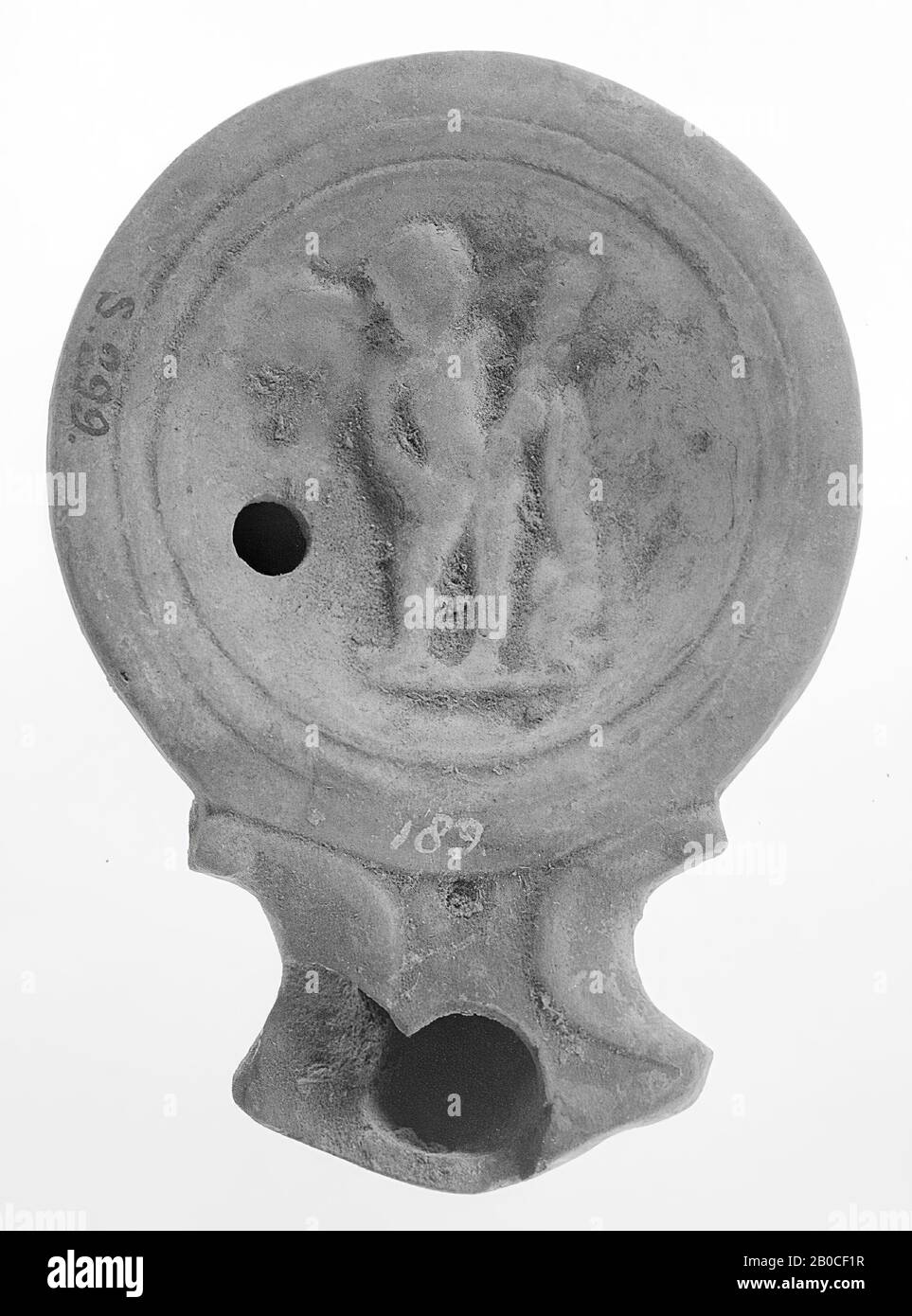 An oil lamp of light red earthenware with a round body. The concave mirror is surrounded by recessed concentric circles and is decorated with a standing Eros with a torch. The small filling hole is to the left of the figure. The short, broad spout is framed with voluten., Oil lamp, earthenware, terracotta, 2.8 x 9.6 x 7 cm, 1st century AD. 1-100, Asia Stock Photohttps://www.alamy.com/image-license-details/?v=1https://www.alamy.com/an-oil-lamp-of-light-red-earthenware-with-a-round-body-the-concave-mirror-is-surrounded-by-recessed-concentric-circles-and-is-decorated-with-a-standing-eros-with-a-torch-the-small-filling-hole-is-to-the-left-of-the-figure-the-short-broad-spout-is-framed-with-voluten-oil-lamp-earthenware-terracotta-28-x-96-x-7-cm-1st-century-ad-1-100-asia-image344482595.html
An oil lamp of light red earthenware with a round body. The concave mirror is surrounded by recessed concentric circles and is decorated with a standing Eros with a torch. The small filling hole is to the left of the figure. The short, broad spout is framed with voluten., Oil lamp, earthenware, terracotta, 2.8 x 9.6 x 7 cm, 1st century AD. 1-100, Asia Stock Photohttps://www.alamy.com/image-license-details/?v=1https://www.alamy.com/an-oil-lamp-of-light-red-earthenware-with-a-round-body-the-concave-mirror-is-surrounded-by-recessed-concentric-circles-and-is-decorated-with-a-standing-eros-with-a-torch-the-small-filling-hole-is-to-the-left-of-the-figure-the-short-broad-spout-is-framed-with-voluten-oil-lamp-earthenware-terracotta-28-x-96-x-7-cm-1st-century-ad-1-100-asia-image344482595.htmlRM2B0CF1R–An oil lamp of light red earthenware with a round body. The concave mirror is surrounded by recessed concentric circles and is decorated with a standing Eros with a torch. The small filling hole is to the left of the figure. The short, broad spout is framed with voluten., Oil lamp, earthenware, terracotta, 2.8 x 9.6 x 7 cm, 1st century AD. 1-100, Asia
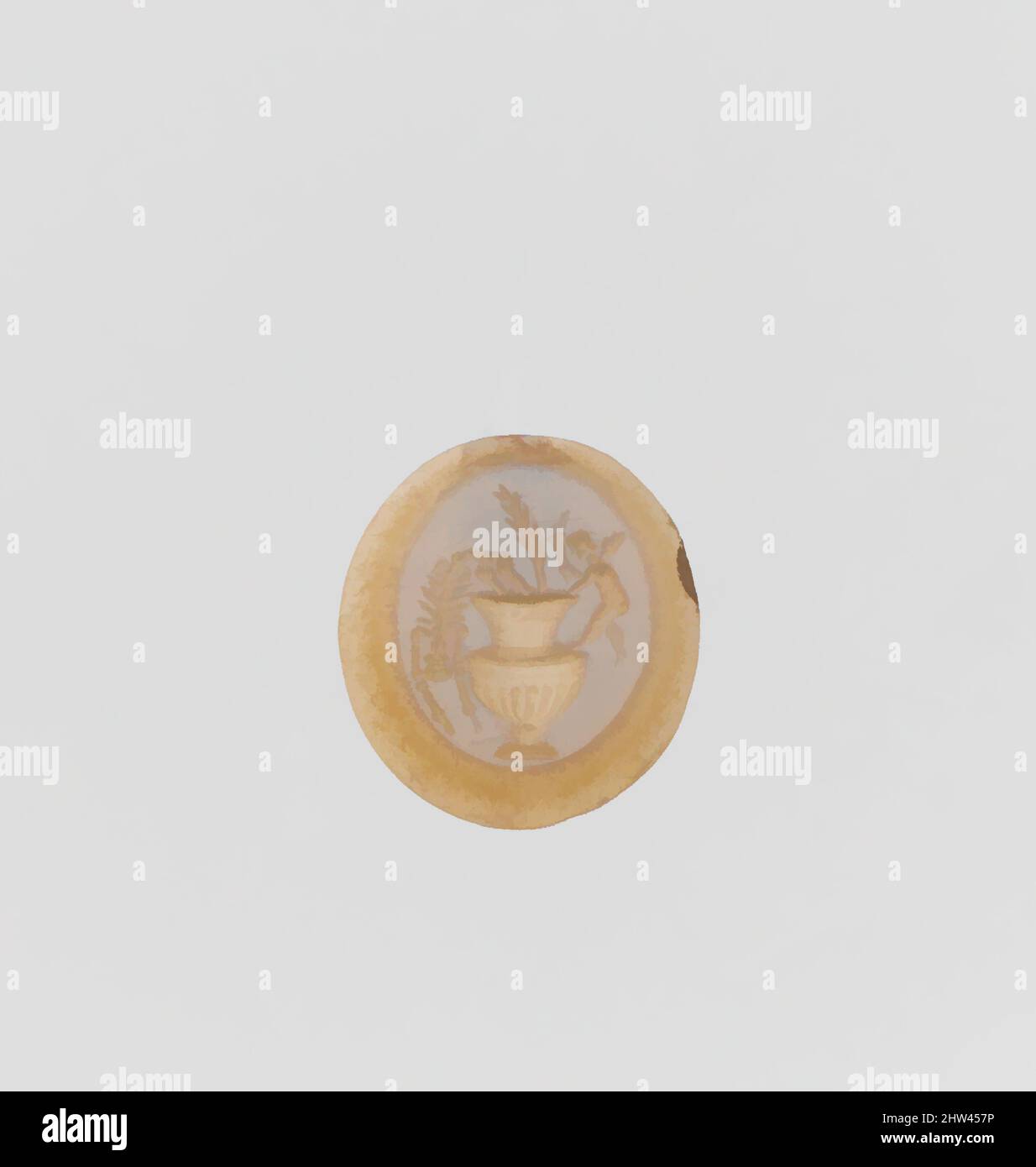 Art inspired by Onyx ring stone, Late Republican or Imperial, ca. 1st century B.C.–3rd century A.D., Roman, Onyx, Length: 1/2 in. (1.2 cm), Gems, Eros with torch, looking into a large vase out of which falls a skeleton Skeletons were popular representations in the Roman period. They, Classic works modernized by Artotop with a splash of modernity. Shapes, color and value, eye-catching visual impact on art. Emotions through freedom of artworks in a contemporary way. A timeless message pursuing a wildly creative new direction. Artists turning to the digital medium and creating the Artotop NFT Stock Photohttps://www.alamy.com/image-license-details/?v=1https://www.alamy.com/art-inspired-by-onyx-ring-stone-late-republican-or-imperial-ca-1st-century-bc3rd-century-ad-roman-onyx-length-12-in-12-cm-gems-eros-with-torch-looking-into-a-large-vase-out-of-which-falls-a-skeleton-skeletons-were-popular-representations-in-the-roman-period-they-classic-works-modernized-by-artotop-with-a-splash-of-modernity-shapes-color-and-value-eye-catching-visual-impact-on-art-emotions-through-freedom-of-artworks-in-a-contemporary-way-a-timeless-message-pursuing-a-wildly-creative-new-direction-artists-turning-to-the-digital-medium-and-creating-the-artotop-nft-image462927914.html
Art inspired by Onyx ring stone, Late Republican or Imperial, ca. 1st century B.C.–3rd century A.D., Roman, Onyx, Length: 1/2 in. (1.2 cm), Gems, Eros with torch, looking into a large vase out of which falls a skeleton Skeletons were popular representations in the Roman period. They, Classic works modernized by Artotop with a splash of modernity. Shapes, color and value, eye-catching visual impact on art. Emotions through freedom of artworks in a contemporary way. A timeless message pursuing a wildly creative new direction. Artists turning to the digital medium and creating the Artotop NFT Stock Photohttps://www.alamy.com/image-license-details/?v=1https://www.alamy.com/art-inspired-by-onyx-ring-stone-late-republican-or-imperial-ca-1st-century-bc3rd-century-ad-roman-onyx-length-12-in-12-cm-gems-eros-with-torch-looking-into-a-large-vase-out-of-which-falls-a-skeleton-skeletons-were-popular-representations-in-the-roman-period-they-classic-works-modernized-by-artotop-with-a-splash-of-modernity-shapes-color-and-value-eye-catching-visual-impact-on-art-emotions-through-freedom-of-artworks-in-a-contemporary-way-a-timeless-message-pursuing-a-wildly-creative-new-direction-artists-turning-to-the-digital-medium-and-creating-the-artotop-nft-image462927914.htmlRF2HW457P–Art inspired by Onyx ring stone, Late Republican or Imperial, ca. 1st century B.C.–3rd century A.D., Roman, Onyx, Length: 1/2 in. (1.2 cm), Gems, Eros with torch, looking into a large vase out of which falls a skeleton Skeletons were popular representations in the Roman period. They, Classic works modernized by Artotop with a splash of modernity. Shapes, color and value, eye-catching visual impact on art. Emotions through freedom of artworks in a contemporary way. A timeless message pursuing a wildly creative new direction. Artists turning to the digital medium and creating the Artotop NFT
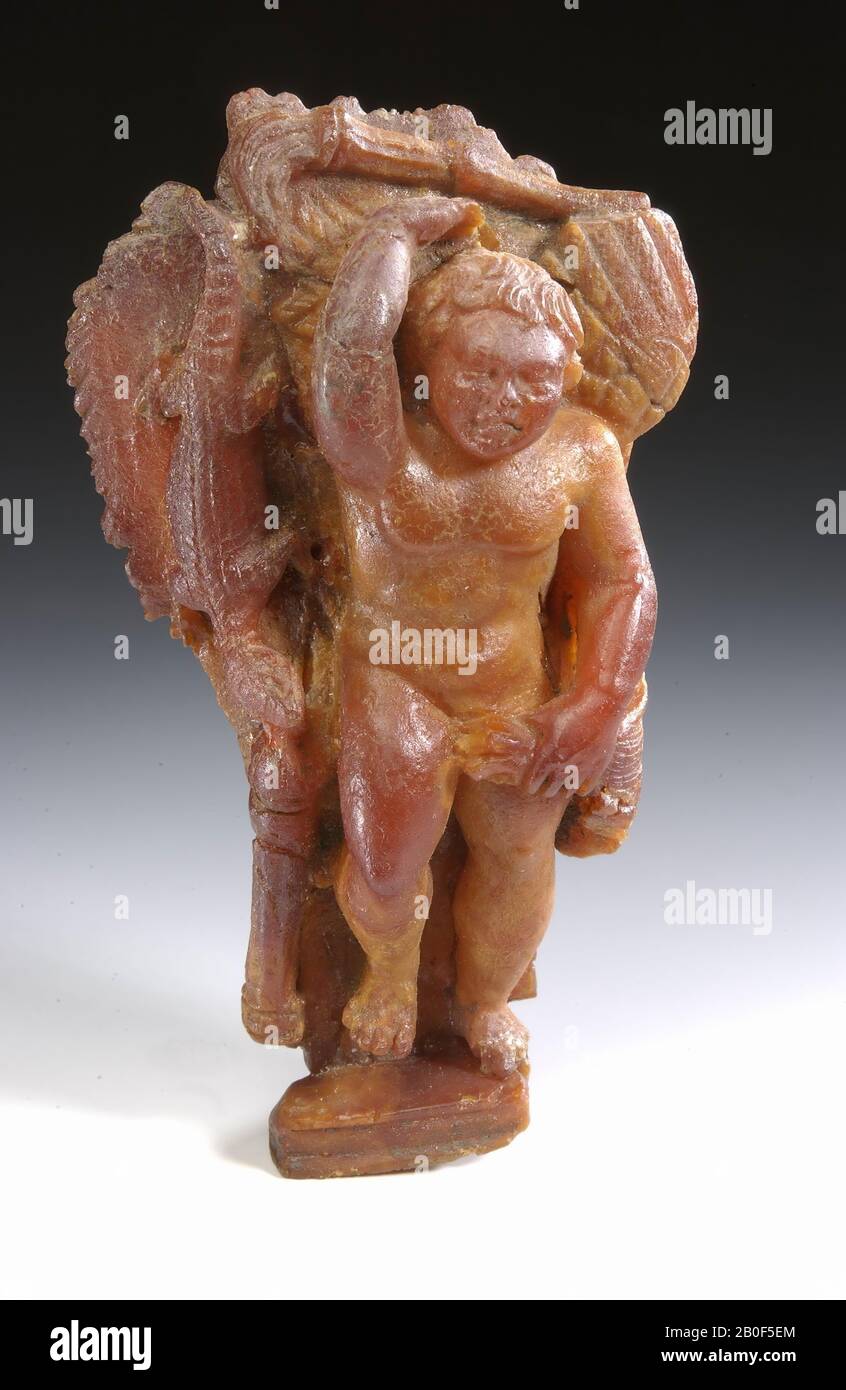 Eros figure of amber on pedestal, wrapped in a lion's skin. Along right leg quiver or 2nd torch, above the head a torch. Lizard along right side. Originating from a grave. Probably manufactured in Northern Italy., Figure, Amor, organic, amber, height: 12 cm, roman 100-200 AD, Netherlands, Limburg, Heerlen, Heerlen, coffin 4 Stock Photohttps://www.alamy.com/image-license-details/?v=1https://www.alamy.com/eros-figure-of-amber-on-pedestal-wrapped-in-a-lions-skin-along-right-leg-quiver-or-2nd-torch-above-the-head-a-torch-lizard-along-right-side-originating-from-a-grave-probably-manufactured-in-northern-italy-figure-amor-organic-amber-height-12-cm-roman-100-200-ad-netherlands-limburg-heerlen-heerlen-coffin-4-image344540972.html
Eros figure of amber on pedestal, wrapped in a lion's skin. Along right leg quiver or 2nd torch, above the head a torch. Lizard along right side. Originating from a grave. Probably manufactured in Northern Italy., Figure, Amor, organic, amber, height: 12 cm, roman 100-200 AD, Netherlands, Limburg, Heerlen, Heerlen, coffin 4 Stock Photohttps://www.alamy.com/image-license-details/?v=1https://www.alamy.com/eros-figure-of-amber-on-pedestal-wrapped-in-a-lions-skin-along-right-leg-quiver-or-2nd-torch-above-the-head-a-torch-lizard-along-right-side-originating-from-a-grave-probably-manufactured-in-northern-italy-figure-amor-organic-amber-height-12-cm-roman-100-200-ad-netherlands-limburg-heerlen-heerlen-coffin-4-image344540972.htmlRM2B0F5EM–Eros figure of amber on pedestal, wrapped in a lion's skin. Along right leg quiver or 2nd torch, above the head a torch. Lizard along right side. Originating from a grave. Probably manufactured in Northern Italy., Figure, Amor, organic, amber, height: 12 cm, roman 100-200 AD, Netherlands, Limburg, Heerlen, Heerlen, coffin 4
 sarcophagus fragment Eros leaning on a reversed torch Mid Imperial Antonine 2nd century A.D Roman16 cm Stock Photohttps://www.alamy.com/image-license-details/?v=1https://www.alamy.com/stock-photo-sarcophagus-fragment-eros-leaning-on-a-reversed-torch-mid-imperial-50939530.html
sarcophagus fragment Eros leaning on a reversed torch Mid Imperial Antonine 2nd century A.D Roman16 cm Stock Photohttps://www.alamy.com/image-license-details/?v=1https://www.alamy.com/stock-photo-sarcophagus-fragment-eros-leaning-on-a-reversed-torch-mid-imperial-50939530.htmlRMCXTDTX–sarcophagus fragment Eros leaning on a reversed torch Mid Imperial Antonine 2nd century A.D Roman16 cm
 the small winged Eros in three-quarter front view seems to carry a chlamys. In his left hand a burning torch. This he holds under a butterfly in his raised right hand., Gem, intaglio, ringstone, glass, Color: orange-red, transparent, Shape: oval, standing, Machining: Maaskant-Kleibrink, M., Catalog of the engraved gems in the Royal Coin Cabinet, 1978, p.60, fig.2, type F1 (?), 14.5 x 13.5 mm. Thickness? mm., Italy, unknown, unknown, unknown Stock Photohttps://www.alamy.com/image-license-details/?v=1https://www.alamy.com/the-small-winged-eros-in-three-quarter-front-view-seems-to-carry-a-chlamys-in-his-left-hand-a-burning-torch-this-he-holds-under-a-butterfly-in-his-raised-right-hand-gem-intaglio-ringstone-glass-color-orange-red-transparent-shape-oval-standing-machining-maaskant-kleibrink-m-catalog-of-the-engraved-gems-in-the-royal-coin-cabinet-1978-p60-fig2-type-f1-145-x-135-mm-thickness-mm-italy-unknown-unknown-unknown-image344489039.html
the small winged Eros in three-quarter front view seems to carry a chlamys. In his left hand a burning torch. This he holds under a butterfly in his raised right hand., Gem, intaglio, ringstone, glass, Color: orange-red, transparent, Shape: oval, standing, Machining: Maaskant-Kleibrink, M., Catalog of the engraved gems in the Royal Coin Cabinet, 1978, p.60, fig.2, type F1 (?), 14.5 x 13.5 mm. Thickness? mm., Italy, unknown, unknown, unknown Stock Photohttps://www.alamy.com/image-license-details/?v=1https://www.alamy.com/the-small-winged-eros-in-three-quarter-front-view-seems-to-carry-a-chlamys-in-his-left-hand-a-burning-torch-this-he-holds-under-a-butterfly-in-his-raised-right-hand-gem-intaglio-ringstone-glass-color-orange-red-transparent-shape-oval-standing-machining-maaskant-kleibrink-m-catalog-of-the-engraved-gems-in-the-royal-coin-cabinet-1978-p60-fig2-type-f1-145-x-135-mm-thickness-mm-italy-unknown-unknown-unknown-image344489039.htmlRM2B0CR7Y–the small winged Eros in three-quarter front view seems to carry a chlamys. In his left hand a burning torch. This he holds under a butterfly in his raised right hand., Gem, intaglio, ringstone, glass, Color: orange-red, transparent, Shape: oval, standing, Machining: Maaskant-Kleibrink, M., Catalog of the engraved gems in the Royal Coin Cabinet, 1978, p.60, fig.2, type F1 (?), 14.5 x 13.5 mm. Thickness? mm., Italy, unknown, unknown, unknown
 Onyx ring stone ca. 1st century B.C.–3rd century A.D. Roman Eros with torch, looking into a large vase out of which falls a skeletonSkeletons were popular representations in the Roman period. They bear out the Epicurean belief that life is short and must be enjoyed while it lasts, for death ends all.. Onyx ring stone. Roman. ca. 1st century B.C.–3rd century A.D.. Onyx. Late Republican or Imperial. Gems Stock Photohttps://www.alamy.com/image-license-details/?v=1https://www.alamy.com/onyx-ring-stone-ca-1st-century-bc3rd-century-ad-roman-eros-with-torch-looking-into-a-large-vase-out-of-which-falls-a-skeletonskeletons-were-popular-representations-in-the-roman-period-they-bear-out-the-epicurean-belief-that-life-is-short-and-must-be-enjoyed-while-it-lasts-for-death-ends-all-onyx-ring-stone-roman-ca-1st-century-bc3rd-century-ad-onyx-late-republican-or-imperial-gems-image458421846.html
Onyx ring stone ca. 1st century B.C.–3rd century A.D. Roman Eros with torch, looking into a large vase out of which falls a skeletonSkeletons were popular representations in the Roman period. They bear out the Epicurean belief that life is short and must be enjoyed while it lasts, for death ends all.. Onyx ring stone. Roman. ca. 1st century B.C.–3rd century A.D.. Onyx. Late Republican or Imperial. Gems Stock Photohttps://www.alamy.com/image-license-details/?v=1https://www.alamy.com/onyx-ring-stone-ca-1st-century-bc3rd-century-ad-roman-eros-with-torch-looking-into-a-large-vase-out-of-which-falls-a-skeletonskeletons-were-popular-representations-in-the-roman-period-they-bear-out-the-epicurean-belief-that-life-is-short-and-must-be-enjoyed-while-it-lasts-for-death-ends-all-onyx-ring-stone-roman-ca-1st-century-bc3rd-century-ad-onyx-late-republican-or-imperial-gems-image458421846.htmlRM2HHPWMP–Onyx ring stone ca. 1st century B.C.–3rd century A.D. Roman Eros with torch, looking into a large vase out of which falls a skeletonSkeletons were popular representations in the Roman period. They bear out the Epicurean belief that life is short and must be enjoyed while it lasts, for death ends all.. Onyx ring stone. Roman. ca. 1st century B.C.–3rd century A.D.. Onyx. Late Republican or Imperial. Gems
 A brown-tinted light with a round body. The round, concave mirror is surrounded by concentric circles and decorated with a relief of Eros with a torch and an obscure object with the small filling hole on the left. The shoulder is decorated with circles. The short, blunt spout is rounded off, has a large fire hole and has a pointy onset with a circle in it. The vertical, ribbon-shaped ear is decorated with notches, oil lamp, earthenware, terracotta, 5.3 x 9.2 x 7.1 cm, 4th and 5th century AD. 300-500, Asia Stock Photohttps://www.alamy.com/image-license-details/?v=1https://www.alamy.com/a-brown-tinted-light-with-a-round-body-the-round-concave-mirror-is-surrounded-by-concentric-circles-and-decorated-with-a-relief-of-eros-with-a-torch-and-an-obscure-object-with-the-small-filling-hole-on-the-left-the-shoulder-is-decorated-with-circles-the-short-blunt-spout-is-rounded-off-has-a-large-fire-hole-and-has-a-pointy-onset-with-a-circle-in-it-the-vertical-ribbon-shaped-ear-is-decorated-with-notches-oil-lamp-earthenware-terracotta-53-x-92-x-71-cm-4th-and-5th-century-ad-300-500-asia-image344544158.html
A brown-tinted light with a round body. The round, concave mirror is surrounded by concentric circles and decorated with a relief of Eros with a torch and an obscure object with the small filling hole on the left. The shoulder is decorated with circles. The short, blunt spout is rounded off, has a large fire hole and has a pointy onset with a circle in it. The vertical, ribbon-shaped ear is decorated with notches, oil lamp, earthenware, terracotta, 5.3 x 9.2 x 7.1 cm, 4th and 5th century AD. 300-500, Asia Stock Photohttps://www.alamy.com/image-license-details/?v=1https://www.alamy.com/a-brown-tinted-light-with-a-round-body-the-round-concave-mirror-is-surrounded-by-concentric-circles-and-decorated-with-a-relief-of-eros-with-a-torch-and-an-obscure-object-with-the-small-filling-hole-on-the-left-the-shoulder-is-decorated-with-circles-the-short-blunt-spout-is-rounded-off-has-a-large-fire-hole-and-has-a-pointy-onset-with-a-circle-in-it-the-vertical-ribbon-shaped-ear-is-decorated-with-notches-oil-lamp-earthenware-terracotta-53-x-92-x-71-cm-4th-and-5th-century-ad-300-500-asia-image344544158.htmlRM2B0F9GE–A brown-tinted light with a round body. The round, concave mirror is surrounded by concentric circles and decorated with a relief of Eros with a torch and an obscure object with the small filling hole on the left. The shoulder is decorated with circles. The short, blunt spout is rounded off, has a large fire hole and has a pointy onset with a circle in it. The vertical, ribbon-shaped ear is decorated with notches, oil lamp, earthenware, terracotta, 5.3 x 9.2 x 7.1 cm, 4th and 5th century AD. 300-500, Asia
 Art inspired by Bronze statuette of Eros running, Early Imperial, 1st–2nd century A.D., Roman, Bronze, H.: 9 1/2 in. (24.1 cm), Bronzes, Eros holds a branch in his right hand and once held a torch in his left, Classic works modernized by Artotop with a splash of modernity. Shapes, color and value, eye-catching visual impact on art. Emotions through freedom of artworks in a contemporary way. A timeless message pursuing a wildly creative new direction. Artists turning to the digital medium and creating the Artotop NFT Stock Photohttps://www.alamy.com/image-license-details/?v=1https://www.alamy.com/art-inspired-by-bronze-statuette-of-eros-running-early-imperial-1st2nd-century-ad-roman-bronze-h-9-12-in-241-cm-bronzes-eros-holds-a-branch-in-his-right-hand-and-once-held-a-torch-in-his-left-classic-works-modernized-by-artotop-with-a-splash-of-modernity-shapes-color-and-value-eye-catching-visual-impact-on-art-emotions-through-freedom-of-artworks-in-a-contemporary-way-a-timeless-message-pursuing-a-wildly-creative-new-direction-artists-turning-to-the-digital-medium-and-creating-the-artotop-nft-image462928986.html
Art inspired by Bronze statuette of Eros running, Early Imperial, 1st–2nd century A.D., Roman, Bronze, H.: 9 1/2 in. (24.1 cm), Bronzes, Eros holds a branch in his right hand and once held a torch in his left, Classic works modernized by Artotop with a splash of modernity. Shapes, color and value, eye-catching visual impact on art. Emotions through freedom of artworks in a contemporary way. A timeless message pursuing a wildly creative new direction. Artists turning to the digital medium and creating the Artotop NFT Stock Photohttps://www.alamy.com/image-license-details/?v=1https://www.alamy.com/art-inspired-by-bronze-statuette-of-eros-running-early-imperial-1st2nd-century-ad-roman-bronze-h-9-12-in-241-cm-bronzes-eros-holds-a-branch-in-his-right-hand-and-once-held-a-torch-in-his-left-classic-works-modernized-by-artotop-with-a-splash-of-modernity-shapes-color-and-value-eye-catching-visual-impact-on-art-emotions-through-freedom-of-artworks-in-a-contemporary-way-a-timeless-message-pursuing-a-wildly-creative-new-direction-artists-turning-to-the-digital-medium-and-creating-the-artotop-nft-image462928986.htmlRF2HW46J2–Art inspired by Bronze statuette of Eros running, Early Imperial, 1st–2nd century A.D., Roman, Bronze, H.: 9 1/2 in. (24.1 cm), Bronzes, Eros holds a branch in his right hand and once held a torch in his left, Classic works modernized by Artotop with a splash of modernity. Shapes, color and value, eye-catching visual impact on art. Emotions through freedom of artworks in a contemporary way. A timeless message pursuing a wildly creative new direction. Artists turning to the digital medium and creating the Artotop NFT
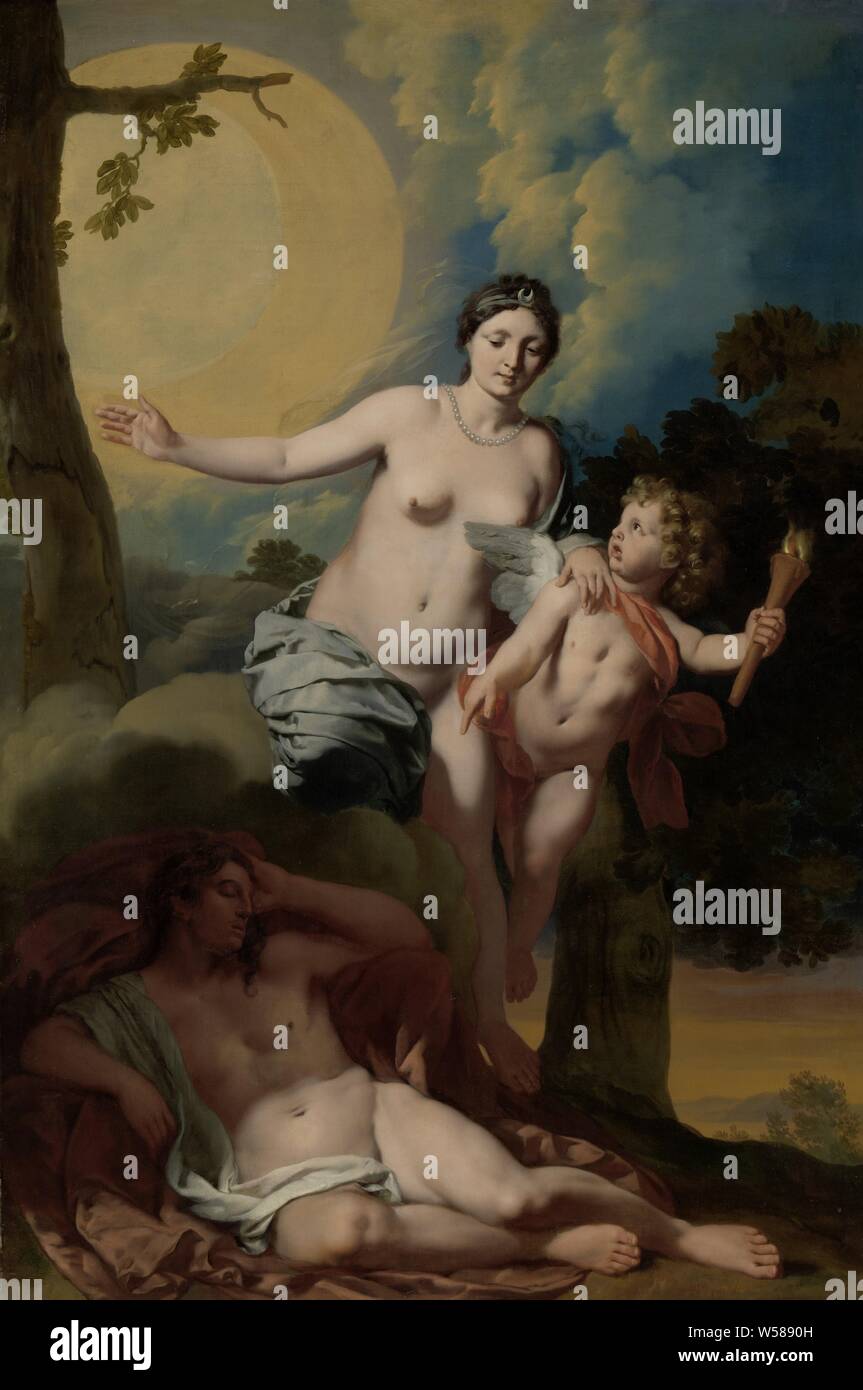 Selene and Endymion, Selene and Endymion. Cupid with a burning torch points Selene (or Diana) to the sleeping Endymion. Behind the moon goddess the moon shines through the clouds, Diana (Luna) visiting the sleeping Endymion, (story of) Cupid, Amor (Eros), full moon, Soestdijk Palace, Maria II Stuart (Queen of England, Scotland and Ireland) ), Gerard de Lairesse, c. 1680, canvas, oil paint (paint), h 177 cm × w 118.5 cm Stock Photohttps://www.alamy.com/image-license-details/?v=1https://www.alamy.com/selene-and-endymion-selene-and-endymion-cupid-with-a-burning-torch-points-selene-or-diana-to-the-sleeping-endymion-behind-the-moon-goddess-the-moon-shines-through-the-clouds-diana-luna-visiting-the-sleeping-endymion-story-of-cupid-amor-eros-full-moon-soestdijk-palace-maria-ii-stuart-queen-of-england-scotland-and-ireland-gerard-de-lairesse-c-1680-canvas-oil-paint-paint-h-177-cm-w-1185-cm-image261411489.html
Selene and Endymion, Selene and Endymion. Cupid with a burning torch points Selene (or Diana) to the sleeping Endymion. Behind the moon goddess the moon shines through the clouds, Diana (Luna) visiting the sleeping Endymion, (story of) Cupid, Amor (Eros), full moon, Soestdijk Palace, Maria II Stuart (Queen of England, Scotland and Ireland) ), Gerard de Lairesse, c. 1680, canvas, oil paint (paint), h 177 cm × w 118.5 cm Stock Photohttps://www.alamy.com/image-license-details/?v=1https://www.alamy.com/selene-and-endymion-selene-and-endymion-cupid-with-a-burning-torch-points-selene-or-diana-to-the-sleeping-endymion-behind-the-moon-goddess-the-moon-shines-through-the-clouds-diana-luna-visiting-the-sleeping-endymion-story-of-cupid-amor-eros-full-moon-soestdijk-palace-maria-ii-stuart-queen-of-england-scotland-and-ireland-gerard-de-lairesse-c-1680-canvas-oil-paint-paint-h-177-cm-w-1185-cm-image261411489.htmlRMW5890H–Selene and Endymion, Selene and Endymion. Cupid with a burning torch points Selene (or Diana) to the sleeping Endymion. Behind the moon goddess the moon shines through the clouds, Diana (Luna) visiting the sleeping Endymion, (story of) Cupid, Amor (Eros), full moon, Soestdijk Palace, Maria II Stuart (Queen of England, Scotland and Ireland) ), Gerard de Lairesse, c. 1680, canvas, oil paint (paint), h 177 cm × w 118.5 cm
 Roman fresco depicting Cupid with a torch and a kantharos. Villa of the Papyri. Herculaneum. National Archaeological Museum. Naples. Italy. Stock Photohttps://www.alamy.com/image-license-details/?v=1https://www.alamy.com/stock-image-roman-fresco-depicting-cupid-with-a-torch-and-a-kantharos-villa-of-168624686.html
Roman fresco depicting Cupid with a torch and a kantharos. Villa of the Papyri. Herculaneum. National Archaeological Museum. Naples. Italy. Stock Photohttps://www.alamy.com/image-license-details/?v=1https://www.alamy.com/stock-image-roman-fresco-depicting-cupid-with-a-torch-and-a-kantharos-villa-of-168624686.htmlRMKP9EE6–Roman fresco depicting Cupid with a torch and a kantharos. Villa of the Papyri. Herculaneum. National Archaeological Museum. Naples. Italy.
 Eros, Greek god of love, with torch, bow and quiver of arrows, standing next to a river. Cupid in Roman mythology. L'Amour. Copperplate engraving by Simon after a design by Etienne-Pierre-Adrien Gois, sculptor to the king, from Sylvain Marechal's Le Pantheon, ou les Figures de la Fable, Chez Simon, 16 rue Pagevin, Paris, 1787. Stock Photohttps://www.alamy.com/image-license-details/?v=1https://www.alamy.com/eros-greek-god-of-love-with-torch-bow-and-quiver-of-arrows-standing-next-to-a-river-cupid-in-roman-mythology-lamour-copperplate-engraving-by-simon-after-a-design-by-etienne-pierre-adrien-gois-sculptor-to-the-king-from-sylvain-marechals-le-pantheon-ou-les-figures-de-la-fable-chez-simon-16-rue-pagevin-paris-1787-image611774703.html
Eros, Greek god of love, with torch, bow and quiver of arrows, standing next to a river. Cupid in Roman mythology. L'Amour. Copperplate engraving by Simon after a design by Etienne-Pierre-Adrien Gois, sculptor to the king, from Sylvain Marechal's Le Pantheon, ou les Figures de la Fable, Chez Simon, 16 rue Pagevin, Paris, 1787. Stock Photohttps://www.alamy.com/image-license-details/?v=1https://www.alamy.com/eros-greek-god-of-love-with-torch-bow-and-quiver-of-arrows-standing-next-to-a-river-cupid-in-roman-mythology-lamour-copperplate-engraving-by-simon-after-a-design-by-etienne-pierre-adrien-gois-sculptor-to-the-king-from-sylvain-marechals-le-pantheon-ou-les-figures-de-la-fable-chez-simon-16-rue-pagevin-paris-1787-image611774703.htmlRM2XF8MTF–Eros, Greek god of love, with torch, bow and quiver of arrows, standing next to a river. Cupid in Roman mythology. L'Amour. Copperplate engraving by Simon after a design by Etienne-Pierre-Adrien Gois, sculptor to the king, from Sylvain Marechal's Le Pantheon, ou les Figures de la Fable, Chez Simon, 16 rue Pagevin, Paris, 1787.
 Art inspired by Terracotta cup with appliqués, Hellenistic, ca. 150–100 B.C., Greek, Pergamene, Terracotta, H. 3 1/8 in. (8 cm); diameter 4 in. (10.2 cm), Vases, Applied decoration: the infant Herakles strangling the snakes, amphora with a lid, Eros holding a torch. Pergamene appliqué, Classic works modernized by Artotop with a splash of modernity. Shapes, color and value, eye-catching visual impact on art. Emotions through freedom of artworks in a contemporary way. A timeless message pursuing a wildly creative new direction. Artists turning to the digital medium and creating the Artotop NFT Stock Photohttps://www.alamy.com/image-license-details/?v=1https://www.alamy.com/art-inspired-by-terracotta-cup-with-appliqus-hellenistic-ca-150100-bc-greek-pergamene-terracotta-h-3-18-in-8-cm-diameter-4-in-102-cm-vases-applied-decoration-the-infant-herakles-strangling-the-snakes-amphora-with-a-lid-eros-holding-a-torch-pergamene-appliqu-classic-works-modernized-by-artotop-with-a-splash-of-modernity-shapes-color-and-value-eye-catching-visual-impact-on-art-emotions-through-freedom-of-artworks-in-a-contemporary-way-a-timeless-message-pursuing-a-wildly-creative-new-direction-artists-turning-to-the-digital-medium-and-creating-the-artotop-nft-image462787701.html
Art inspired by Terracotta cup with appliqués, Hellenistic, ca. 150–100 B.C., Greek, Pergamene, Terracotta, H. 3 1/8 in. (8 cm); diameter 4 in. (10.2 cm), Vases, Applied decoration: the infant Herakles strangling the snakes, amphora with a lid, Eros holding a torch. Pergamene appliqué, Classic works modernized by Artotop with a splash of modernity. Shapes, color and value, eye-catching visual impact on art. Emotions through freedom of artworks in a contemporary way. A timeless message pursuing a wildly creative new direction. Artists turning to the digital medium and creating the Artotop NFT Stock Photohttps://www.alamy.com/image-license-details/?v=1https://www.alamy.com/art-inspired-by-terracotta-cup-with-appliqus-hellenistic-ca-150100-bc-greek-pergamene-terracotta-h-3-18-in-8-cm-diameter-4-in-102-cm-vases-applied-decoration-the-infant-herakles-strangling-the-snakes-amphora-with-a-lid-eros-holding-a-torch-pergamene-appliqu-classic-works-modernized-by-artotop-with-a-splash-of-modernity-shapes-color-and-value-eye-catching-visual-impact-on-art-emotions-through-freedom-of-artworks-in-a-contemporary-way-a-timeless-message-pursuing-a-wildly-creative-new-direction-artists-turning-to-the-digital-medium-and-creating-the-artotop-nft-image462787701.htmlRF2HTWPC5–Art inspired by Terracotta cup with appliqués, Hellenistic, ca. 150–100 B.C., Greek, Pergamene, Terracotta, H. 3 1/8 in. (8 cm); diameter 4 in. (10.2 cm), Vases, Applied decoration: the infant Herakles strangling the snakes, amphora with a lid, Eros holding a torch. Pergamene appliqué, Classic works modernized by Artotop with a splash of modernity. Shapes, color and value, eye-catching visual impact on art. Emotions through freedom of artworks in a contemporary way. A timeless message pursuing a wildly creative new direction. Artists turning to the digital medium and creating the Artotop NFT
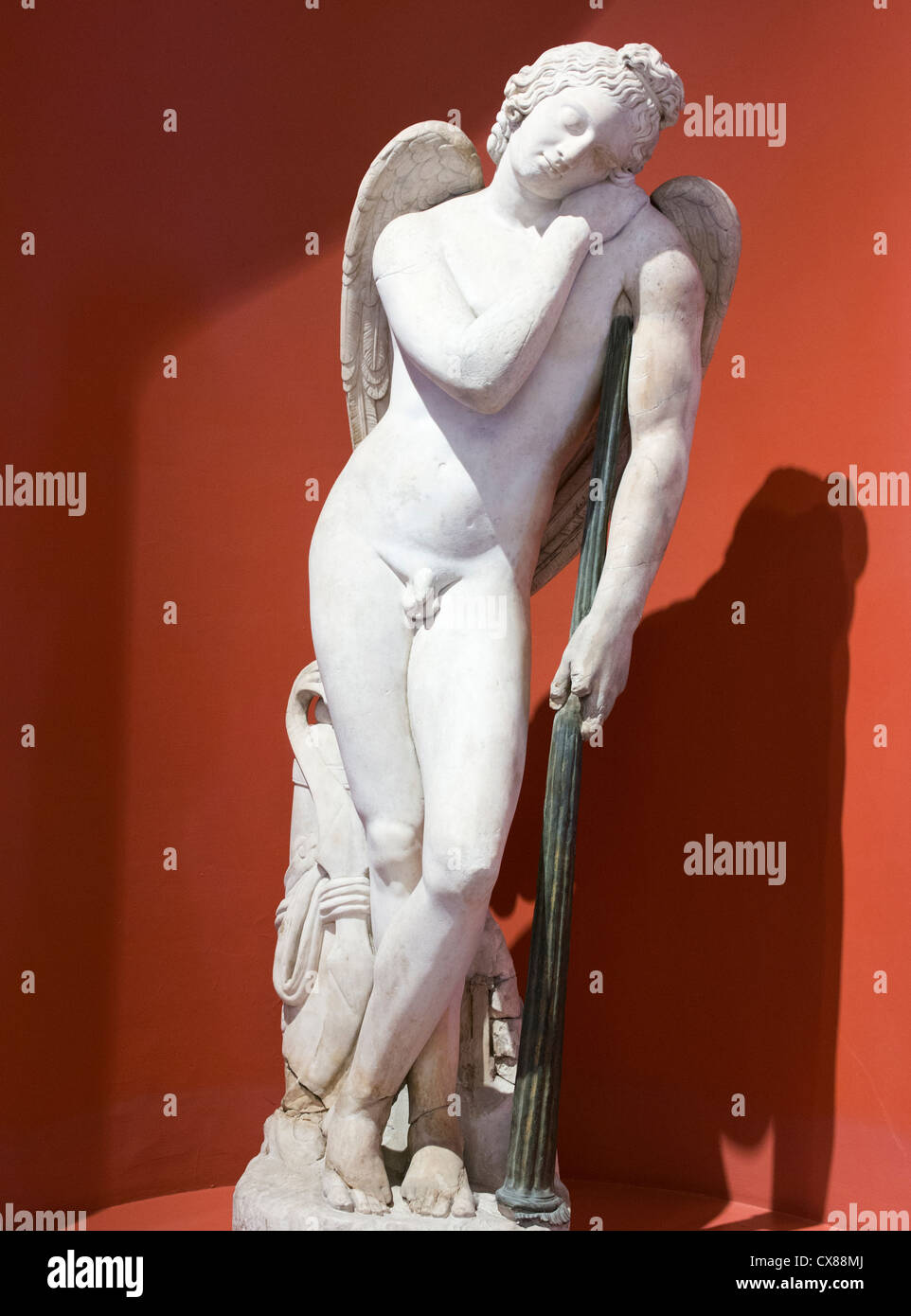 Roman marble statue of Eros, god of lust in the Ashmolean Museum Stock Photohttps://www.alamy.com/image-license-details/?v=1https://www.alamy.com/stock-photo-roman-marble-statue-of-eros-god-of-lust-in-the-ashmolean-museum-50584258.html
Roman marble statue of Eros, god of lust in the Ashmolean Museum Stock Photohttps://www.alamy.com/image-license-details/?v=1https://www.alamy.com/stock-photo-roman-marble-statue-of-eros-god-of-lust-in-the-ashmolean-museum-50584258.htmlRMCX88MJ–Roman marble statue of Eros, god of lust in the Ashmolean Museum
 A golden statue of Eros against a blue sky in Dresden, Saxony, Germany Stock Photohttps://www.alamy.com/image-license-details/?v=1https://www.alamy.com/a-golden-statue-of-eros-against-a-blue-sky-in-dresden-saxony-germany-image479888582.html
A golden statue of Eros against a blue sky in Dresden, Saxony, Germany Stock Photohttps://www.alamy.com/image-license-details/?v=1https://www.alamy.com/a-golden-statue-of-eros-against-a-blue-sky-in-dresden-saxony-germany-image479888582.htmlRF2JTMPNX–A golden statue of Eros against a blue sky in Dresden, Saxony, Germany
 Amor in an ornamental frame Amor with flaming torch and arrow in an ornamental frame, where: in any references to love. Among other couples doves, lo couples and horns of overvloeds. Manufacturer : printmaker: anonymous printmaker: Bernard Picart (rejected attribution) Place manufacture: Netherlands Date: 1683 - 1783 Physical features: etching and engra material: paper Technique: etching / engra (printing process) Dimensions: plate edge: h 225 mm × W 159 mm Subject: (story of) Cupid, Amor (Eros) couple of loversornaments art Stock Photohttps://www.alamy.com/image-license-details/?v=1https://www.alamy.com/amor-in-an-ornamental-frame-amor-with-flaming-torch-and-arrow-in-an-ornamental-frame-where-in-any-references-to-love-among-other-couples-doves-lo-couples-and-horns-of-overvloeds-manufacturer-printmaker-anonymous-printmaker-bernard-picart-rejected-attribution-place-manufacture-netherlands-date-1683-1783-physical-features-etching-and-engra-material-paper-technique-etching-engra-printing-process-dimensions-plate-edge-h-225-mm-w-159-mm-subject-story-of-cupid-amor-eros-couple-of-loversornaments-art-image348133319.html
Amor in an ornamental frame Amor with flaming torch and arrow in an ornamental frame, where: in any references to love. Among other couples doves, lo couples and horns of overvloeds. Manufacturer : printmaker: anonymous printmaker: Bernard Picart (rejected attribution) Place manufacture: Netherlands Date: 1683 - 1783 Physical features: etching and engra material: paper Technique: etching / engra (printing process) Dimensions: plate edge: h 225 mm × W 159 mm Subject: (story of) Cupid, Amor (Eros) couple of loversornaments art Stock Photohttps://www.alamy.com/image-license-details/?v=1https://www.alamy.com/amor-in-an-ornamental-frame-amor-with-flaming-torch-and-arrow-in-an-ornamental-frame-where-in-any-references-to-love-among-other-couples-doves-lo-couples-and-horns-of-overvloeds-manufacturer-printmaker-anonymous-printmaker-bernard-picart-rejected-attribution-place-manufacture-netherlands-date-1683-1783-physical-features-etching-and-engra-material-paper-technique-etching-engra-printing-process-dimensions-plate-edge-h-225-mm-w-159-mm-subject-story-of-cupid-amor-eros-couple-of-loversornaments-art-image348133319.htmlRM2B6ARGR–Amor in an ornamental frame Amor with flaming torch and arrow in an ornamental frame, where: in any references to love. Among other couples doves, lo couples and horns of overvloeds. Manufacturer : printmaker: anonymous printmaker: Bernard Picart (rejected attribution) Place manufacture: Netherlands Date: 1683 - 1783 Physical features: etching and engra material: paper Technique: etching / engra (printing process) Dimensions: plate edge: h 225 mm × W 159 mm Subject: (story of) Cupid, Amor (Eros) couple of loversornaments art
 Three putti with a torch, eagle and arch, anonymous, 1800 - 1900 drawing paper. watercolor (paint). pencil brush (story of) Cupid, Amor (Eros) Stock Photohttps://www.alamy.com/image-license-details/?v=1https://www.alamy.com/three-putti-with-a-torch-eagle-and-arch-anonymous-1800-1900-drawing-paper-watercolor-paint-pencil-brush-story-of-cupid-amor-eros-image595203440.html
Three putti with a torch, eagle and arch, anonymous, 1800 - 1900 drawing paper. watercolor (paint). pencil brush (story of) Cupid, Amor (Eros) Stock Photohttps://www.alamy.com/image-license-details/?v=1https://www.alamy.com/three-putti-with-a-torch-eagle-and-arch-anonymous-1800-1900-drawing-paper-watercolor-paint-pencil-brush-story-of-cupid-amor-eros-image595203440.htmlRM2WG9T1M–Three putti with a torch, eagle and arch, anonymous, 1800 - 1900 drawing paper. watercolor (paint). pencil brush (story of) Cupid, Amor (Eros)
 The nymphs find Eros 'sleeping and trying to turn off Eros' torch Frølich, Lorenz 1820 - 1908 Drawing Egne Optegnelser og Breve til og fra hans Slægt og Venner: I Hundredaaret for Kunstnerens Fødsel samlet og udgivet af F. Hendriksen, Lorenz Frølich, Den græske anthologi er omt pp. 303-309, 6837, (1920-1921). Med Frölichs Tegninger til den græske Anthologi, Sigurd Müller, k2003-555, 1914 Nymferne finder Eros' sovende og forsøger at slukke Eros' fakkel Stock Photohttps://www.alamy.com/image-license-details/?v=1https://www.alamy.com/the-nymphs-find-eros-sleeping-and-trying-to-turn-off-eros-torch-frlich-lorenz-1820-1908-drawing-egne-optegnelser-og-breve-til-og-fra-hans-slgt-og-venner-i-hundredaaret-for-kunstnerens-fdsel-samlet-og-udgivet-af-f-hendriksen-lorenz-frlich-den-grske-anthologi-er-omt-pp-303-309-6837-1920-1921-med-frlichs-tegninger-til-den-grske-anthologi-sigurd-mller-k2003-555-1914-nymferne-finder-eros-sovende-og-forsger-at-slukke-eros-fakkel-image613398010.html
The nymphs find Eros 'sleeping and trying to turn off Eros' torch Frølich, Lorenz 1820 - 1908 Drawing Egne Optegnelser og Breve til og fra hans Slægt og Venner: I Hundredaaret for Kunstnerens Fødsel samlet og udgivet af F. Hendriksen, Lorenz Frølich, Den græske anthologi er omt pp. 303-309, 6837, (1920-1921). Med Frölichs Tegninger til den græske Anthologi, Sigurd Müller, k2003-555, 1914 Nymferne finder Eros' sovende og forsøger at slukke Eros' fakkel Stock Photohttps://www.alamy.com/image-license-details/?v=1https://www.alamy.com/the-nymphs-find-eros-sleeping-and-trying-to-turn-off-eros-torch-frlich-lorenz-1820-1908-drawing-egne-optegnelser-og-breve-til-og-fra-hans-slgt-og-venner-i-hundredaaret-for-kunstnerens-fdsel-samlet-og-udgivet-af-f-hendriksen-lorenz-frlich-den-grske-anthologi-er-omt-pp-303-309-6837-1920-1921-med-frlichs-tegninger-til-den-grske-anthologi-sigurd-mller-k2003-555-1914-nymferne-finder-eros-sovende-og-forsger-at-slukke-eros-fakkel-image613398010.htmlRM2XHXKBP–The nymphs find Eros 'sleeping and trying to turn off Eros' torch Frølich, Lorenz 1820 - 1908 Drawing Egne Optegnelser og Breve til og fra hans Slægt og Venner: I Hundredaaret for Kunstnerens Fødsel samlet og udgivet af F. Hendriksen, Lorenz Frølich, Den græske anthologi er omt pp. 303-309, 6837, (1920-1921). Med Frölichs Tegninger til den græske Anthologi, Sigurd Müller, k2003-555, 1914 Nymferne finder Eros' sovende og forsøger at slukke Eros' fakkel
 Three putti with a torch, eagle and bow, 1800-1900. Stock Photohttps://www.alamy.com/image-license-details/?v=1https://www.alamy.com/three-putti-with-a-torch-eagle-and-bow-1800-1900-image565270405.html
Three putti with a torch, eagle and bow, 1800-1900. Stock Photohttps://www.alamy.com/image-license-details/?v=1https://www.alamy.com/three-putti-with-a-torch-eagle-and-bow-1800-1900-image565270405.htmlRM2RRJ84N–Three putti with a torch, eagle and bow, 1800-1900.
 Glass cameo: Eros holding a torch. Culture: Roman. Dimensions: Length: 5/8 in. (1.6 cm). Date: 1st century B.C.-3rd century A.D.. Eros holding an inverted flaming torch. Museum: Metropolitan Museum of Art, New York, USA. Stock Photohttps://www.alamy.com/image-license-details/?v=1https://www.alamy.com/glass-cameo-eros-holding-a-torch-culture-roman-dimensions-length-58-in-16-cm-date-1st-century-bc-3rd-century-ad-eros-holding-an-inverted-flaming-torch-museum-metropolitan-museum-of-art-new-york-usa-image213260502.html
Glass cameo: Eros holding a torch. Culture: Roman. Dimensions: Length: 5/8 in. (1.6 cm). Date: 1st century B.C.-3rd century A.D.. Eros holding an inverted flaming torch. Museum: Metropolitan Museum of Art, New York, USA. Stock Photohttps://www.alamy.com/image-license-details/?v=1https://www.alamy.com/glass-cameo-eros-holding-a-torch-culture-roman-dimensions-length-58-in-16-cm-date-1st-century-bc-3rd-century-ad-eros-holding-an-inverted-flaming-torch-museum-metropolitan-museum-of-art-new-york-usa-image213260502.htmlRMPAXRXE–Glass cameo: Eros holding a torch. Culture: Roman. Dimensions: Length: 5/8 in. (1.6 cm). Date: 1st century B.C.-3rd century A.D.. Eros holding an inverted flaming torch. Museum: Metropolitan Museum of Art, New York, USA.
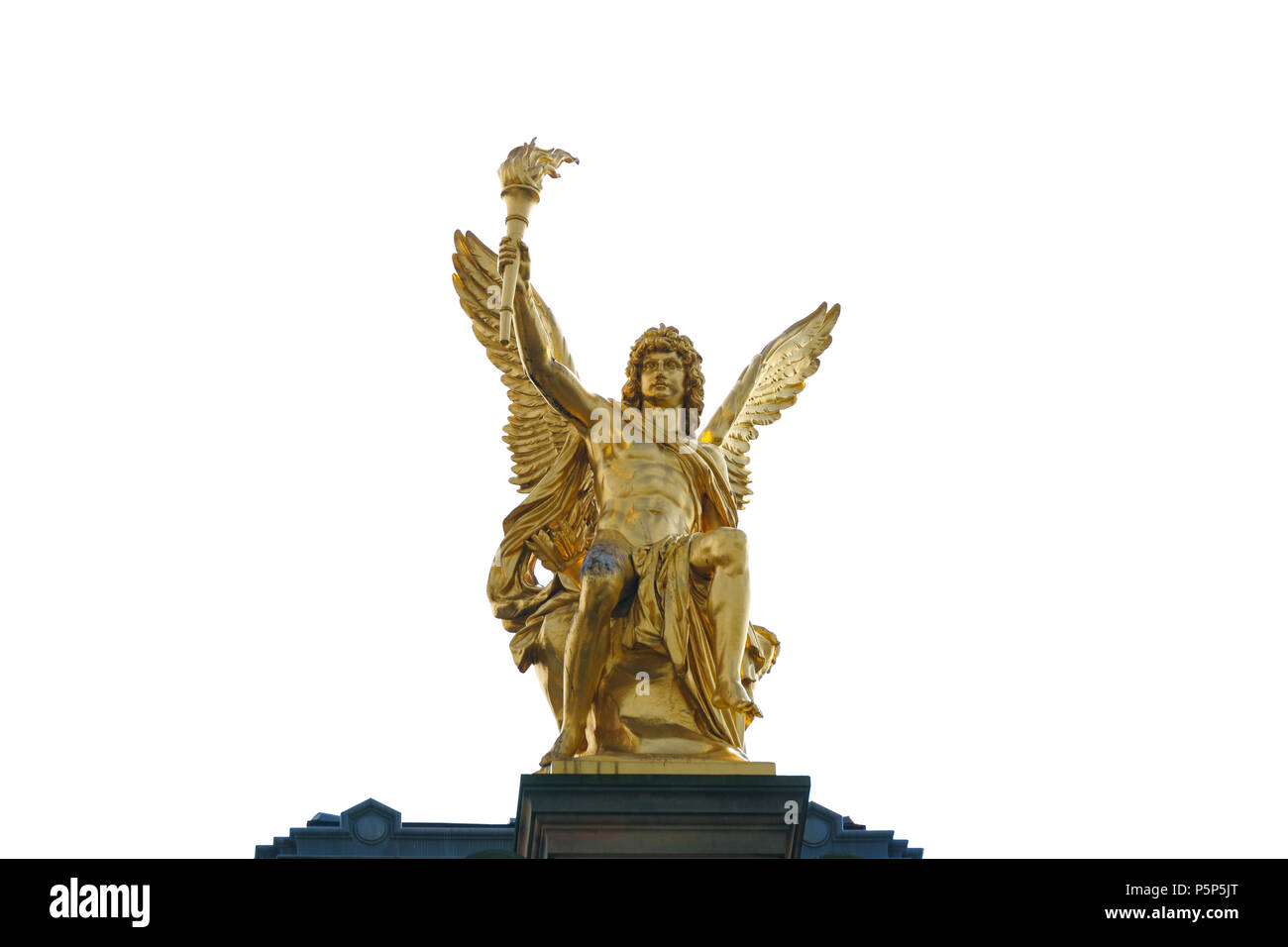 Golden statue of Eros, Dresden, Saxony, Germany isolated on white background. Stock Photohttps://www.alamy.com/image-license-details/?v=1https://www.alamy.com/golden-statue-of-eros-dresden-saxony-germany-isolated-on-white-background-image210085088.html
Golden statue of Eros, Dresden, Saxony, Germany isolated on white background. Stock Photohttps://www.alamy.com/image-license-details/?v=1https://www.alamy.com/golden-statue-of-eros-dresden-saxony-germany-isolated-on-white-background-image210085088.htmlRFP5P5JT–Golden statue of Eros, Dresden, Saxony, Germany isolated on white background.
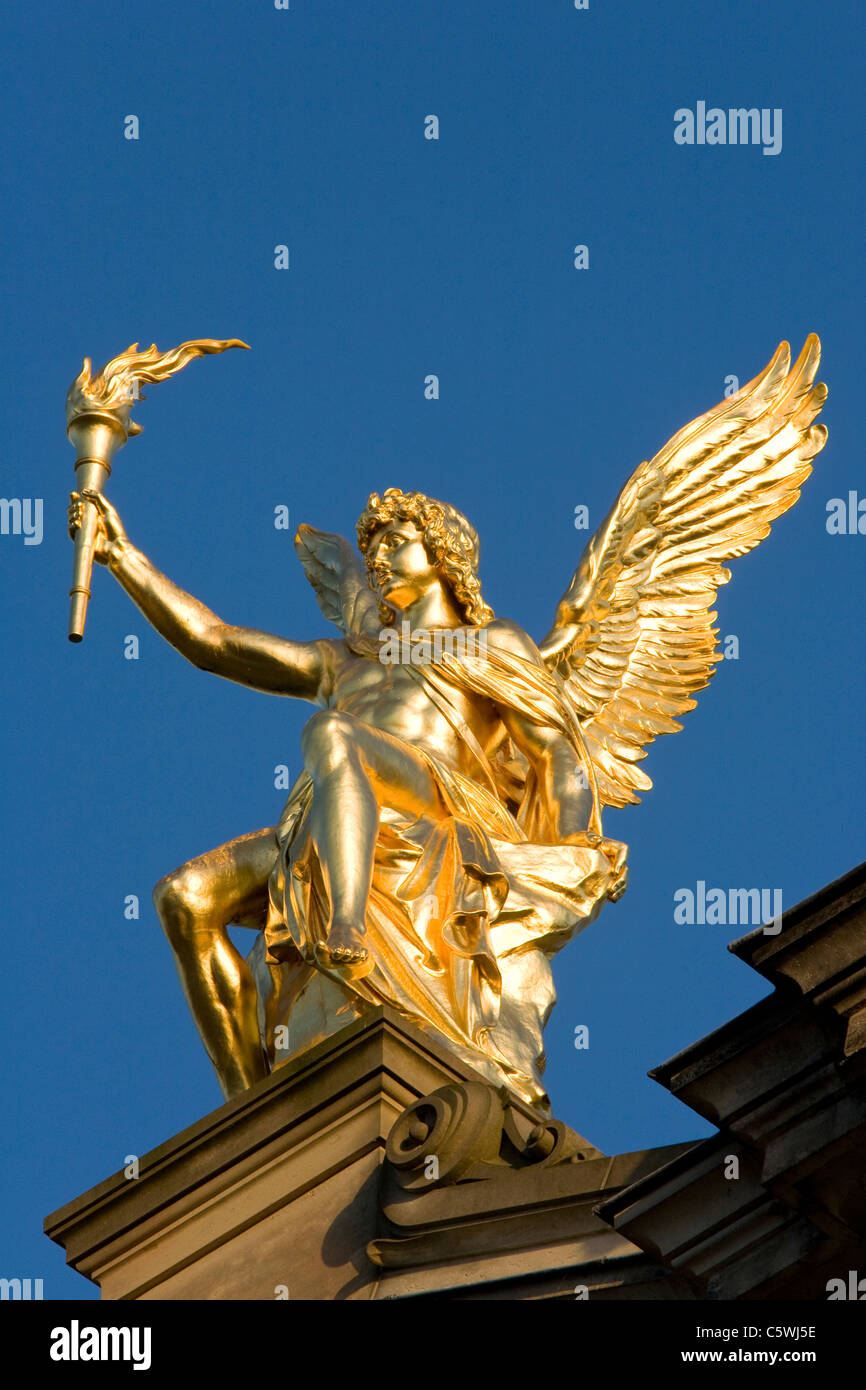 Germany, Dresden, University of Visual Arts, Statue of Eros, close-up Stock Photohttps://www.alamy.com/image-license-details/?v=1https://www.alamy.com/stock-photo-germany-dresden-university-of-visual-arts-statue-of-eros-close-up-38057082.html
Germany, Dresden, University of Visual Arts, Statue of Eros, close-up Stock Photohttps://www.alamy.com/image-license-details/?v=1https://www.alamy.com/stock-photo-germany-dresden-university-of-visual-arts-statue-of-eros-close-up-38057082.htmlRFC5WJ5E–Germany, Dresden, University of Visual Arts, Statue of Eros, close-up
 Cupid character with torch, Valentines Day angel Stock Vectorhttps://www.alamy.com/image-license-details/?v=1https://www.alamy.com/cupid-character-with-torch-valentines-day-angel-image417642055.html
Cupid character with torch, Valentines Day angel Stock Vectorhttps://www.alamy.com/image-license-details/?v=1https://www.alamy.com/cupid-character-with-torch-valentines-day-angel-image417642055.htmlRF2F7D6KK–Cupid character with torch, Valentines Day angel
 Selene and Endymion, Selene and Endymion. Cupid with a burning torch points Selene (or Diana) to the sleeping Endymion. Behind the moon goddess the moon shines through the clouds, Diana (Luna) visiting the sleeping Endymion, (story of) Cupid, Amor (Eros), full moon, Soestdijk Palace, Maria II Stuart (Queen of England, Scotland and Ireland) ), Gerard de Lairesse, c. 1680, canvas, oil paint (paint), h 177 cm × w 118.5 cm, Reimagined by Gibon, design of warm cheerful glowing of brightness and light rays radiance. Classic art reinvented with a modern twist. Photography inspired by futurism, embrac Stock Photohttps://www.alamy.com/image-license-details/?v=1https://www.alamy.com/selene-and-endymion-selene-and-endymion-cupid-with-a-burning-torch-points-selene-or-diana-to-the-sleeping-endymion-behind-the-moon-goddess-the-moon-shines-through-the-clouds-diana-luna-visiting-the-sleeping-endymion-story-of-cupid-amor-eros-full-moon-soestdijk-palace-maria-ii-stuart-queen-of-england-scotland-and-ireland-gerard-de-lairesse-c-1680-canvas-oil-paint-paint-h-177-cm-w-1185-cm-reimagined-by-gibon-design-of-warm-cheerful-glowing-of-brightness-and-light-rays-radiance-classic-art-reinvented-with-a-modern-twist-photography-inspired-by-futurism-embrac-image350015807.html
Selene and Endymion, Selene and Endymion. Cupid with a burning torch points Selene (or Diana) to the sleeping Endymion. Behind the moon goddess the moon shines through the clouds, Diana (Luna) visiting the sleeping Endymion, (story of) Cupid, Amor (Eros), full moon, Soestdijk Palace, Maria II Stuart (Queen of England, Scotland and Ireland) ), Gerard de Lairesse, c. 1680, canvas, oil paint (paint), h 177 cm × w 118.5 cm, Reimagined by Gibon, design of warm cheerful glowing of brightness and light rays radiance. Classic art reinvented with a modern twist. Photography inspired by futurism, embrac Stock Photohttps://www.alamy.com/image-license-details/?v=1https://www.alamy.com/selene-and-endymion-selene-and-endymion-cupid-with-a-burning-torch-points-selene-or-diana-to-the-sleeping-endymion-behind-the-moon-goddess-the-moon-shines-through-the-clouds-diana-luna-visiting-the-sleeping-endymion-story-of-cupid-amor-eros-full-moon-soestdijk-palace-maria-ii-stuart-queen-of-england-scotland-and-ireland-gerard-de-lairesse-c-1680-canvas-oil-paint-paint-h-177-cm-w-1185-cm-reimagined-by-gibon-design-of-warm-cheerful-glowing-of-brightness-and-light-rays-radiance-classic-art-reinvented-with-a-modern-twist-photography-inspired-by-futurism-embrac-image350015807.htmlRF2B9CGMF–Selene and Endymion, Selene and Endymion. Cupid with a burning torch points Selene (or Diana) to the sleeping Endymion. Behind the moon goddess the moon shines through the clouds, Diana (Luna) visiting the sleeping Endymion, (story of) Cupid, Amor (Eros), full moon, Soestdijk Palace, Maria II Stuart (Queen of England, Scotland and Ireland) ), Gerard de Lairesse, c. 1680, canvas, oil paint (paint), h 177 cm × w 118.5 cm, Reimagined by Gibon, design of warm cheerful glowing of brightness and light rays radiance. Classic art reinvented with a modern twist. Photography inspired by futurism, embrac
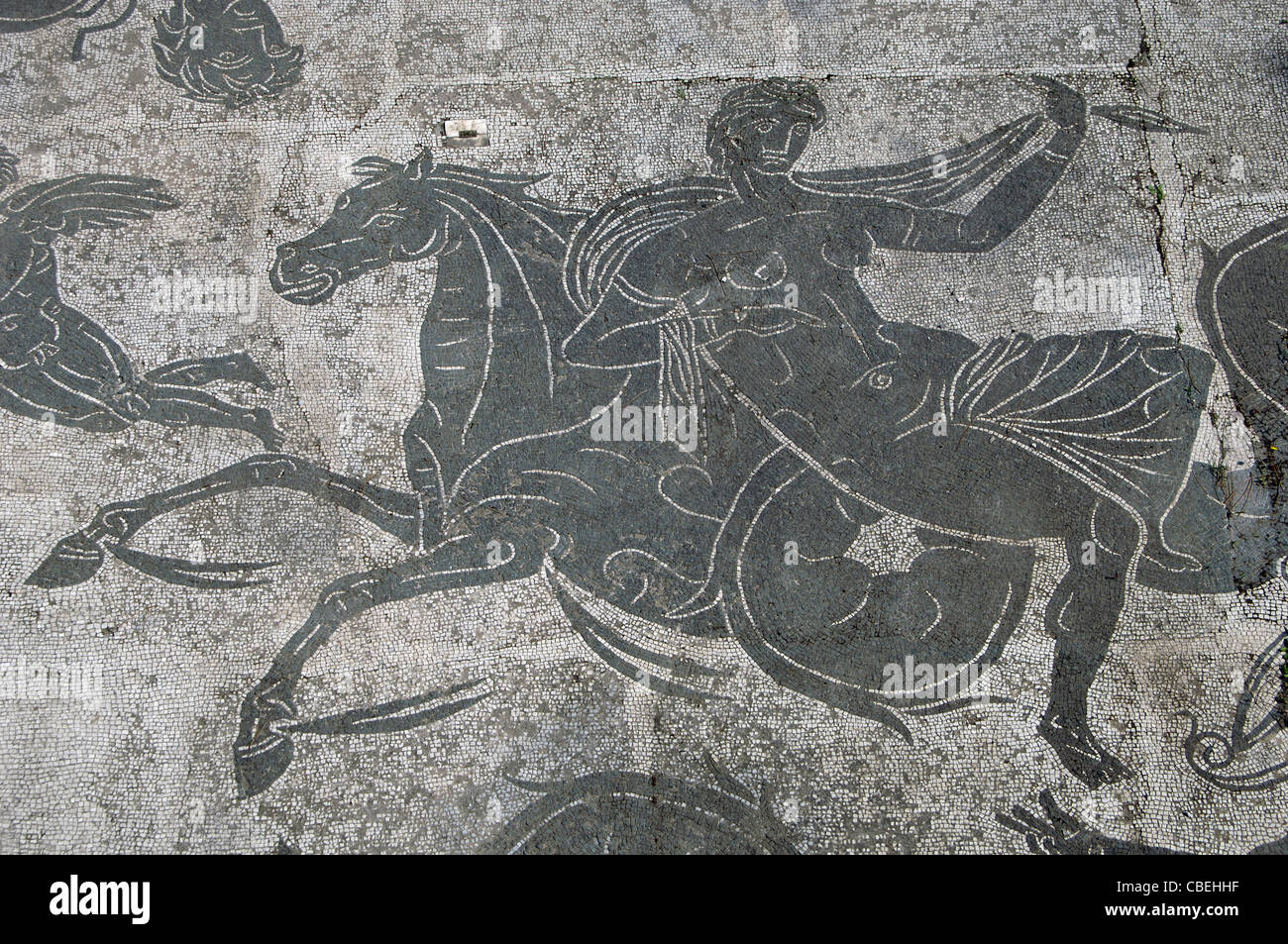 Amphitrite on a hippocampus with Hymenaeus and Tritons. Mosaic at the Baths of Neptune. 2nd century. Ostia Antica. Italy. Stock Photohttps://www.alamy.com/image-license-details/?v=1https://www.alamy.com/stock-photo-amphitrite-on-a-hippocampus-with-hymenaeus-and-tritons-mosaic-at-the-41503099.html
Amphitrite on a hippocampus with Hymenaeus and Tritons. Mosaic at the Baths of Neptune. 2nd century. Ostia Antica. Italy. Stock Photohttps://www.alamy.com/image-license-details/?v=1https://www.alamy.com/stock-photo-amphitrite-on-a-hippocampus-with-hymenaeus-and-tritons-mosaic-at-the-41503099.htmlRMCBEHHF–Amphitrite on a hippocampus with Hymenaeus and Tritons. Mosaic at the Baths of Neptune. 2nd century. Ostia Antica. Italy.
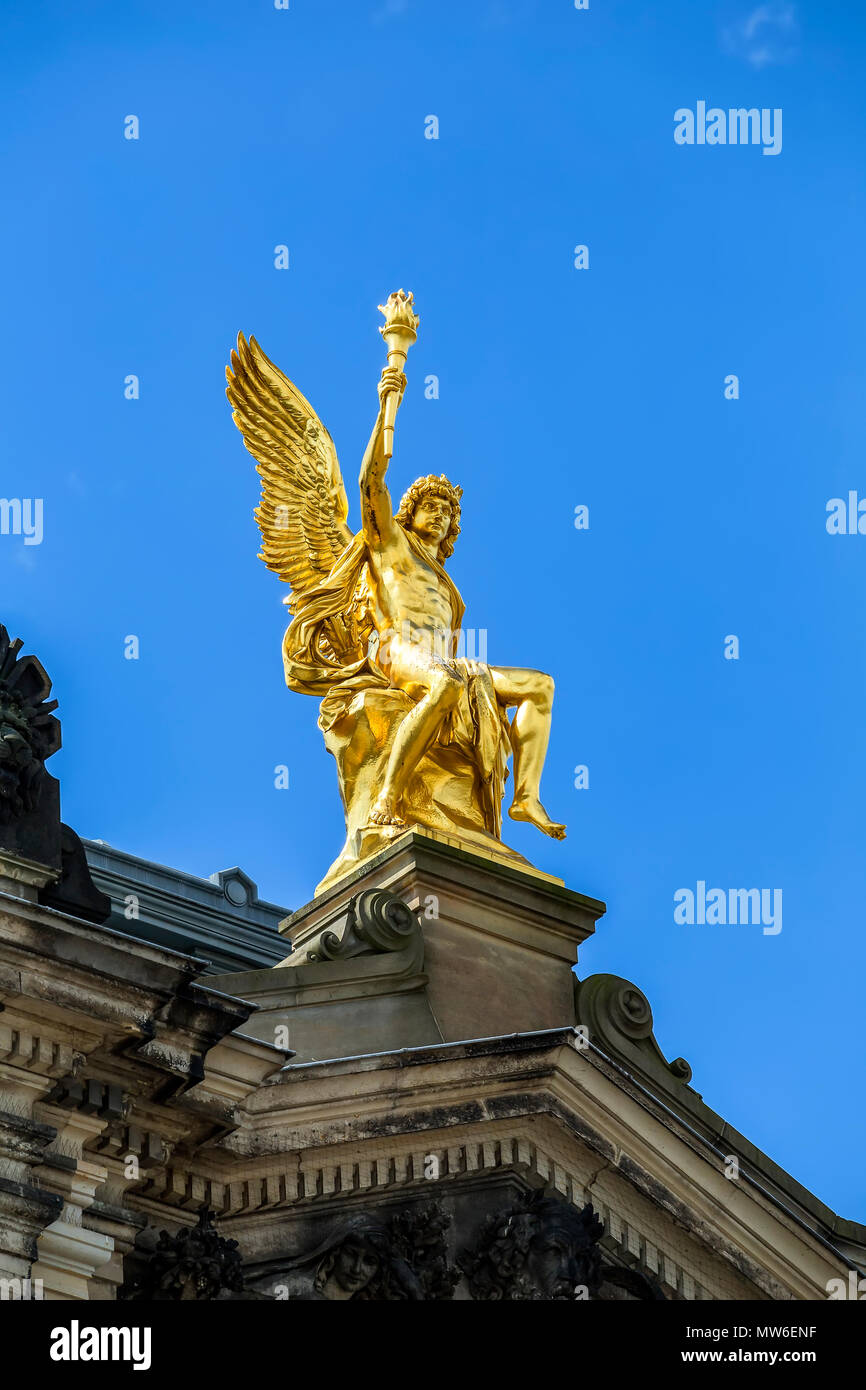 Golden statue of Eros, Dresden, Saxony, Germany Stock Photohttps://www.alamy.com/image-license-details/?v=1https://www.alamy.com/golden-statue-of-eros-dresden-saxony-germany-image187613371.html
Golden statue of Eros, Dresden, Saxony, Germany Stock Photohttps://www.alamy.com/image-license-details/?v=1https://www.alamy.com/golden-statue-of-eros-dresden-saxony-germany-image187613371.htmlRFMW6ENF–Golden statue of Eros, Dresden, Saxony, Germany
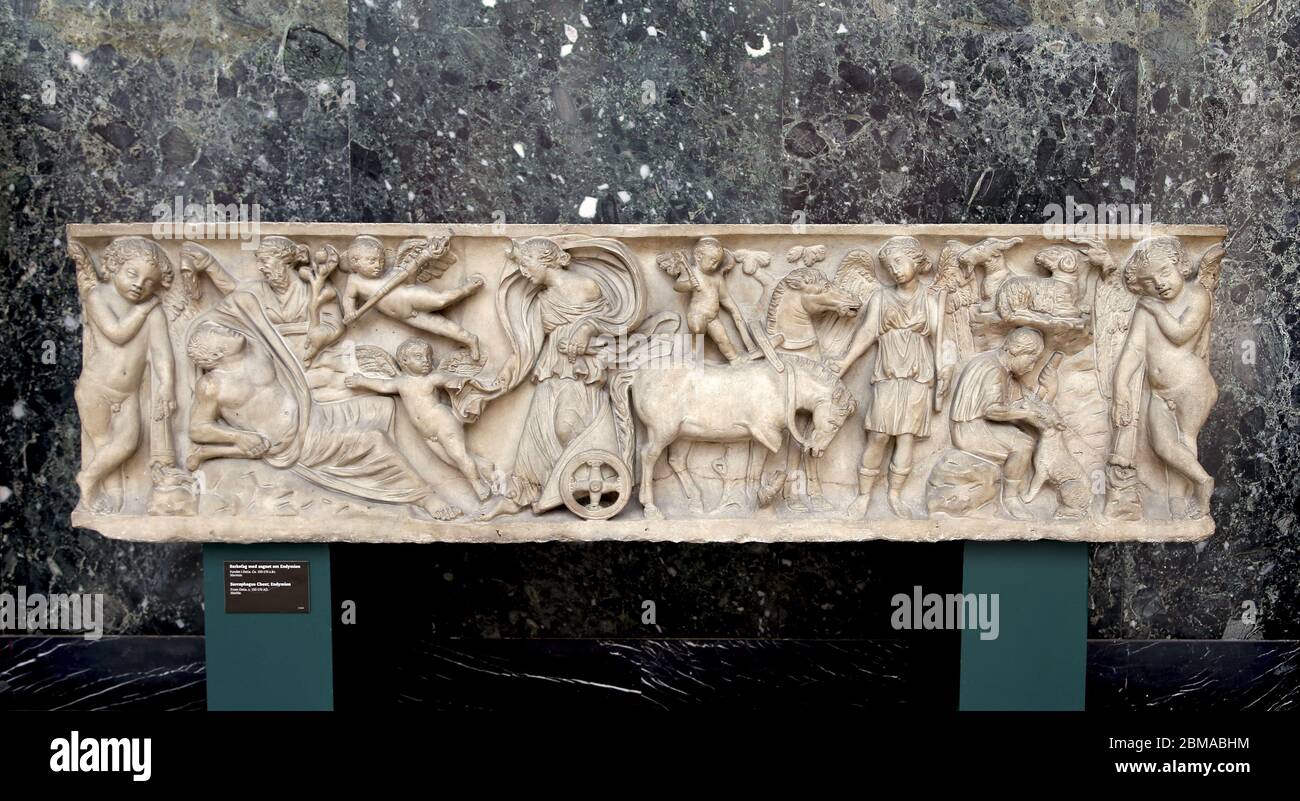 Roman sarcophagus with Endymion and Selene (150-170 AD). Marble relief from Ostia. NY Carlsberg Glyptotek, Copenhagen, Denmark. Stock Photohttps://www.alamy.com/image-license-details/?v=1https://www.alamy.com/roman-sarcophagus-with-endymion-and-selene-150-170-ad-marble-relief-from-ostia-ny-carlsberg-glyptotek-copenhagen-denmark-image356729120.html
Roman sarcophagus with Endymion and Selene (150-170 AD). Marble relief from Ostia. NY Carlsberg Glyptotek, Copenhagen, Denmark. Stock Photohttps://www.alamy.com/image-license-details/?v=1https://www.alamy.com/roman-sarcophagus-with-endymion-and-selene-150-170-ad-marble-relief-from-ostia-ny-carlsberg-glyptotek-copenhagen-denmark-image356729120.htmlRM2BMABHM–Roman sarcophagus with Endymion and Selene (150-170 AD). Marble relief from Ostia. NY Carlsberg Glyptotek, Copenhagen, Denmark.
 Roman sculpture from Augustus to Constantine . ucius Lucilius Felix in the Capitoline Museum (Helbig,440; Altmann, 105),! on seven sides of which is repre-sented a robust Donatellesque Eros, the eighth side beingtaken up by the inscription. One Eros plays the doubleflute, a second the simple pipe, a third the cithara,while two of their companions, holding torches orwreaths, dance to the tune. Again, one little fellow isbusy negotiating a torch taller than himself, while theseventh, closely wrapped up in his filmy cloak, his headstill crowned with the festal wreath, has left the gaythiasos and Stock Photohttps://www.alamy.com/image-license-details/?v=1https://www.alamy.com/roman-sculpture-from-augustus-to-constantine-ucius-lucilius-felix-in-the-capitoline-museum-helbig440-altmann-105!-on-seven-sides-of-which-is-repre-sented-a-robust-donatellesque-eros-the-eighth-side-beingtaken-up-by-the-inscription-one-eros-plays-the-doubleflute-a-second-the-simple-pipe-a-third-the-citharawhile-two-of-their-companions-holding-torches-orwreaths-dance-to-the-tune-again-one-little-fellow-isbusy-negotiating-a-torch-taller-than-himself-while-theseventh-closely-wrapped-up-in-his-filmy-cloak-his-headstill-crowned-with-the-festal-wreath-has-left-the-gaythiasos-and-image340101565.html
Roman sculpture from Augustus to Constantine . ucius Lucilius Felix in the Capitoline Museum (Helbig,440; Altmann, 105),! on seven sides of which is repre-sented a robust Donatellesque Eros, the eighth side beingtaken up by the inscription. One Eros plays the doubleflute, a second the simple pipe, a third the cithara,while two of their companions, holding torches orwreaths, dance to the tune. Again, one little fellow isbusy negotiating a torch taller than himself, while theseventh, closely wrapped up in his filmy cloak, his headstill crowned with the festal wreath, has left the gaythiasos and Stock Photohttps://www.alamy.com/image-license-details/?v=1https://www.alamy.com/roman-sculpture-from-augustus-to-constantine-ucius-lucilius-felix-in-the-capitoline-museum-helbig440-altmann-105!-on-seven-sides-of-which-is-repre-sented-a-robust-donatellesque-eros-the-eighth-side-beingtaken-up-by-the-inscription-one-eros-plays-the-doubleflute-a-second-the-simple-pipe-a-third-the-citharawhile-two-of-their-companions-holding-torches-orwreaths-dance-to-the-tune-again-one-little-fellow-isbusy-negotiating-a-torch-taller-than-himself-while-theseventh-closely-wrapped-up-in-his-filmy-cloak-his-headstill-crowned-with-the-festal-wreath-has-left-the-gaythiasos-and-image340101565.htmlRM2AN8Y0D–Roman sculpture from Augustus to Constantine . ucius Lucilius Felix in the Capitoline Museum (Helbig,440; Altmann, 105),! on seven sides of which is repre-sented a robust Donatellesque Eros, the eighth side beingtaken up by the inscription. One Eros plays the doubleflute, a second the simple pipe, a third the cithara,while two of their companions, holding torches orwreaths, dance to the tune. Again, one little fellow isbusy negotiating a torch taller than himself, while theseventh, closely wrapped up in his filmy cloak, his headstill crowned with the festal wreath, has left the gaythiasos and
 Sleeping Amor Non ti fidar che mai non dorme Amore / egg chiude gli occhi allor che insidia un core (title on object), The sleeping Amor in a landscape. Behind him lies a burning torch. In the foreground are his arrows and bow, a painter's palette with brushes and a laurel wreath., Sleeping, unconsciousness, (story of) Cupid, Amor (Eros), sleeping Cupid, possibly signifying a slackening of Love's influence, Mauro Gandolfi (mentioned on object), 1820, paper, engraving, h 346 mm × w 376 mm Stock Photohttps://www.alamy.com/image-license-details/?v=1https://www.alamy.com/sleeping-amor-non-ti-fidar-che-mai-non-dorme-amore-egg-chiude-gli-occhi-allor-che-insidia-un-core-title-on-object-the-sleeping-amor-in-a-landscape-behind-him-lies-a-burning-torch-in-the-foreground-are-his-arrows-and-bow-a-painters-palette-with-brushes-and-a-laurel-wreath-sleeping-unconsciousness-story-of-cupid-amor-eros-sleeping-cupid-possibly-signifying-a-slackening-of-loves-influence-mauro-gandolfi-mentioned-on-object-1820-paper-engraving-h-346-mm-w-376-mm-image261403876.html
Sleeping Amor Non ti fidar che mai non dorme Amore / egg chiude gli occhi allor che insidia un core (title on object), The sleeping Amor in a landscape. Behind him lies a burning torch. In the foreground are his arrows and bow, a painter's palette with brushes and a laurel wreath., Sleeping, unconsciousness, (story of) Cupid, Amor (Eros), sleeping Cupid, possibly signifying a slackening of Love's influence, Mauro Gandolfi (mentioned on object), 1820, paper, engraving, h 346 mm × w 376 mm Stock Photohttps://www.alamy.com/image-license-details/?v=1https://www.alamy.com/sleeping-amor-non-ti-fidar-che-mai-non-dorme-amore-egg-chiude-gli-occhi-allor-che-insidia-un-core-title-on-object-the-sleeping-amor-in-a-landscape-behind-him-lies-a-burning-torch-in-the-foreground-are-his-arrows-and-bow-a-painters-palette-with-brushes-and-a-laurel-wreath-sleeping-unconsciousness-story-of-cupid-amor-eros-sleeping-cupid-possibly-signifying-a-slackening-of-loves-influence-mauro-gandolfi-mentioned-on-object-1820-paper-engraving-h-346-mm-w-376-mm-image261403876.htmlRMW57Y8M–Sleeping Amor Non ti fidar che mai non dorme Amore / egg chiude gli occhi allor che insidia un core (title on object), The sleeping Amor in a landscape. Behind him lies a burning torch. In the foreground are his arrows and bow, a painter's palette with brushes and a laurel wreath., Sleeping, unconsciousness, (story of) Cupid, Amor (Eros), sleeping Cupid, possibly signifying a slackening of Love's influence, Mauro Gandolfi (mentioned on object), 1820, paper, engraving, h 346 mm × w 376 mm
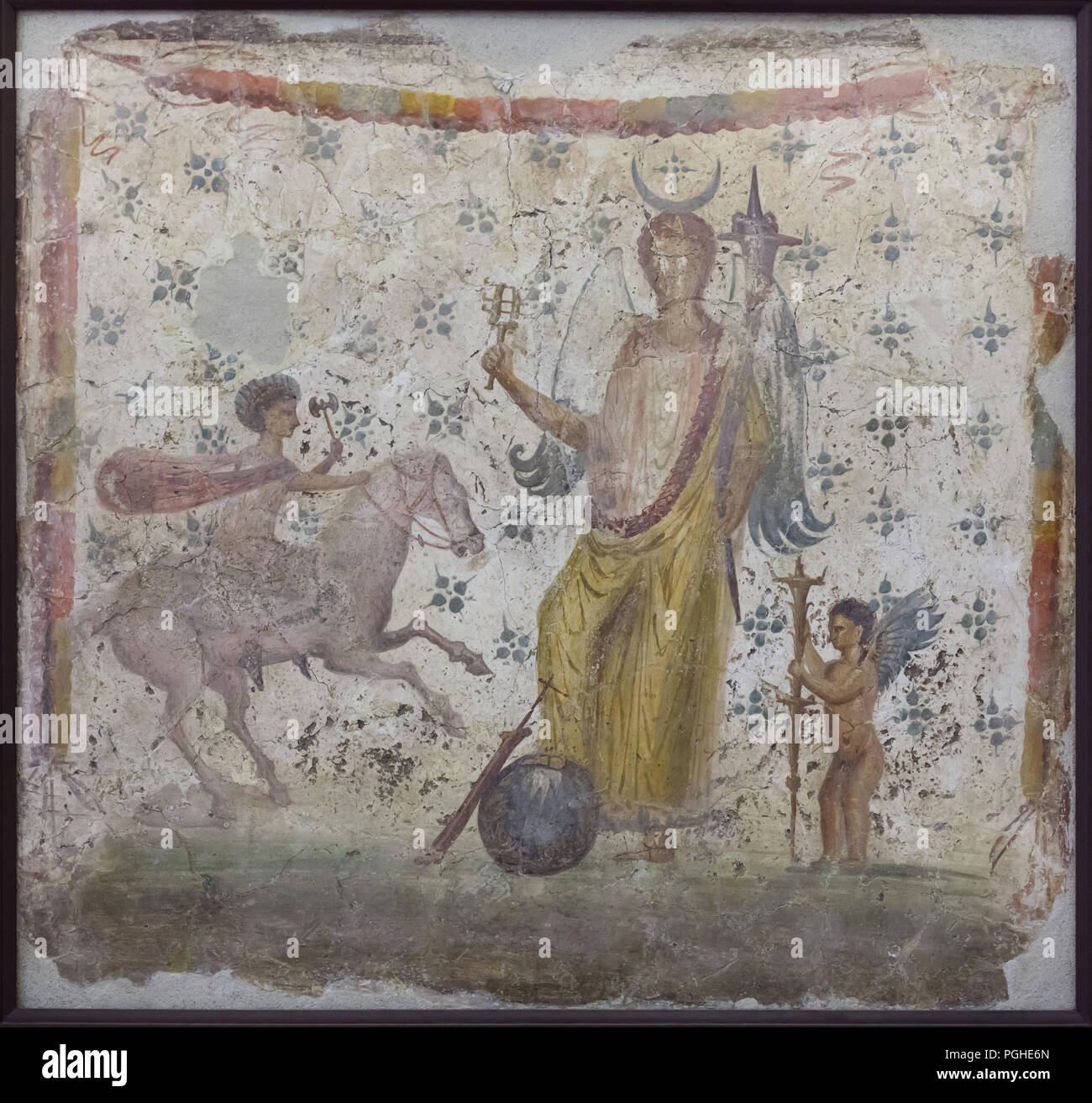 Isis Fortuna with Harpocrates and Cupid depicted in the Roman fresco from Pompeii (62-79 AD), now on display in the National Archaeological Museum (Museo Archeologico Nazionale di Napoli) in Naples, Campania, Italy. Isis Fortuna is depicted with the cornucopia of abundance of abundance, the sistrum (Roman musical instrument) and the globe (symbol of the uncertainties of human fortune). Stock Photohttps://www.alamy.com/image-license-details/?v=1https://www.alamy.com/isis-fortuna-with-harpocrates-and-cupid-depicted-in-the-roman-fresco-from-pompeii-62-79-ad-now-on-display-in-the-national-archaeological-museum-museo-archeologico-nazionale-di-napoli-in-naples-campania-italy-isis-fortuna-is-depicted-with-the-cornucopia-of-abundance-of-abundance-the-sistrum-roman-musical-instrument-and-the-globe-symbol-of-the-uncertainties-of-human-fortune-image216743261.html
Isis Fortuna with Harpocrates and Cupid depicted in the Roman fresco from Pompeii (62-79 AD), now on display in the National Archaeological Museum (Museo Archeologico Nazionale di Napoli) in Naples, Campania, Italy. Isis Fortuna is depicted with the cornucopia of abundance of abundance, the sistrum (Roman musical instrument) and the globe (symbol of the uncertainties of human fortune). Stock Photohttps://www.alamy.com/image-license-details/?v=1https://www.alamy.com/isis-fortuna-with-harpocrates-and-cupid-depicted-in-the-roman-fresco-from-pompeii-62-79-ad-now-on-display-in-the-national-archaeological-museum-museo-archeologico-nazionale-di-napoli-in-naples-campania-italy-isis-fortuna-is-depicted-with-the-cornucopia-of-abundance-of-abundance-the-sistrum-roman-musical-instrument-and-the-globe-symbol-of-the-uncertainties-of-human-fortune-image216743261.htmlRMPGHE6N–Isis Fortuna with Harpocrates and Cupid depicted in the Roman fresco from Pompeii (62-79 AD), now on display in the National Archaeological Museum (Museo Archeologico Nazionale di Napoli) in Naples, Campania, Italy. Isis Fortuna is depicted with the cornucopia of abundance of abundance, the sistrum (Roman musical instrument) and the globe (symbol of the uncertainties of human fortune).
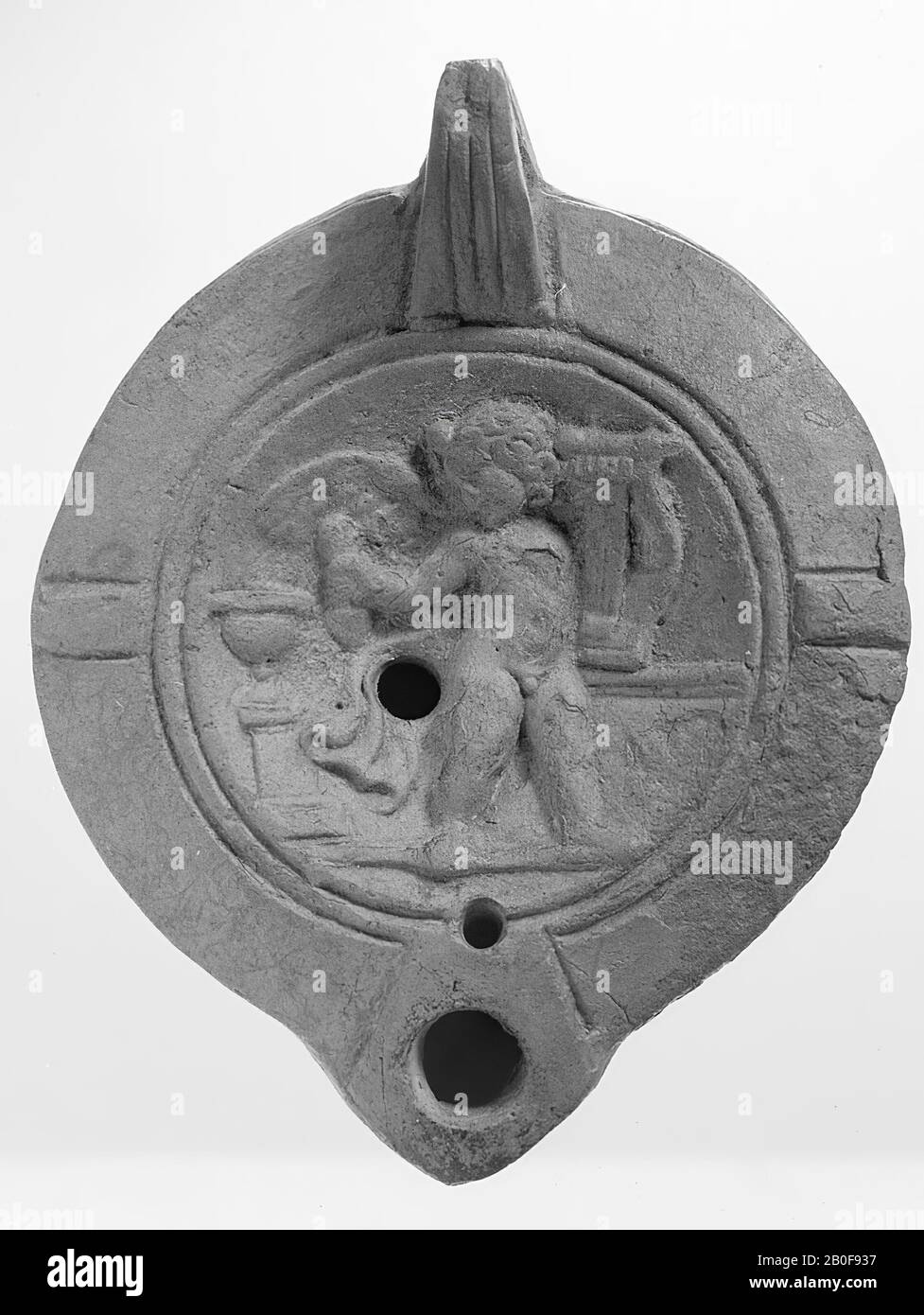 A lamp of light red earthenware with a round body. The round, hollow mirror is surrounded by concentric circles and decorated with a relief of Eros with a torch and harp, in the background a column with crater. The small filling hole on the left of Eros. The short spout is round closed, has a large fire hole and has a pointy onset with a small hole above it. The vertically attached ear is pierced with a small hole and decorated with notches. A wash on both sides of the shoulder. Brand: unreadable (by sticker) inscription, oil lamp, earthenware, terracotta, 4,8 x 11,6 x 9 cm, 4th and 5th Stock Photohttps://www.alamy.com/image-license-details/?v=1https://www.alamy.com/a-lamp-of-light-red-earthenware-with-a-round-body-the-round-hollow-mirror-is-surrounded-by-concentric-circles-and-decorated-with-a-relief-of-eros-with-a-torch-and-harp-in-the-background-a-column-with-crater-the-small-filling-hole-on-the-left-of-eros-the-short-spout-is-round-closed-has-a-large-fire-hole-and-has-a-pointy-onset-with-a-small-hole-above-it-the-vertically-attached-ear-is-pierced-with-a-small-hole-and-decorated-with-notches-a-wash-on-both-sides-of-the-shoulder-brand-unreadable-by-sticker-inscription-oil-lamp-earthenware-terracotta-48-x-116-x-9-cm-4th-and-5th-image344543787.html
A lamp of light red earthenware with a round body. The round, hollow mirror is surrounded by concentric circles and decorated with a relief of Eros with a torch and harp, in the background a column with crater. The small filling hole on the left of Eros. The short spout is round closed, has a large fire hole and has a pointy onset with a small hole above it. The vertically attached ear is pierced with a small hole and decorated with notches. A wash on both sides of the shoulder. Brand: unreadable (by sticker) inscription, oil lamp, earthenware, terracotta, 4,8 x 11,6 x 9 cm, 4th and 5th Stock Photohttps://www.alamy.com/image-license-details/?v=1https://www.alamy.com/a-lamp-of-light-red-earthenware-with-a-round-body-the-round-hollow-mirror-is-surrounded-by-concentric-circles-and-decorated-with-a-relief-of-eros-with-a-torch-and-harp-in-the-background-a-column-with-crater-the-small-filling-hole-on-the-left-of-eros-the-short-spout-is-round-closed-has-a-large-fire-hole-and-has-a-pointy-onset-with-a-small-hole-above-it-the-vertically-attached-ear-is-pierced-with-a-small-hole-and-decorated-with-notches-a-wash-on-both-sides-of-the-shoulder-brand-unreadable-by-sticker-inscription-oil-lamp-earthenware-terracotta-48-x-116-x-9-cm-4th-and-5th-image344543787.htmlRM2B0F937–A lamp of light red earthenware with a round body. The round, hollow mirror is surrounded by concentric circles and decorated with a relief of Eros with a torch and harp, in the background a column with crater. The small filling hole on the left of Eros. The short spout is round closed, has a large fire hole and has a pointy onset with a small hole above it. The vertically attached ear is pierced with a small hole and decorated with notches. A wash on both sides of the shoulder. Brand: unreadable (by sticker) inscription, oil lamp, earthenware, terracotta, 4,8 x 11,6 x 9 cm, 4th and 5th
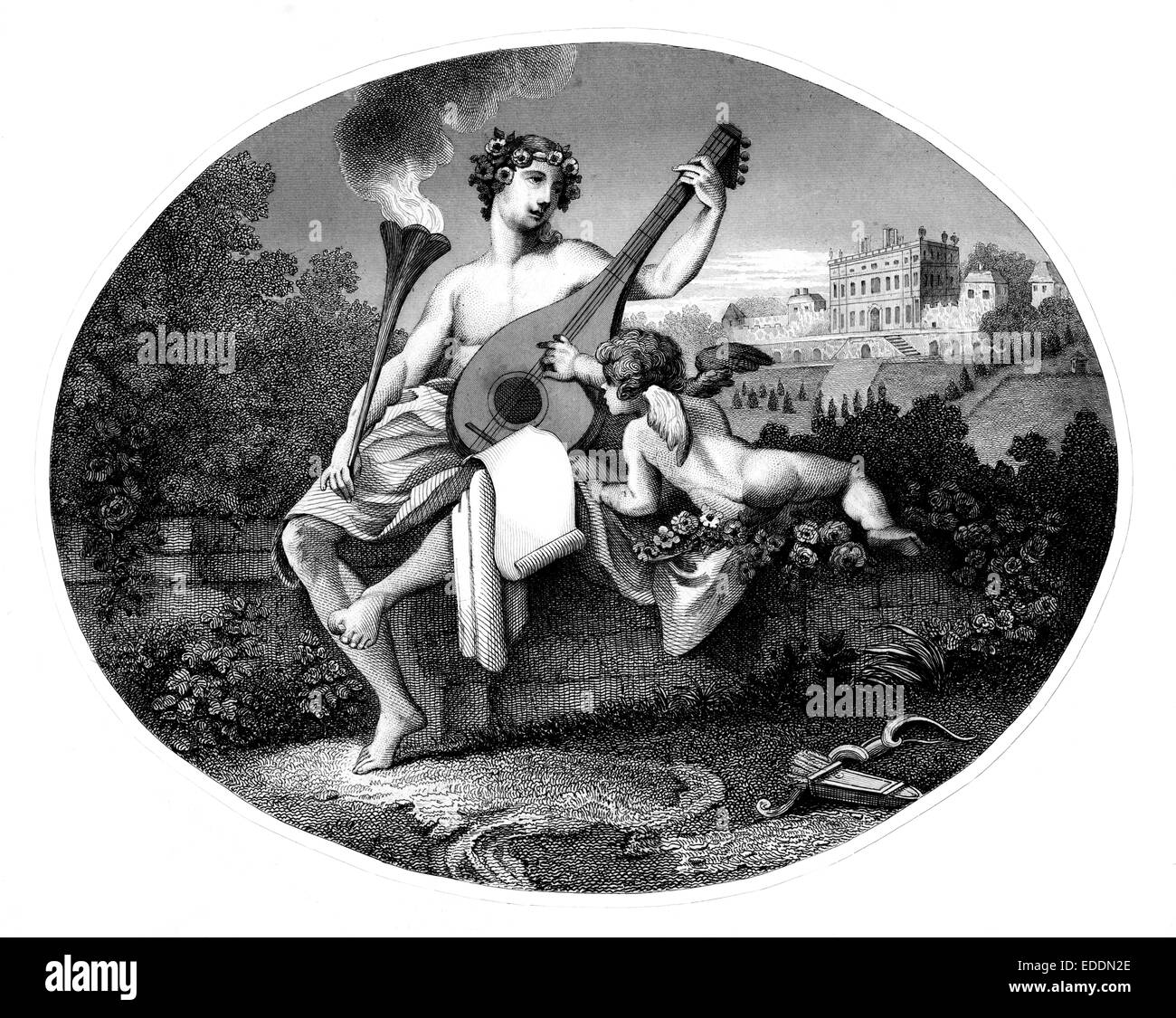 “Hymen and Cupid” engraved from the original by English artist William Hogarth 1697-1764 Stock Photohttps://www.alamy.com/image-license-details/?v=1https://www.alamy.com/stock-photo-hymen-and-cupid-engraved-from-the-original-by-english-artist-william-77133910.html
“Hymen and Cupid” engraved from the original by English artist William Hogarth 1697-1764 Stock Photohttps://www.alamy.com/image-license-details/?v=1https://www.alamy.com/stock-photo-hymen-and-cupid-engraved-from-the-original-by-english-artist-william-77133910.htmlRMEDDN2E–“Hymen and Cupid” engraved from the original by English artist William Hogarth 1697-1764
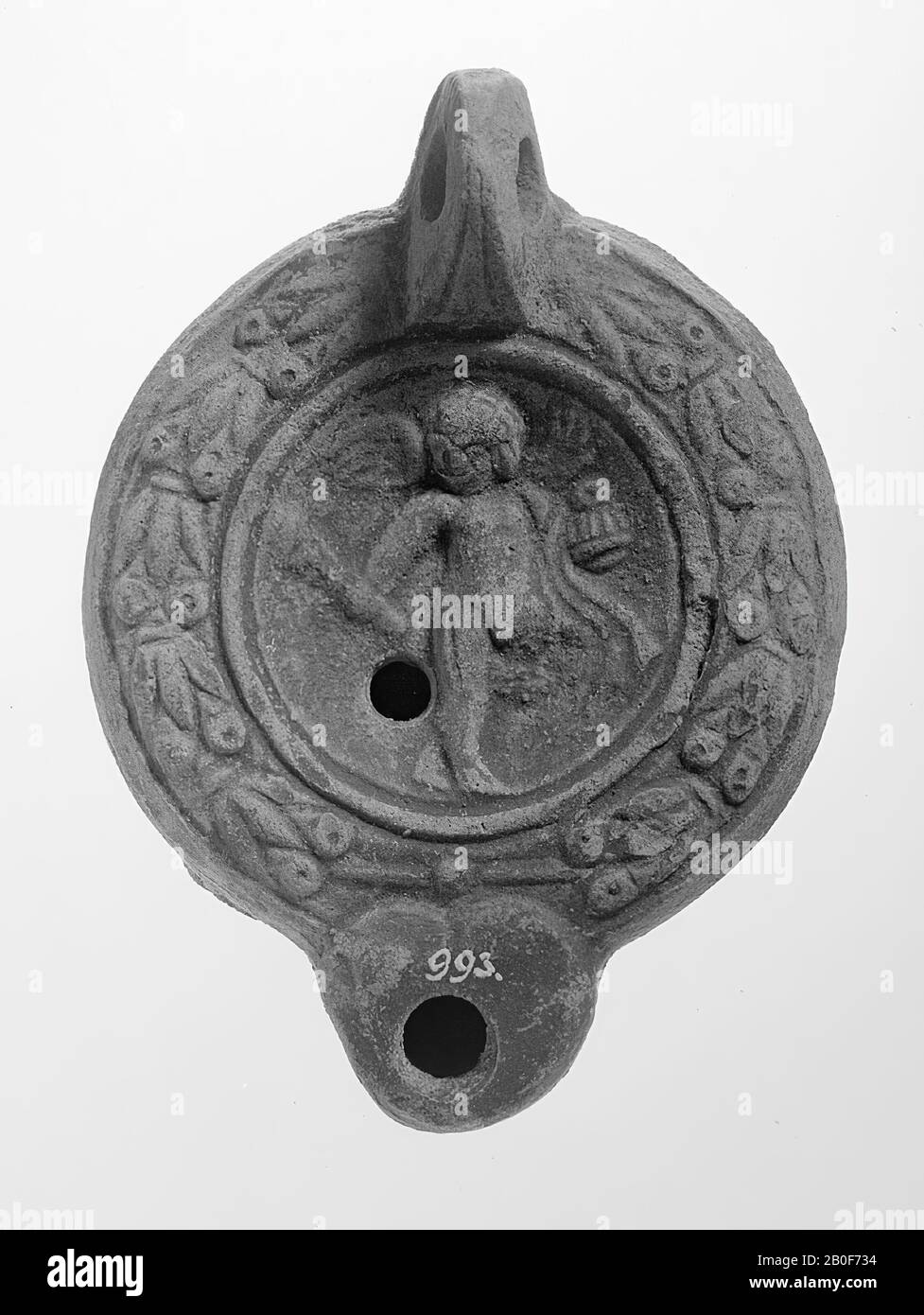 A gray-gray lamp with a round body on a round base. The hollow, round mirror is surrounded with concentric circles and decorated with a relief of a standing Eros with a torch. The small filling hole is located at the bottom left of the figure. The shoulder is decorated with a laurel wreath and berries. The blunt spout is rounded off, has a large burn hole and the incidence is heart-shaped with a relief point and stripe above it. The vertically attached ear is decorated with notches. The underside of the spout is shaded. Brand: two relief points., Oil lamp, earthenware, terracotta, 4.4 x 10.4 x Stock Photohttps://www.alamy.com/image-license-details/?v=1https://www.alamy.com/a-gray-gray-lamp-with-a-round-body-on-a-round-base-the-hollow-round-mirror-is-surrounded-with-concentric-circles-and-decorated-with-a-relief-of-a-standing-eros-with-a-torch-the-small-filling-hole-is-located-at-the-bottom-left-of-the-figure-the-shoulder-is-decorated-with-a-laurel-wreath-and-berries-the-blunt-spout-is-rounded-off-has-a-large-burn-hole-and-the-incidence-is-heart-shaped-with-a-relief-point-and-stripe-above-it-the-vertically-attached-ear-is-decorated-with-notches-the-underside-of-the-spout-is-shaded-brand-two-relief-points-oil-lamp-earthenware-terracotta-44-x-104-x-image344542216.html
A gray-gray lamp with a round body on a round base. The hollow, round mirror is surrounded with concentric circles and decorated with a relief of a standing Eros with a torch. The small filling hole is located at the bottom left of the figure. The shoulder is decorated with a laurel wreath and berries. The blunt spout is rounded off, has a large burn hole and the incidence is heart-shaped with a relief point and stripe above it. The vertically attached ear is decorated with notches. The underside of the spout is shaded. Brand: two relief points., Oil lamp, earthenware, terracotta, 4.4 x 10.4 x Stock Photohttps://www.alamy.com/image-license-details/?v=1https://www.alamy.com/a-gray-gray-lamp-with-a-round-body-on-a-round-base-the-hollow-round-mirror-is-surrounded-with-concentric-circles-and-decorated-with-a-relief-of-a-standing-eros-with-a-torch-the-small-filling-hole-is-located-at-the-bottom-left-of-the-figure-the-shoulder-is-decorated-with-a-laurel-wreath-and-berries-the-blunt-spout-is-rounded-off-has-a-large-burn-hole-and-the-incidence-is-heart-shaped-with-a-relief-point-and-stripe-above-it-the-vertically-attached-ear-is-decorated-with-notches-the-underside-of-the-spout-is-shaded-brand-two-relief-points-oil-lamp-earthenware-terracotta-44-x-104-x-image344542216.htmlRM2B0F734–A gray-gray lamp with a round body on a round base. The hollow, round mirror is surrounded with concentric circles and decorated with a relief of a standing Eros with a torch. The small filling hole is located at the bottom left of the figure. The shoulder is decorated with a laurel wreath and berries. The blunt spout is rounded off, has a large burn hole and the incidence is heart-shaped with a relief point and stripe above it. The vertically attached ear is decorated with notches. The underside of the spout is shaded. Brand: two relief points., Oil lamp, earthenware, terracotta, 4.4 x 10.4 x
RF2XXM5A5–Greek mythology icons collection is a vector illustration with editable stroke.
 Reitender Eros mit Fackel, clay, pressed into the form, hand modelled, fired (ceramic), clay, Total: height: 15.8 cm; width: 11.5 cm; depth: 5 cm, Ceramics, Riding, Torch, History of Cupid, Cupid (Eros), Hellenism, Late Republican, Early Imperial Period, Middle Imperial Period, The god Eros presents himself in the rider's seat only wearing a coat and a cap, although the corresponding beast of burden is missing The wings protruding over the shoulders on the right and left identify him as the Greek god, whose soft and well-rounded body forms contrast with the long arms and legs. Stock Photohttps://www.alamy.com/image-license-details/?v=1https://www.alamy.com/reitender-eros-mit-fackel-clay-pressed-into-the-form-hand-modelled-fired-ceramic-clay-total-height-158-cm-width-115-cm-depth-5-cm-ceramics-riding-torch-history-of-cupid-cupid-eros-hellenism-late-republican-early-imperial-period-middle-imperial-period-the-god-eros-presents-himself-in-the-riders-seat-only-wearing-a-coat-and-a-cap-although-the-corresponding-beast-of-burden-is-missing-the-wings-protruding-over-the-shoulders-on-the-right-and-left-identify-him-as-the-greek-god-whose-soft-and-well-rounded-body-forms-contrast-with-the-long-arms-and-legs-image392064560.html
Reitender Eros mit Fackel, clay, pressed into the form, hand modelled, fired (ceramic), clay, Total: height: 15.8 cm; width: 11.5 cm; depth: 5 cm, Ceramics, Riding, Torch, History of Cupid, Cupid (Eros), Hellenism, Late Republican, Early Imperial Period, Middle Imperial Period, The god Eros presents himself in the rider's seat only wearing a coat and a cap, although the corresponding beast of burden is missing The wings protruding over the shoulders on the right and left identify him as the Greek god, whose soft and well-rounded body forms contrast with the long arms and legs. Stock Photohttps://www.alamy.com/image-license-details/?v=1https://www.alamy.com/reitender-eros-mit-fackel-clay-pressed-into-the-form-hand-modelled-fired-ceramic-clay-total-height-158-cm-width-115-cm-depth-5-cm-ceramics-riding-torch-history-of-cupid-cupid-eros-hellenism-late-republican-early-imperial-period-middle-imperial-period-the-god-eros-presents-himself-in-the-riders-seat-only-wearing-a-coat-and-a-cap-although-the-corresponding-beast-of-burden-is-missing-the-wings-protruding-over-the-shoulders-on-the-right-and-left-identify-him-as-the-greek-god-whose-soft-and-well-rounded-body-forms-contrast-with-the-long-arms-and-legs-image392064560.htmlRM2DNT29M–Reitender Eros mit Fackel, clay, pressed into the form, hand modelled, fired (ceramic), clay, Total: height: 15.8 cm; width: 11.5 cm; depth: 5 cm, Ceramics, Riding, Torch, History of Cupid, Cupid (Eros), Hellenism, Late Republican, Early Imperial Period, Middle Imperial Period, The god Eros presents himself in the rider's seat only wearing a coat and a cap, although the corresponding beast of burden is missing The wings protruding over the shoulders on the right and left identify him as the Greek god, whose soft and well-rounded body forms contrast with the long arms and legs.
 Amor with burning torch Salamander surrounded by fire Two images of one plate . Left: Amor stands with a burning torch in his hands he is holding upside down. Right: A salamander surrounded by vuur. Manufacturer : printmaker: Michiel le Blonprentmaker: Simon van de Passe (listed building) Dated: 1616 Physical features: car material: paper Technique: engra (printing process) Dimensions: sheet: H 51 mm × W 135 mmToelichtingPrent listed in: Heinsius, Daniel, and Scriverius, Petrus (trans.). Nederduytsche poemata. Amsterdam: Willem Jansz Blaeu, 1616. Subject: (story of) Cupid, Amor (Eros) torch sa Stock Photohttps://www.alamy.com/image-license-details/?v=1https://www.alamy.com/amor-with-burning-torch-salamander-surrounded-by-fire-two-images-of-one-plate-left-amor-stands-with-a-burning-torch-in-his-hands-he-is-holding-upside-down-right-a-salamander-surrounded-by-vuur-manufacturer-printmaker-michiel-le-blonprentmaker-simon-van-de-passe-listed-building-dated-1616-physical-features-car-material-paper-technique-engra-printing-process-dimensions-sheet-h-51-mm-w-135-mmtoelichtingprent-listed-in-heinsius-daniel-and-scriverius-petrus-trans-nederduytsche-poemata-amsterdam-willem-jansz-blaeu-1616-subject-story-of-cupid-amor-eros-torch-sa-image348133472.html
Amor with burning torch Salamander surrounded by fire Two images of one plate . Left: Amor stands with a burning torch in his hands he is holding upside down. Right: A salamander surrounded by vuur. Manufacturer : printmaker: Michiel le Blonprentmaker: Simon van de Passe (listed building) Dated: 1616 Physical features: car material: paper Technique: engra (printing process) Dimensions: sheet: H 51 mm × W 135 mmToelichtingPrent listed in: Heinsius, Daniel, and Scriverius, Petrus (trans.). Nederduytsche poemata. Amsterdam: Willem Jansz Blaeu, 1616. Subject: (story of) Cupid, Amor (Eros) torch sa Stock Photohttps://www.alamy.com/image-license-details/?v=1https://www.alamy.com/amor-with-burning-torch-salamander-surrounded-by-fire-two-images-of-one-plate-left-amor-stands-with-a-burning-torch-in-his-hands-he-is-holding-upside-down-right-a-salamander-surrounded-by-vuur-manufacturer-printmaker-michiel-le-blonprentmaker-simon-van-de-passe-listed-building-dated-1616-physical-features-car-material-paper-technique-engra-printing-process-dimensions-sheet-h-51-mm-w-135-mmtoelichtingprent-listed-in-heinsius-daniel-and-scriverius-petrus-trans-nederduytsche-poemata-amsterdam-willem-jansz-blaeu-1616-subject-story-of-cupid-amor-eros-torch-sa-image348133472.htmlRM2B6ARP8–Amor with burning torch Salamander surrounded by fire Two images of one plate . Left: Amor stands with a burning torch in his hands he is holding upside down. Right: A salamander surrounded by vuur. Manufacturer : printmaker: Michiel le Blonprentmaker: Simon van de Passe (listed building) Dated: 1616 Physical features: car material: paper Technique: engra (printing process) Dimensions: sheet: H 51 mm × W 135 mmToelichtingPrent listed in: Heinsius, Daniel, and Scriverius, Petrus (trans.). Nederduytsche poemata. Amsterdam: Willem Jansz Blaeu, 1616. Subject: (story of) Cupid, Amor (Eros) torch sa
 A brown-varnished lamp with a round body on a round base. The hollow, round mirror is surrounded by concentric circles and decorated with a relief of Eros a wreath in one, holding a torch in the other hand, with on the left the small filling hole. The short, blunt spout is round and has a large fire hole. The vertically attached ear is decorated with notches. The opening of the spout is horizontal and has on both sides a dented point., Oil lamp, earthenware, terracotta, 4.5 x 9.6 x 6.5 cm, 2nd half 1st century to 2nd half 3rd century AD. 50-250 AD, Tunisia Stock Photohttps://www.alamy.com/image-license-details/?v=1https://www.alamy.com/a-brown-varnished-lamp-with-a-round-body-on-a-round-base-the-hollow-round-mirror-is-surrounded-by-concentric-circles-and-decorated-with-a-relief-of-eros-a-wreath-in-one-holding-a-torch-in-the-other-hand-with-on-the-left-the-small-filling-hole-the-short-blunt-spout-is-round-and-has-a-large-fire-hole-the-vertically-attached-ear-is-decorated-with-notches-the-opening-of-the-spout-is-horizontal-and-has-on-both-sides-a-dented-point-oil-lamp-earthenware-terracotta-45-x-96-x-65-cm-2nd-half-1st-century-to-2nd-half-3rd-century-ad-50-250-ad-tunisia-image344538976.html
A brown-varnished lamp with a round body on a round base. The hollow, round mirror is surrounded by concentric circles and decorated with a relief of Eros a wreath in one, holding a torch in the other hand, with on the left the small filling hole. The short, blunt spout is round and has a large fire hole. The vertically attached ear is decorated with notches. The opening of the spout is horizontal and has on both sides a dented point., Oil lamp, earthenware, terracotta, 4.5 x 9.6 x 6.5 cm, 2nd half 1st century to 2nd half 3rd century AD. 50-250 AD, Tunisia Stock Photohttps://www.alamy.com/image-license-details/?v=1https://www.alamy.com/a-brown-varnished-lamp-with-a-round-body-on-a-round-base-the-hollow-round-mirror-is-surrounded-by-concentric-circles-and-decorated-with-a-relief-of-eros-a-wreath-in-one-holding-a-torch-in-the-other-hand-with-on-the-left-the-small-filling-hole-the-short-blunt-spout-is-round-and-has-a-large-fire-hole-the-vertically-attached-ear-is-decorated-with-notches-the-opening-of-the-spout-is-horizontal-and-has-on-both-sides-a-dented-point-oil-lamp-earthenware-terracotta-45-x-96-x-65-cm-2nd-half-1st-century-to-2nd-half-3rd-century-ad-50-250-ad-tunisia-image344538976.htmlRM2B0F2YC–A brown-varnished lamp with a round body on a round base. The hollow, round mirror is surrounded by concentric circles and decorated with a relief of Eros a wreath in one, holding a torch in the other hand, with on the left the small filling hole. The short, blunt spout is round and has a large fire hole. The vertically attached ear is decorated with notches. The opening of the spout is horizontal and has on both sides a dented point., Oil lamp, earthenware, terracotta, 4.5 x 9.6 x 6.5 cm, 2nd half 1st century to 2nd half 3rd century AD. 50-250 AD, Tunisia
 Amor and Putti sharpen their arrows, Julien -Léopold Boilly, After Pierre Prud'Hon, 1806 - 1874 print paper. (story of) Cupid, Amor (Eros). cupids: 'amores', 'amoretti', 'putti'. torch Stock Photohttps://www.alamy.com/image-license-details/?v=1https://www.alamy.com/amor-and-putti-sharpen-their-arrows-julien-lopold-boilly-after-pierre-prudhon-1806-1874-print-paper-story-of-cupid-amor-eros-cupids-amores-amoretti-putti-torch-image593691393.html
Amor and Putti sharpen their arrows, Julien -Léopold Boilly, After Pierre Prud'Hon, 1806 - 1874 print paper. (story of) Cupid, Amor (Eros). cupids: 'amores', 'amoretti', 'putti'. torch Stock Photohttps://www.alamy.com/image-license-details/?v=1https://www.alamy.com/amor-and-putti-sharpen-their-arrows-julien-lopold-boilly-after-pierre-prudhon-1806-1874-print-paper-story-of-cupid-amor-eros-cupids-amores-amoretti-putti-torch-image593691393.htmlRM2WDTYC1–Amor and Putti sharpen their arrows, Julien -Léopold Boilly, After Pierre Prud'Hon, 1806 - 1874 print paper. (story of) Cupid, Amor (Eros). cupids: 'amores', 'amoretti', 'putti'. torch
 Two times Amor connected by a ribbon with eachother, print maker: Boëtius Adamsz. Bolswert, M. Reen, 1590 - 1633 Stock Photohttps://www.alamy.com/image-license-details/?v=1https://www.alamy.com/two-times-amor-connected-by-a-ribbon-with-eachother-print-maker-botius-adamsz-bolswert-m-reen-1590-1633-image240616644.html
Two times Amor connected by a ribbon with eachother, print maker: Boëtius Adamsz. Bolswert, M. Reen, 1590 - 1633 Stock Photohttps://www.alamy.com/image-license-details/?v=1https://www.alamy.com/two-times-amor-connected-by-a-ribbon-with-eachother-print-maker-botius-adamsz-bolswert-m-reen-1590-1633-image240616644.htmlRMRYD0YG–Two times Amor connected by a ribbon with eachother, print maker: Boëtius Adamsz. Bolswert, M. Reen, 1590 - 1633
 Terracotta cup with appliqués. Culture: Greek, Pergamene. Dimensions: H. 3 1/8 in. (8 cm); diameter 4 in. (10.2 cm). Date: ca. 150-100 B.C.. Applied decoration: the infant Herakles strangling the snakes, amphora with a lid, Eros holding a torch Pergamene appliqué pottery, with its lustrous glaze and large repertoire of applied mold-made reliefs, is one of the finest ceramic creations of the Hellenistic period. Even as a baby, Herakles possessed great strength. The snakes he is strangling in this image were sent by the goddess Hera to kill him when she found out that his father, Zeus, had be Stock Photohttps://www.alamy.com/image-license-details/?v=1https://www.alamy.com/terracotta-cup-with-appliqus-culture-greek-pergamene-dimensions-h-3-18-in-8-cm-diameter-4-in-102-cm-date-ca-150-100-bc-applied-decoration-the-infant-herakles-strangling-the-snakes-amphora-with-a-lid-eros-holding-a-torch-pergamene-appliqu-pottery-with-its-lustrous-glaze-and-large-repertoire-of-applied-mold-made-reliefs-is-one-of-the-finest-ceramic-creations-of-the-hellenistic-period-even-as-a-baby-herakles-possessed-great-strength-the-snakes-he-is-strangling-in-this-image-were-sent-by-the-goddess-hera-to-kill-him-when-she-found-out-that-his-father-zeus-had-be-image213332795.html
Terracotta cup with appliqués. Culture: Greek, Pergamene. Dimensions: H. 3 1/8 in. (8 cm); diameter 4 in. (10.2 cm). Date: ca. 150-100 B.C.. Applied decoration: the infant Herakles strangling the snakes, amphora with a lid, Eros holding a torch Pergamene appliqué pottery, with its lustrous glaze and large repertoire of applied mold-made reliefs, is one of the finest ceramic creations of the Hellenistic period. Even as a baby, Herakles possessed great strength. The snakes he is strangling in this image were sent by the goddess Hera to kill him when she found out that his father, Zeus, had be Stock Photohttps://www.alamy.com/image-license-details/?v=1https://www.alamy.com/terracotta-cup-with-appliqus-culture-greek-pergamene-dimensions-h-3-18-in-8-cm-diameter-4-in-102-cm-date-ca-150-100-bc-applied-decoration-the-infant-herakles-strangling-the-snakes-amphora-with-a-lid-eros-holding-a-torch-pergamene-appliqu-pottery-with-its-lustrous-glaze-and-large-repertoire-of-applied-mold-made-reliefs-is-one-of-the-finest-ceramic-creations-of-the-hellenistic-period-even-as-a-baby-herakles-possessed-great-strength-the-snakes-he-is-strangling-in-this-image-were-sent-by-the-goddess-hera-to-kill-him-when-she-found-out-that-his-father-zeus-had-be-image213332795.htmlRMPB244B–Terracotta cup with appliqués. Culture: Greek, Pergamene. Dimensions: H. 3 1/8 in. (8 cm); diameter 4 in. (10.2 cm). Date: ca. 150-100 B.C.. Applied decoration: the infant Herakles strangling the snakes, amphora with a lid, Eros holding a torch Pergamene appliqué pottery, with its lustrous glaze and large repertoire of applied mold-made reliefs, is one of the finest ceramic creations of the Hellenistic period. Even as a baby, Herakles possessed great strength. The snakes he is strangling in this image were sent by the goddess Hera to kill him when she found out that his father, Zeus, had be
 Bronze statuette of Eros running, 1st–2nd century A.D Stock Photohttps://www.alamy.com/image-license-details/?v=1https://www.alamy.com/stock-image-bronze-statuette-of-eros-running-1st2nd-century-ad-162418150.html
Bronze statuette of Eros running, 1st–2nd century A.D Stock Photohttps://www.alamy.com/image-license-details/?v=1https://www.alamy.com/stock-image-bronze-statuette-of-eros-running-1st2nd-century-ad-162418150.htmlRMKC6P06–Bronze statuette of Eros running, 1st–2nd century A.D
 The nymphs find Eros sleeping and trying to turn off Eros' torch Frølich, Lorenz 1820 - 1908 Drawing Lorenz Frølich 1820-1908: malerier, møbler, tegninger, grafik, Hanne Westergaard, nr. 242, 42064, 1971. Egne Optegnelser og Breve til og fra hans Slægt og Venner: I Hundredaaret for Kunstnerens Fødsel samlet og udgivet af F. Hendriksen, Lorenz Frølich, Den græske anthologi er omt. pp. 303-309, tegningen er afb. p. 305, 6837, (1920-1921). Med Frölichs Tegninger til den græske Anthologi, Sigurd Müller, afb. p. 92, k2003-555, 1914 Nymferne finder Eros sovende og forsøger at slukke Eros' fakkel Stock Photohttps://www.alamy.com/image-license-details/?v=1https://www.alamy.com/the-nymphs-find-eros-sleeping-and-trying-to-turn-off-eros-torch-frlich-lorenz-1820-1908-drawing-lorenz-frlich-1820-1908-malerier-mbler-tegninger-grafik-hanne-westergaard-nr-242-42064-1971-egne-optegnelser-og-breve-til-og-fra-hans-slgt-og-venner-i-hundredaaret-for-kunstnerens-fdsel-samlet-og-udgivet-af-f-hendriksen-lorenz-frlich-den-grske-anthologi-er-omt-pp-303-309-tegningen-er-afb-p-305-6837-1920-1921-med-frlichs-tegninger-til-den-grske-anthologi-sigurd-mller-afb-p-92-k2003-555-1914-nymferne-finder-eros-sovende-og-forsger-at-slukke-eros-fakkel-image613399004.html
The nymphs find Eros sleeping and trying to turn off Eros' torch Frølich, Lorenz 1820 - 1908 Drawing Lorenz Frølich 1820-1908: malerier, møbler, tegninger, grafik, Hanne Westergaard, nr. 242, 42064, 1971. Egne Optegnelser og Breve til og fra hans Slægt og Venner: I Hundredaaret for Kunstnerens Fødsel samlet og udgivet af F. Hendriksen, Lorenz Frølich, Den græske anthologi er omt. pp. 303-309, tegningen er afb. p. 305, 6837, (1920-1921). Med Frölichs Tegninger til den græske Anthologi, Sigurd Müller, afb. p. 92, k2003-555, 1914 Nymferne finder Eros sovende og forsøger at slukke Eros' fakkel Stock Photohttps://www.alamy.com/image-license-details/?v=1https://www.alamy.com/the-nymphs-find-eros-sleeping-and-trying-to-turn-off-eros-torch-frlich-lorenz-1820-1908-drawing-lorenz-frlich-1820-1908-malerier-mbler-tegninger-grafik-hanne-westergaard-nr-242-42064-1971-egne-optegnelser-og-breve-til-og-fra-hans-slgt-og-venner-i-hundredaaret-for-kunstnerens-fdsel-samlet-og-udgivet-af-f-hendriksen-lorenz-frlich-den-grske-anthologi-er-omt-pp-303-309-tegningen-er-afb-p-305-6837-1920-1921-med-frlichs-tegninger-til-den-grske-anthologi-sigurd-mller-afb-p-92-k2003-555-1914-nymferne-finder-eros-sovende-og-forsger-at-slukke-eros-fakkel-image613399004.htmlRM2XHXMK8–The nymphs find Eros sleeping and trying to turn off Eros' torch Frølich, Lorenz 1820 - 1908 Drawing Lorenz Frølich 1820-1908: malerier, møbler, tegninger, grafik, Hanne Westergaard, nr. 242, 42064, 1971. Egne Optegnelser og Breve til og fra hans Slægt og Venner: I Hundredaaret for Kunstnerens Fødsel samlet og udgivet af F. Hendriksen, Lorenz Frølich, Den græske anthologi er omt. pp. 303-309, tegningen er afb. p. 305, 6837, (1920-1921). Med Frölichs Tegninger til den græske Anthologi, Sigurd Müller, afb. p. 92, k2003-555, 1914 Nymferne finder Eros sovende og forsøger at slukke Eros' fakkel
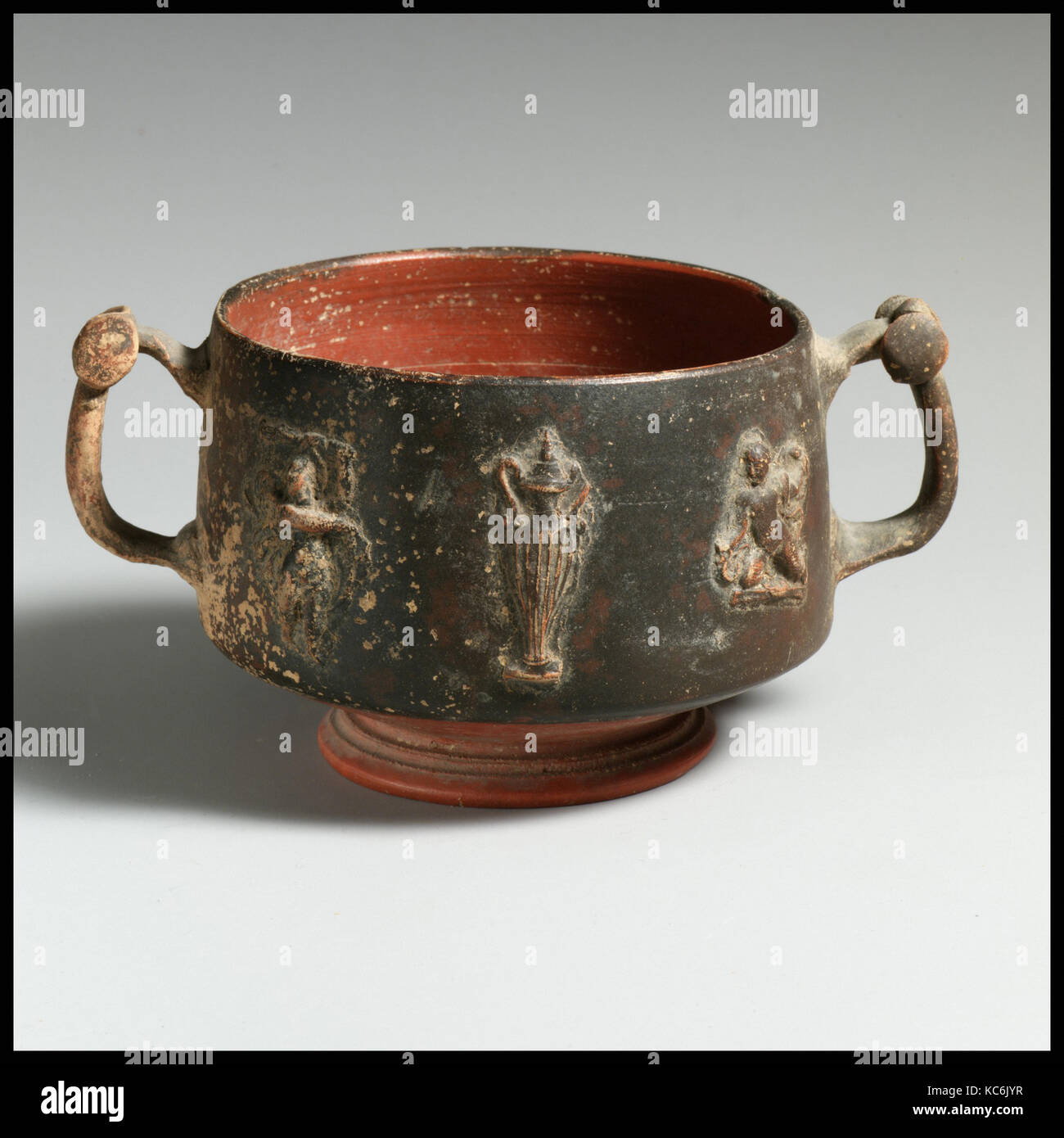 Terracotta cup with appliqués, Hellenistic, ca. 150–100 B.C., Greek, Pergamene, Terracotta, H. 3 1/8 in. (8 cm); diameter 4 in Stock Photohttps://www.alamy.com/image-license-details/?v=1https://www.alamy.com/stock-image-terracotta-cup-with-appliqus-hellenistic-ca-150100-bc-greek-pergamene-162415787.html
Terracotta cup with appliqués, Hellenistic, ca. 150–100 B.C., Greek, Pergamene, Terracotta, H. 3 1/8 in. (8 cm); diameter 4 in Stock Photohttps://www.alamy.com/image-license-details/?v=1https://www.alamy.com/stock-image-terracotta-cup-with-appliqus-hellenistic-ca-150100-bc-greek-pergamene-162415787.htmlRMKC6JYR–Terracotta cup with appliqués, Hellenistic, ca. 150–100 B.C., Greek, Pergamene, Terracotta, H. 3 1/8 in. (8 cm); diameter 4 in
 Glass cameo- Eros holding a torch MET DP143791 249251 Stock Photohttps://www.alamy.com/image-license-details/?v=1https://www.alamy.com/stock-image-glass-cameo-eros-holding-a-torch-met-dp143791-249251-168110637.html
Glass cameo- Eros holding a torch MET DP143791 249251 Stock Photohttps://www.alamy.com/image-license-details/?v=1https://www.alamy.com/stock-image-glass-cameo-eros-holding-a-torch-met-dp143791-249251-168110637.htmlRMKNE2R9–Glass cameo- Eros holding a torch MET DP143791 249251
 Sleeping Amor Non ti fidar che mai non dorme Amore / egg chiude gli occhi allor che insidia un core (title on object), The sleeping Amor in a landscape. Behind him lies a burning torch. In the foreground are his arrows and bow, a painter's palette with brushes and a laurel wreath., Sleeping, unconsciousness, (story of) Cupid, Amor (Eros), sleeping Cupid, possibly signifying a slackening of Love's influence, Mauro Gandolfi (mentioned on object), 1820, paper, engraving, h 346 mm × w 376 mm, Reimagined by Gibon, design of warm cheerful glowing of brightness and light rays radiance. Classic art re Stock Photohttps://www.alamy.com/image-license-details/?v=1https://www.alamy.com/sleeping-amor-non-ti-fidar-che-mai-non-dorme-amore-egg-chiude-gli-occhi-allor-che-insidia-un-core-title-on-object-the-sleeping-amor-in-a-landscape-behind-him-lies-a-burning-torch-in-the-foreground-are-his-arrows-and-bow-a-painters-palette-with-brushes-and-a-laurel-wreath-sleeping-unconsciousness-story-of-cupid-amor-eros-sleeping-cupid-possibly-signifying-a-slackening-of-loves-influence-mauro-gandolfi-mentioned-on-object-1820-paper-engraving-h-346-mm-w-376-mm-reimagined-by-gibon-design-of-warm-cheerful-glowing-of-brightness-and-light-rays-radiance-classic-art-re-image350006874.html
Sleeping Amor Non ti fidar che mai non dorme Amore / egg chiude gli occhi allor che insidia un core (title on object), The sleeping Amor in a landscape. Behind him lies a burning torch. In the foreground are his arrows and bow, a painter's palette with brushes and a laurel wreath., Sleeping, unconsciousness, (story of) Cupid, Amor (Eros), sleeping Cupid, possibly signifying a slackening of Love's influence, Mauro Gandolfi (mentioned on object), 1820, paper, engraving, h 346 mm × w 376 mm, Reimagined by Gibon, design of warm cheerful glowing of brightness and light rays radiance. Classic art re Stock Photohttps://www.alamy.com/image-license-details/?v=1https://www.alamy.com/sleeping-amor-non-ti-fidar-che-mai-non-dorme-amore-egg-chiude-gli-occhi-allor-che-insidia-un-core-title-on-object-the-sleeping-amor-in-a-landscape-behind-him-lies-a-burning-torch-in-the-foreground-are-his-arrows-and-bow-a-painters-palette-with-brushes-and-a-laurel-wreath-sleeping-unconsciousness-story-of-cupid-amor-eros-sleeping-cupid-possibly-signifying-a-slackening-of-loves-influence-mauro-gandolfi-mentioned-on-object-1820-paper-engraving-h-346-mm-w-376-mm-reimagined-by-gibon-design-of-warm-cheerful-glowing-of-brightness-and-light-rays-radiance-classic-art-re-image350006874.htmlRF2B9C59E–Sleeping Amor Non ti fidar che mai non dorme Amore / egg chiude gli occhi allor che insidia un core (title on object), The sleeping Amor in a landscape. Behind him lies a burning torch. In the foreground are his arrows and bow, a painter's palette with brushes and a laurel wreath., Sleeping, unconsciousness, (story of) Cupid, Amor (Eros), sleeping Cupid, possibly signifying a slackening of Love's influence, Mauro Gandolfi (mentioned on object), 1820, paper, engraving, h 346 mm × w 376 mm, Reimagined by Gibon, design of warm cheerful glowing of brightness and light rays radiance. Classic art re
 Gold ring with carnelian intaglio- Eros with flaming torch MET GR672 243645 Stock Photohttps://www.alamy.com/image-license-details/?v=1https://www.alamy.com/stock-image-gold-ring-with-carnelian-intaglio-eros-with-flaming-torch-met-gr672-168299816.html
Gold ring with carnelian intaglio- Eros with flaming torch MET GR672 243645 Stock Photohttps://www.alamy.com/image-license-details/?v=1https://www.alamy.com/stock-image-gold-ring-with-carnelian-intaglio-eros-with-flaming-torch-met-gr672-168299816.htmlRMKNPM3M–Gold ring with carnelian intaglio- Eros with flaming torch MET GR672 243645
 Amphitrite on a hippocampus with Hymenaeus and Tritons. Mosaic at the Baths of Neptune. 2nd century. Ostia Antica. Italy. Stock Photohttps://www.alamy.com/image-license-details/?v=1https://www.alamy.com/stock-photo-amphitrite-on-a-hippocampus-with-hymenaeus-and-tritons-mosaic-at-the-41503023.html
Amphitrite on a hippocampus with Hymenaeus and Tritons. Mosaic at the Baths of Neptune. 2nd century. Ostia Antica. Italy. Stock Photohttps://www.alamy.com/image-license-details/?v=1https://www.alamy.com/stock-photo-amphitrite-on-a-hippocampus-with-hymenaeus-and-tritons-mosaic-at-the-41503023.htmlRMCBEHER–Amphitrite on a hippocampus with Hymenaeus and Tritons. Mosaic at the Baths of Neptune. 2nd century. Ostia Antica. Italy.
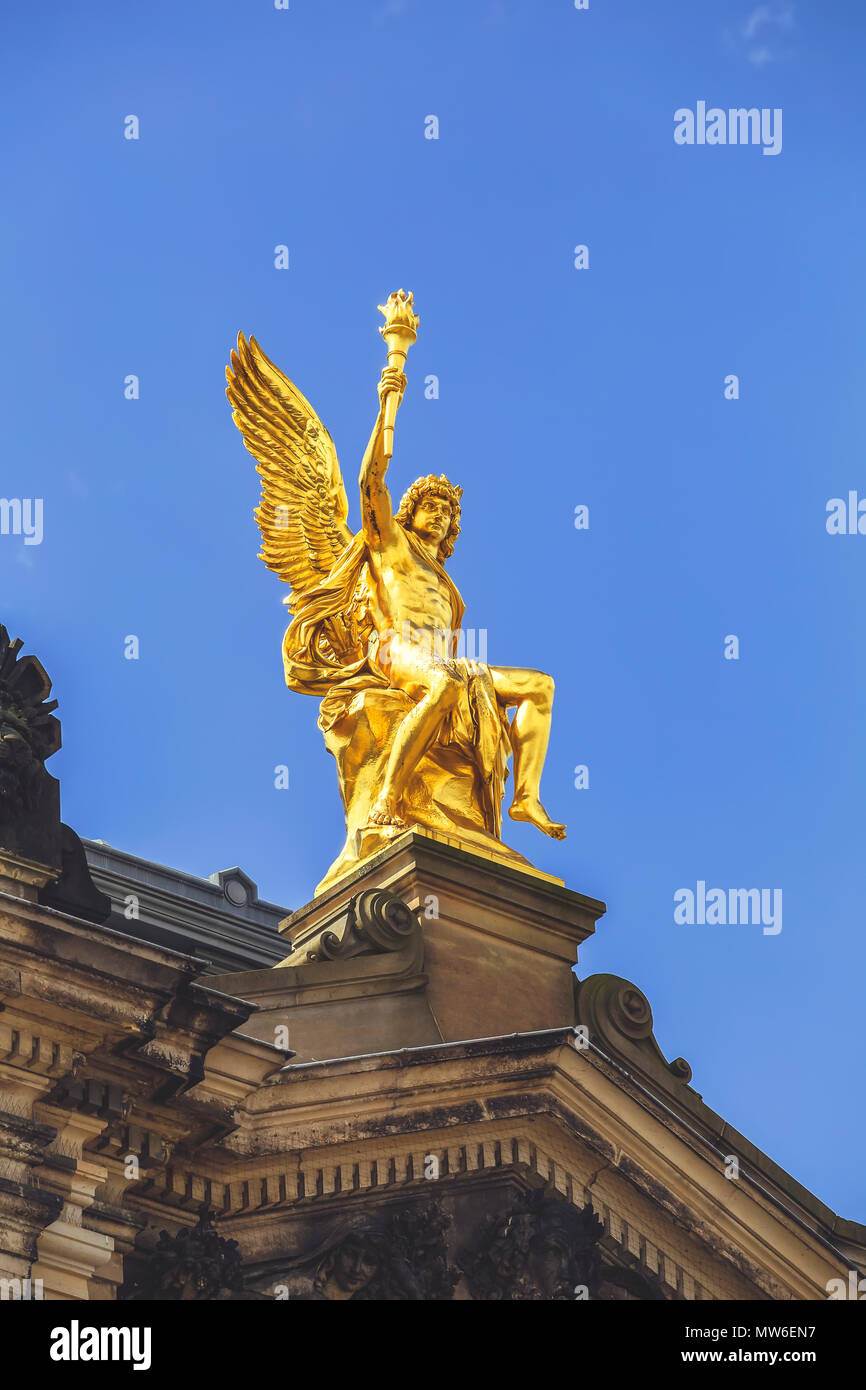 Golden statue of Eros, Dresden, Saxony, Germany. Vintage style. Stock Photohttps://www.alamy.com/image-license-details/?v=1https://www.alamy.com/golden-statue-of-eros-dresden-saxony-germany-vintage-style-image187613363.html
Golden statue of Eros, Dresden, Saxony, Germany. Vintage style. Stock Photohttps://www.alamy.com/image-license-details/?v=1https://www.alamy.com/golden-statue-of-eros-dresden-saxony-germany-vintage-style-image187613363.htmlRFMW6EN7–Golden statue of Eros, Dresden, Saxony, Germany. Vintage style.
 Onyx ring stone, ca. 1st century B.C.–3rd century A.D Stock Photohttps://www.alamy.com/image-license-details/?v=1https://www.alamy.com/stock-image-onyx-ring-stone-ca-1st-century-bc3rd-century-ad-162415401.html
Onyx ring stone, ca. 1st century B.C.–3rd century A.D Stock Photohttps://www.alamy.com/image-license-details/?v=1https://www.alamy.com/stock-image-onyx-ring-stone-ca-1st-century-bc3rd-century-ad-162415401.htmlRMKC6JE1–Onyx ring stone, ca. 1st century B.C.–3rd century A.D
 Candle-light dinner at the beach of Sun island, Maldives MV Stock Photohttps://www.alamy.com/image-license-details/?v=1https://www.alamy.com/stock-photo-candle-light-dinner-at-the-beach-of-sun-island-maldives-mv-11676079.html
Candle-light dinner at the beach of Sun island, Maldives MV Stock Photohttps://www.alamy.com/image-license-details/?v=1https://www.alamy.com/stock-photo-candle-light-dinner-at-the-beach-of-sun-island-maldives-mv-11676079.htmlRMA6YMWM–Candle-light dinner at the beach of Sun island, Maldives MV
 Journal with three vignettes, print maker: Willem Bilderdijk, 1766 - 1785 Stock Photohttps://www.alamy.com/image-license-details/?v=1https://www.alamy.com/stock-photo-journal-with-three-vignettes-print-maker-willem-bilderdijk-1766-1785-104865254.html
Journal with three vignettes, print maker: Willem Bilderdijk, 1766 - 1785 Stock Photohttps://www.alamy.com/image-license-details/?v=1https://www.alamy.com/stock-photo-journal-with-three-vignettes-print-maker-willem-bilderdijk-1766-1785-104865254.htmlRMG2H0KJ–Journal with three vignettes, print maker: Willem Bilderdijk, 1766 - 1785
 Valentine Cupids with vector love hearts and gifts. Cupid angel cartoon characters, Amur or Cherub with Valentine Day hearts, love arrow and letter, w Stock Vectorhttps://www.alamy.com/image-license-details/?v=1https://www.alamy.com/valentine-cupids-with-vector-love-hearts-and-gifts-cupid-angel-cartoon-characters-amur-or-cherub-with-valentine-day-hearts-love-arrow-and-letter-w-image453343146.html
Valentine Cupids with vector love hearts and gifts. Cupid angel cartoon characters, Amur or Cherub with Valentine Day hearts, love arrow and letter, w Stock Vectorhttps://www.alamy.com/image-license-details/?v=1https://www.alamy.com/valentine-cupids-with-vector-love-hearts-and-gifts-cupid-angel-cartoon-characters-amur-or-cherub-with-valentine-day-hearts-love-arrow-and-letter-w-image453343146.htmlRF2H9FFPJ–Valentine Cupids with vector love hearts and gifts. Cupid angel cartoon characters, Amur or Cherub with Valentine Day hearts, love arrow and letter, w
 Terracotta hydria (water jar), Late Classical, ca. 340–330 B.C., Greek, South Italian, Apulian, Terracotta; red-figure, H. 29 3 Stock Photohttps://www.alamy.com/image-license-details/?v=1https://www.alamy.com/stock-image-terracotta-hydria-water-jar-late-classical-ca-340330-bc-greek-south-162449127.html
Terracotta hydria (water jar), Late Classical, ca. 340–330 B.C., Greek, South Italian, Apulian, Terracotta; red-figure, H. 29 3 Stock Photohttps://www.alamy.com/image-license-details/?v=1https://www.alamy.com/stock-image-terracotta-hydria-water-jar-late-classical-ca-340330-bc-greek-south-162449127.htmlRMKC85EF–Terracotta hydria (water jar), Late Classical, ca. 340–330 B.C., Greek, South Italian, Apulian, Terracotta; red-figure, H. 29 3
 Fotoreproductie van een schilderij, voorstellende een processie voor de tempel van Eros Photo reproduction of a painting, depicting a procession to the temple of Eros Object Type: photo reproduction page Item number: RP-F 2001-7-876A-26 Manufacturer : Photographer: anonymous to painting by Herbert Schmalz (listed object ) Dating: ca. 1883 - in or in front 1888 Material: photo paper Technique: albumin pressure dimensions: picture: h 72 mm × W 141 mmToelichtingFoto opposite page 248. Subject: procession Roman religion (story of) Cupid, Amor (Eros) torch Stock Photohttps://www.alamy.com/image-license-details/?v=1https://www.alamy.com/fotoreproductie-van-een-schilderij-voorstellende-een-processie-voor-de-tempel-van-eros-photo-reproduction-of-a-painting-depicting-a-procession-to-the-temple-of-eros-object-type-photo-reproduction-page-item-number-rp-f-2001-7-876a-26-manufacturer-photographer-anonymous-to-painting-by-herbert-schmalz-listed-object-dating-ca-1883-in-or-in-front-1888-material-photo-paper-technique-albumin-pressure-dimensions-picture-h-72-mm-w-141-mmtoelichtingfoto-opposite-page-248-subject-procession-roman-religion-story-of-cupid-amor-eros-torch-image348357536.html
Fotoreproductie van een schilderij, voorstellende een processie voor de tempel van Eros Photo reproduction of a painting, depicting a procession to the temple of Eros Object Type: photo reproduction page Item number: RP-F 2001-7-876A-26 Manufacturer : Photographer: anonymous to painting by Herbert Schmalz (listed object ) Dating: ca. 1883 - in or in front 1888 Material: photo paper Technique: albumin pressure dimensions: picture: h 72 mm × W 141 mmToelichtingFoto opposite page 248. Subject: procession Roman religion (story of) Cupid, Amor (Eros) torch Stock Photohttps://www.alamy.com/image-license-details/?v=1https://www.alamy.com/fotoreproductie-van-een-schilderij-voorstellende-een-processie-voor-de-tempel-van-eros-photo-reproduction-of-a-painting-depicting-a-procession-to-the-temple-of-eros-object-type-photo-reproduction-page-item-number-rp-f-2001-7-876a-26-manufacturer-photographer-anonymous-to-painting-by-herbert-schmalz-listed-object-dating-ca-1883-in-or-in-front-1888-material-photo-paper-technique-albumin-pressure-dimensions-picture-h-72-mm-w-141-mmtoelichtingfoto-opposite-page-248-subject-procession-roman-religion-story-of-cupid-amor-eros-torch-image348357536.htmlRM2B6N1GG–Fotoreproductie van een schilderij, voorstellende een processie voor de tempel van Eros Photo reproduction of a painting, depicting a procession to the temple of Eros Object Type: photo reproduction page Item number: RP-F 2001-7-876A-26 Manufacturer : Photographer: anonymous to painting by Herbert Schmalz (listed object ) Dating: ca. 1883 - in or in front 1888 Material: photo paper Technique: albumin pressure dimensions: picture: h 72 mm × W 141 mmToelichtingFoto opposite page 248. Subject: procession Roman religion (story of) Cupid, Amor (Eros) torch
 Two times Amor connected by a ribbon with eachother, print maker: Boëtius Adamsz. Bolswert, M. Reen, 1590 - 1633 Stock Photohttps://www.alamy.com/image-license-details/?v=1https://www.alamy.com/stock-photo-two-times-amor-connected-by-a-ribbon-with-eachother-print-maker-botius-104899561.html
Two times Amor connected by a ribbon with eachother, print maker: Boëtius Adamsz. Bolswert, M. Reen, 1590 - 1633 Stock Photohttps://www.alamy.com/image-license-details/?v=1https://www.alamy.com/stock-photo-two-times-amor-connected-by-a-ribbon-with-eachother-print-maker-botius-104899561.htmlRMG2JGCW–Two times Amor connected by a ribbon with eachother, print maker: Boëtius Adamsz. Bolswert, M. Reen, 1590 - 1633
 Eros Funeral '. Museum of Fine Arts of the City of Paris, Petit Palais. 26997-3 Antiquity, God love, Roman divin, torch, a wing character, ancient Rome, statuette Stock Photohttps://www.alamy.com/image-license-details/?v=1https://www.alamy.com/eros-funeral-museum-of-fine-arts-of-the-city-of-paris-petit-palais-26997-3-antiquity-god-love-roman-divin-torch-a-wing-character-ancient-rome-statuette-image596747378.html
Eros Funeral '. Museum of Fine Arts of the City of Paris, Petit Palais. 26997-3 Antiquity, God love, Roman divin, torch, a wing character, ancient Rome, statuette Stock Photohttps://www.alamy.com/image-license-details/?v=1https://www.alamy.com/eros-funeral-museum-of-fine-arts-of-the-city-of-paris-petit-palais-26997-3-antiquity-god-love-roman-divin-torch-a-wing-character-ancient-rome-statuette-image596747378.htmlRM2WJT5AA–Eros Funeral '. Museum of Fine Arts of the City of Paris, Petit Palais. 26997-3 Antiquity, God love, Roman divin, torch, a wing character, ancient Rome, statuette
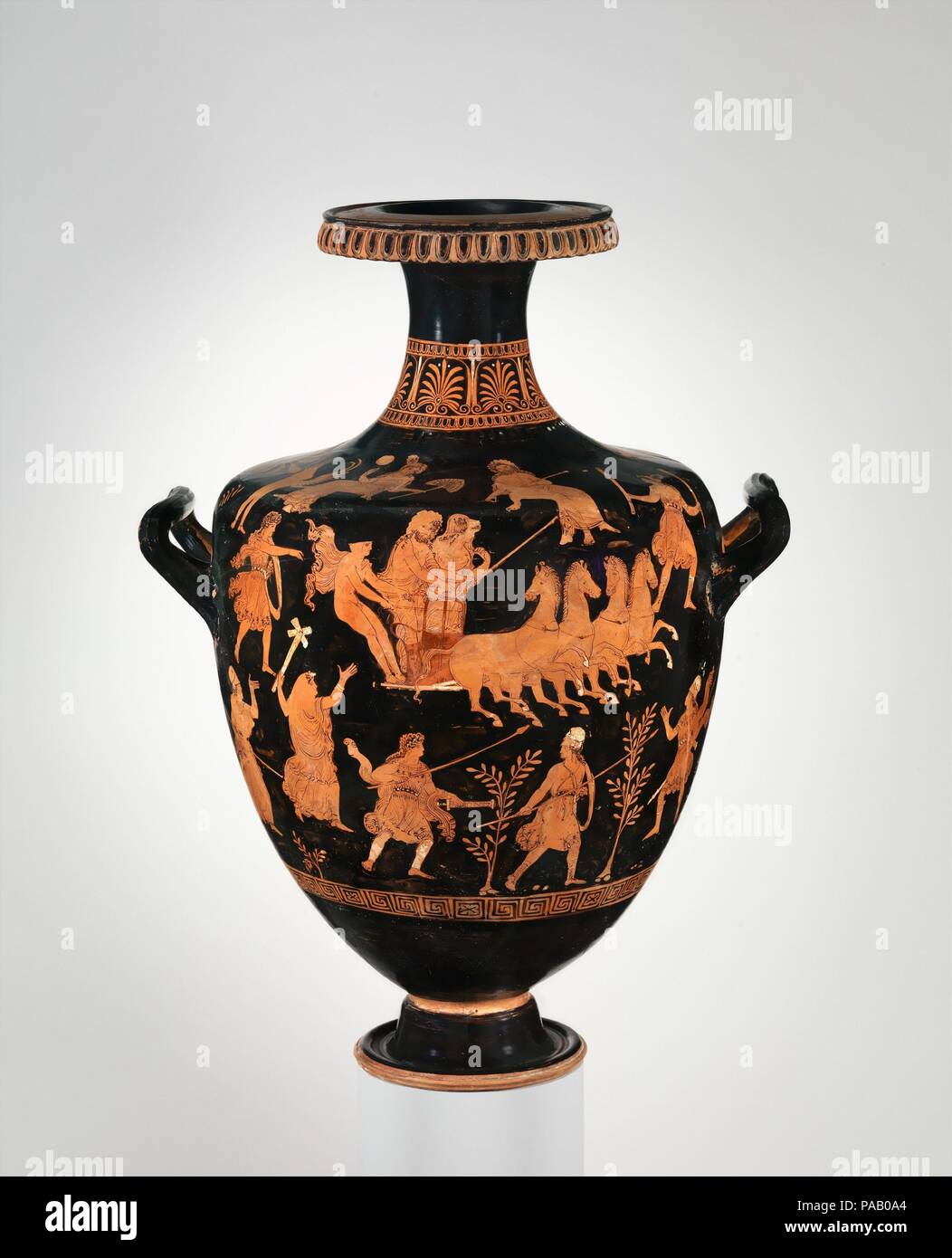 Terracotta hydria (water jar). Culture: Greek, South Italian, Apulian. Dimensions: H. 29 3/4 in. (75.6 cm) diameter 17 3/4 in. (45.1 cm). Date: ca. 340-330 B.C.. The abduction of Persephone by Hades surrounded by gods The myth of the abduction of Persephone was situated in Sicily. Hades' chariot occupies the most prominent area of the vase. All around appear deities connected with the event--Zeus, Hades' brother, whose sanction was needed; Aphrodite and Eros, abettors of Hades' desire; Demeter, Persephone's mother; torch-bearing Hecate; and Athena. The vegetation in the scene and the choic Stock Photohttps://www.alamy.com/image-license-details/?v=1https://www.alamy.com/terracotta-hydria-water-jar-culture-greek-south-italian-apulian-dimensions-h-29-34-in-756-cm-diameter-17-34-in-451-cm-date-ca-340-330-bc-the-abduction-of-persephone-by-hades-surrounded-by-gods-the-myth-of-the-abduction-of-persephone-was-situated-in-sicily-hades-chariot-occupies-the-most-prominent-area-of-the-vase-all-around-appear-deities-connected-with-the-event-zeus-hades-brother-whose-sanction-was-needed-aphrodite-and-eros-abettors-of-hades-desire-demeter-persephones-mother-torch-bearing-hecate-and-athena-the-vegetation-in-the-scene-and-the-choic-image212912732.html
Terracotta hydria (water jar). Culture: Greek, South Italian, Apulian. Dimensions: H. 29 3/4 in. (75.6 cm) diameter 17 3/4 in. (45.1 cm). Date: ca. 340-330 B.C.. The abduction of Persephone by Hades surrounded by gods The myth of the abduction of Persephone was situated in Sicily. Hades' chariot occupies the most prominent area of the vase. All around appear deities connected with the event--Zeus, Hades' brother, whose sanction was needed; Aphrodite and Eros, abettors of Hades' desire; Demeter, Persephone's mother; torch-bearing Hecate; and Athena. The vegetation in the scene and the choic Stock Photohttps://www.alamy.com/image-license-details/?v=1https://www.alamy.com/terracotta-hydria-water-jar-culture-greek-south-italian-apulian-dimensions-h-29-34-in-756-cm-diameter-17-34-in-451-cm-date-ca-340-330-bc-the-abduction-of-persephone-by-hades-surrounded-by-gods-the-myth-of-the-abduction-of-persephone-was-situated-in-sicily-hades-chariot-occupies-the-most-prominent-area-of-the-vase-all-around-appear-deities-connected-with-the-event-zeus-hades-brother-whose-sanction-was-needed-aphrodite-and-eros-abettors-of-hades-desire-demeter-persephones-mother-torch-bearing-hecate-and-athena-the-vegetation-in-the-scene-and-the-choic-image212912732.htmlRMPAB0A4–Terracotta hydria (water jar). Culture: Greek, South Italian, Apulian. Dimensions: H. 29 3/4 in. (75.6 cm) diameter 17 3/4 in. (45.1 cm). Date: ca. 340-330 B.C.. The abduction of Persephone by Hades surrounded by gods The myth of the abduction of Persephone was situated in Sicily. Hades' chariot occupies the most prominent area of the vase. All around appear deities connected with the event--Zeus, Hades' brother, whose sanction was needed; Aphrodite and Eros, abettors of Hades' desire; Demeter, Persephone's mother; torch-bearing Hecate; and Athena. The vegetation in the scene and the choic
 Journal with three vignettes, print maker: Willem Bilderdijk, 1766 - 1785. Reimagined by Gibon. Classic art with a reimagined Stock Photohttps://www.alamy.com/image-license-details/?v=1https://www.alamy.com/journal-with-three-vignettes-print-maker-willem-bilderdijk-1766-1785-reimagined-by-gibon-classic-art-with-a-reimagined-image230462508.html
Journal with three vignettes, print maker: Willem Bilderdijk, 1766 - 1785. Reimagined by Gibon. Classic art with a reimagined Stock Photohttps://www.alamy.com/image-license-details/?v=1https://www.alamy.com/journal-with-three-vignettes-print-maker-willem-bilderdijk-1766-1785-reimagined-by-gibon-classic-art-with-a-reimagined-image230462508.htmlRFRAXD7T–Journal with three vignettes, print maker: Willem Bilderdijk, 1766 - 1785. Reimagined by Gibon. Classic art with a reimagined
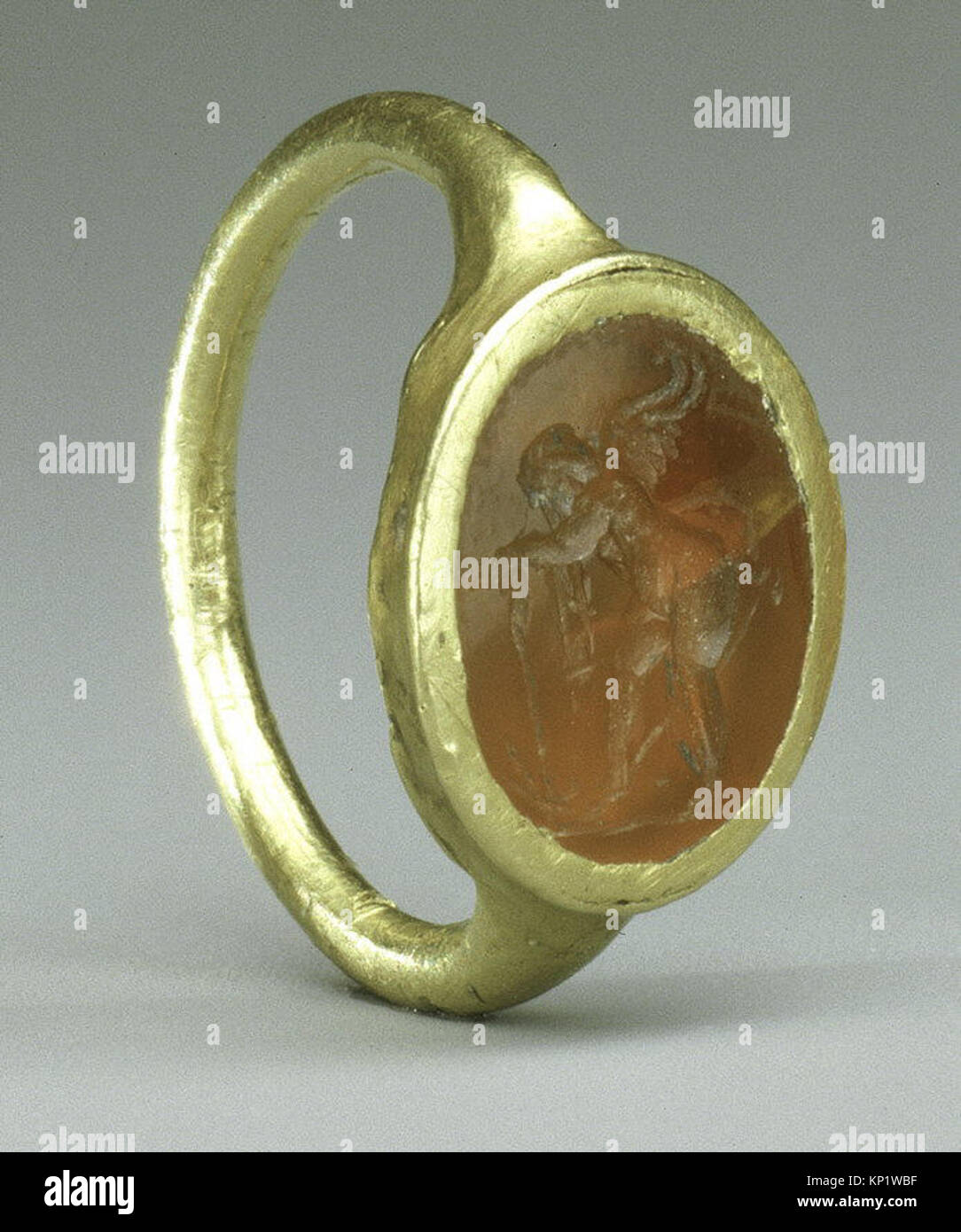 Gold ring with carnelian intaglio- Eros with flaming torch MET GR672 243645 Stock Photohttps://www.alamy.com/image-license-details/?v=1https://www.alamy.com/stock-image-gold-ring-with-carnelian-intaglio-eros-with-flaming-torch-met-gr672-168457619.html
Gold ring with carnelian intaglio- Eros with flaming torch MET GR672 243645 Stock Photohttps://www.alamy.com/image-license-details/?v=1https://www.alamy.com/stock-image-gold-ring-with-carnelian-intaglio-eros-with-flaming-torch-met-gr672-168457619.htmlRMKP1WBF–Gold ring with carnelian intaglio- Eros with flaming torch MET GR672 243645
 Valentine Cupids with vector love hearts and gifts. Cupid angel cartoon characters, Amur or Cherub with Valentine Day hearts, love arrow and letter, w Stock Vectorhttps://www.alamy.com/image-license-details/?v=1https://www.alamy.com/valentine-cupids-with-vector-love-hearts-and-gifts-cupid-angel-cartoon-characters-amur-or-cherub-with-valentine-day-hearts-love-arrow-and-letter-w-image453347369.html
Valentine Cupids with vector love hearts and gifts. Cupid angel cartoon characters, Amur or Cherub with Valentine Day hearts, love arrow and letter, w Stock Vectorhttps://www.alamy.com/image-license-details/?v=1https://www.alamy.com/valentine-cupids-with-vector-love-hearts-and-gifts-cupid-angel-cartoon-characters-amur-or-cherub-with-valentine-day-hearts-love-arrow-and-letter-w-image453347369.htmlRF2H9FN5D–Valentine Cupids with vector love hearts and gifts. Cupid angel cartoon characters, Amur or Cherub with Valentine Day hearts, love arrow and letter, w
 Amor and Putti sharpen their arrows, Anonymous, After Pierre Prud'Hon, 1770 - 1870 print paper etching / engraving (story of) Cupid, Amor (Eros). cupids: 'amores', 'amoretti', 'putti'. torch Stock Photohttps://www.alamy.com/image-license-details/?v=1https://www.alamy.com/amor-and-putti-sharpen-their-arrows-anonymous-after-pierre-prudhon-1770-1870-print-paper-etching-engraving-story-of-cupid-amor-eros-cupids-amores-amoretti-putti-torch-image594091711.html
Amor and Putti sharpen their arrows, Anonymous, After Pierre Prud'Hon, 1770 - 1870 print paper etching / engraving (story of) Cupid, Amor (Eros). cupids: 'amores', 'amoretti', 'putti'. torch Stock Photohttps://www.alamy.com/image-license-details/?v=1https://www.alamy.com/amor-and-putti-sharpen-their-arrows-anonymous-after-pierre-prudhon-1770-1870-print-paper-etching-engraving-story-of-cupid-amor-eros-cupids-amores-amoretti-putti-torch-image594091711.htmlRM2WEF613–Amor and Putti sharpen their arrows, Anonymous, After Pierre Prud'Hon, 1770 - 1870 print paper etching / engraving (story of) Cupid, Amor (Eros). cupids: 'amores', 'amoretti', 'putti'. torch
 Cupid. Classical Mythology. Good of desire. Relief of Cupid with torch burning passion. Roman Art. Maktar. Tunisia. Stock Photohttps://www.alamy.com/image-license-details/?v=1https://www.alamy.com/cupid-classical-mythology-good-of-desire-relief-of-cupid-with-torch-burning-passion-roman-art-maktar-tunisia-image209609131.html
Cupid. Classical Mythology. Good of desire. Relief of Cupid with torch burning passion. Roman Art. Maktar. Tunisia. Stock Photohttps://www.alamy.com/image-license-details/?v=1https://www.alamy.com/cupid-classical-mythology-good-of-desire-relief-of-cupid-with-torch-burning-passion-roman-art-maktar-tunisia-image209609131.htmlRMP50EGB–Cupid. Classical Mythology. Good of desire. Relief of Cupid with torch burning passion. Roman Art. Maktar. Tunisia.
 Two times Amor connected by a ribbon with eachother, print maker: Boëtius Adamsz. Bolswert, M. Reen, 1590 - 1633 reimagined Stock Photohttps://www.alamy.com/image-license-details/?v=1https://www.alamy.com/two-times-amor-connected-by-a-ribbon-with-eachother-print-maker-botius-adamsz-bolswert-m-reen-1590-1633-reimagined-image230474340.html
Two times Amor connected by a ribbon with eachother, print maker: Boëtius Adamsz. Bolswert, M. Reen, 1590 - 1633 reimagined Stock Photohttps://www.alamy.com/image-license-details/?v=1https://www.alamy.com/two-times-amor-connected-by-a-ribbon-with-eachother-print-maker-botius-adamsz-bolswert-m-reen-1590-1633-reimagined-image230474340.htmlRFRAY0AC–Two times Amor connected by a ribbon with eachother, print maker: Boëtius Adamsz. Bolswert, M. Reen, 1590 - 1633 reimagined
 Marble sarcophagus fragment- Eros leaning on a reversed torch MET 145755 Stock Photohttps://www.alamy.com/image-license-details/?v=1https://www.alamy.com/stock-photo-marble-sarcophagus-fragment-eros-leaning-on-a-reversed-torch-met-145755-172263857.html
Marble sarcophagus fragment- Eros leaning on a reversed torch MET 145755 Stock Photohttps://www.alamy.com/image-license-details/?v=1https://www.alamy.com/stock-photo-marble-sarcophagus-fragment-eros-leaning-on-a-reversed-torch-met-145755-172263857.htmlRMM0788H–Marble sarcophagus fragment- Eros leaning on a reversed torch MET 145755
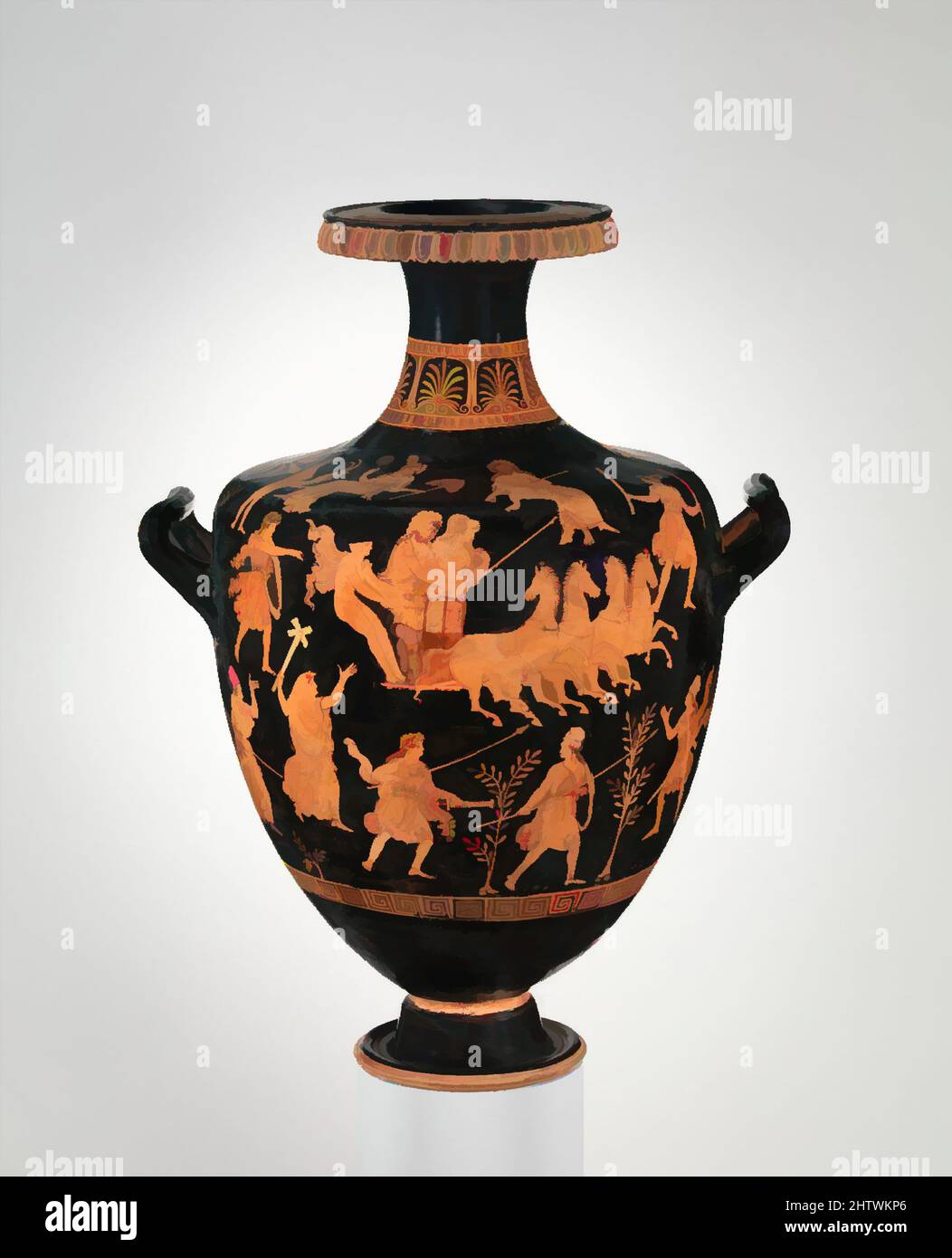 Art inspired by Terracotta hydria (water jar), Late Classical, ca. 340–330 B.C., Greek, South Italian, Apulian, Terracotta; red-figure, H. 29 3/4 in. (75.6 cm), Vases, The abduction of Persephone by Hades surrounded by gods. The myth of the abduction of Persephone was situated in, Classic works modernized by Artotop with a splash of modernity. Shapes, color and value, eye-catching visual impact on art. Emotions through freedom of artworks in a contemporary way. A timeless message pursuing a wildly creative new direction. Artists turning to the digital medium and creating the Artotop NFT Stock Photohttps://www.alamy.com/image-license-details/?v=1https://www.alamy.com/art-inspired-by-terracotta-hydria-water-jar-late-classical-ca-340330-bc-greek-south-italian-apulian-terracotta-red-figure-h-29-34-in-756-cm-vases-the-abduction-of-persephone-by-hades-surrounded-by-gods-the-myth-of-the-abduction-of-persephone-was-situated-in-classic-works-modernized-by-artotop-with-a-splash-of-modernity-shapes-color-and-value-eye-catching-visual-impact-on-art-emotions-through-freedom-of-artworks-in-a-contemporary-way-a-timeless-message-pursuing-a-wildly-creative-new-direction-artists-turning-to-the-digital-medium-and-creating-the-artotop-nft-image462785630.html
Art inspired by Terracotta hydria (water jar), Late Classical, ca. 340–330 B.C., Greek, South Italian, Apulian, Terracotta; red-figure, H. 29 3/4 in. (75.6 cm), Vases, The abduction of Persephone by Hades surrounded by gods. The myth of the abduction of Persephone was situated in, Classic works modernized by Artotop with a splash of modernity. Shapes, color and value, eye-catching visual impact on art. Emotions through freedom of artworks in a contemporary way. A timeless message pursuing a wildly creative new direction. Artists turning to the digital medium and creating the Artotop NFT Stock Photohttps://www.alamy.com/image-license-details/?v=1https://www.alamy.com/art-inspired-by-terracotta-hydria-water-jar-late-classical-ca-340330-bc-greek-south-italian-apulian-terracotta-red-figure-h-29-34-in-756-cm-vases-the-abduction-of-persephone-by-hades-surrounded-by-gods-the-myth-of-the-abduction-of-persephone-was-situated-in-classic-works-modernized-by-artotop-with-a-splash-of-modernity-shapes-color-and-value-eye-catching-visual-impact-on-art-emotions-through-freedom-of-artworks-in-a-contemporary-way-a-timeless-message-pursuing-a-wildly-creative-new-direction-artists-turning-to-the-digital-medium-and-creating-the-artotop-nft-image462785630.htmlRF2HTWKP6–Art inspired by Terracotta hydria (water jar), Late Classical, ca. 340–330 B.C., Greek, South Italian, Apulian, Terracotta; red-figure, H. 29 3/4 in. (75.6 cm), Vases, The abduction of Persephone by Hades surrounded by gods. The myth of the abduction of Persephone was situated in, Classic works modernized by Artotop with a splash of modernity. Shapes, color and value, eye-catching visual impact on art. Emotions through freedom of artworks in a contemporary way. A timeless message pursuing a wildly creative new direction. Artists turning to the digital medium and creating the Artotop NFT
 Vignette with cupido with torch that lights up the blindfold of a sitting man, Noël Le Mire, 1759 print France paper etching (story of) Cupid, Amor (Eros). torch. blindfold Stock Photohttps://www.alamy.com/image-license-details/?v=1https://www.alamy.com/vignette-with-cupido-with-torch-that-lights-up-the-blindfold-of-a-sitting-man-nol-le-mire-1759-print-france-paper-etching-story-of-cupid-amor-eros-torch-blindfold-image595099082.html
Vignette with cupido with torch that lights up the blindfold of a sitting man, Noël Le Mire, 1759 print France paper etching (story of) Cupid, Amor (Eros). torch. blindfold Stock Photohttps://www.alamy.com/image-license-details/?v=1https://www.alamy.com/vignette-with-cupido-with-torch-that-lights-up-the-blindfold-of-a-sitting-man-nol-le-mire-1759-print-france-paper-etching-story-of-cupid-amor-eros-torch-blindfold-image595099082.htmlRM2WG52XJ–Vignette with cupido with torch that lights up the blindfold of a sitting man, Noël Le Mire, 1759 print France paper etching (story of) Cupid, Amor (Eros). torch. blindfold
 Isis-Fortuna holding sisturm, gallops Luno and Cupid with a torch. House of Philocalus. Pompeii, Italy. National Archaeological Museum. Naples. Italy. Stock Photohttps://www.alamy.com/image-license-details/?v=1https://www.alamy.com/isis-fortuna-holding-sisturm-gallops-luno-and-cupid-with-a-torch-house-of-philocalus-pompeii-italy-national-archaeological-museum-naples-italy-image211445075.html
Isis-Fortuna holding sisturm, gallops Luno and Cupid with a torch. House of Philocalus. Pompeii, Italy. National Archaeological Museum. Naples. Italy. Stock Photohttps://www.alamy.com/image-license-details/?v=1https://www.alamy.com/isis-fortuna-holding-sisturm-gallops-luno-and-cupid-with-a-torch-house-of-philocalus-pompeii-italy-national-archaeological-museum-naples-italy-image211445075.htmlRMP8049R–Isis-Fortuna holding sisturm, gallops Luno and Cupid with a torch. House of Philocalus. Pompeii, Italy. National Archaeological Museum. Naples. Italy.
 Glass cameo: Eros holding a torch 1st century B.C.–3rd century A.D. Roman Eros holding an inverted flaming torch.. Glass cameo: Eros holding a torch 249251 Stock Photohttps://www.alamy.com/image-license-details/?v=1https://www.alamy.com/glass-cameo-eros-holding-a-torch-1st-century-bc3rd-century-ad-roman-eros-holding-an-inverted-flaming-torch-glass-cameo-eros-holding-a-torch-249251-image458425758.html
Glass cameo: Eros holding a torch 1st century B.C.–3rd century A.D. Roman Eros holding an inverted flaming torch.. Glass cameo: Eros holding a torch 249251 Stock Photohttps://www.alamy.com/image-license-details/?v=1https://www.alamy.com/glass-cameo-eros-holding-a-torch-1st-century-bc3rd-century-ad-roman-eros-holding-an-inverted-flaming-torch-glass-cameo-eros-holding-a-torch-249251-image458425758.htmlRM2HHR2ME–Glass cameo: Eros holding a torch 1st century B.C.–3rd century A.D. Roman Eros holding an inverted flaming torch.. Glass cameo: Eros holding a torch 249251
 Bronze statuette of Eros running 1st–2nd century A.D. Roman Eros holds a branch in his right hand and once held a torch in his left.. Bronze statuette of Eros running 246683 Stock Photohttps://www.alamy.com/image-license-details/?v=1https://www.alamy.com/bronze-statuette-of-eros-running-1st2nd-century-ad-roman-eros-holds-a-branch-in-his-right-hand-and-once-held-a-torch-in-his-left-bronze-statuette-of-eros-running-246683-image458179985.html
Bronze statuette of Eros running 1st–2nd century A.D. Roman Eros holds a branch in his right hand and once held a torch in his left.. Bronze statuette of Eros running 246683 Stock Photohttps://www.alamy.com/image-license-details/?v=1https://www.alamy.com/bronze-statuette-of-eros-running-1st2nd-century-ad-roman-eros-holds-a-branch-in-his-right-hand-and-once-held-a-torch-in-his-left-bronze-statuette-of-eros-running-246683-image458179985.htmlRM2HHBW6W–Bronze statuette of Eros running 1st–2nd century A.D. Roman Eros holds a branch in his right hand and once held a torch in his left.. Bronze statuette of Eros running 246683
 Photo production of a painting, representing a procession for the temple of Eros, Anonymous, After Herbert Schmalz, c. 1883 - in or before 1888 photograph photographic support albumen print procession Roman religion. (story of) Cupid, Amor (Eros). torch Stock Photohttps://www.alamy.com/image-license-details/?v=1https://www.alamy.com/photo-production-of-a-painting-representing-a-procession-for-the-temple-of-eros-anonymous-after-herbert-schmalz-c-1883-in-or-before-1888-photograph-photographic-support-albumen-print-procession-roman-religion-story-of-cupid-amor-eros-torch-image591379259.html
Photo production of a painting, representing a procession for the temple of Eros, Anonymous, After Herbert Schmalz, c. 1883 - in or before 1888 photograph photographic support albumen print procession Roman religion. (story of) Cupid, Amor (Eros). torch Stock Photohttps://www.alamy.com/image-license-details/?v=1https://www.alamy.com/photo-production-of-a-painting-representing-a-procession-for-the-temple-of-eros-anonymous-after-herbert-schmalz-c-1883-in-or-before-1888-photograph-photographic-support-albumen-print-procession-roman-religion-story-of-cupid-amor-eros-torch-image591379259.htmlRM2WA3J7R–Photo production of a painting, representing a procession for the temple of Eros, Anonymous, After Herbert Schmalz, c. 1883 - in or before 1888 photograph photographic support albumen print procession Roman religion. (story of) Cupid, Amor (Eros). torch
 Roman fresco depicting Cupid with a torch and a kantharos. Villa of the Papyri. Herculaneum. National Archaeological Museum. Naples. Italy. Stock Photohttps://www.alamy.com/image-license-details/?v=1https://www.alamy.com/roman-fresco-depicting-cupid-with-a-torch-and-a-kantharos-villa-of-the-papyri-herculaneum-national-archaeological-museum-naples-italy-image211430961.html
Roman fresco depicting Cupid with a torch and a kantharos. Villa of the Papyri. Herculaneum. National Archaeological Museum. Naples. Italy. Stock Photohttps://www.alamy.com/image-license-details/?v=1https://www.alamy.com/roman-fresco-depicting-cupid-with-a-torch-and-a-kantharos-villa-of-the-papyri-herculaneum-national-archaeological-museum-naples-italy-image211430961.htmlRMP7YE9N–Roman fresco depicting Cupid with a torch and a kantharos. Villa of the Papyri. Herculaneum. National Archaeological Museum. Naples. Italy.
 Amor in an ornamental frame, Anonymous, 1683 - 1783 print Amor with burning torch and arrow in an ornamental frame, in which all kinds of references to love. Couples, among others, pigeons, love couples and horns of abundance. Netherlands paper etching / engraving (story of) Cupid, Amor (Eros). couple of lovers. ornaments art Stock Photohttps://www.alamy.com/image-license-details/?v=1https://www.alamy.com/amor-in-an-ornamental-frame-anonymous-1683-1783-print-amor-with-burning-torch-and-arrow-in-an-ornamental-frame-in-which-all-kinds-of-references-to-love-couples-among-others-pigeons-love-couples-and-horns-of-abundance-netherlands-paper-etching-engraving-story-of-cupid-amor-eros-couple-of-lovers-ornaments-art-image593916446.html
Amor in an ornamental frame, Anonymous, 1683 - 1783 print Amor with burning torch and arrow in an ornamental frame, in which all kinds of references to love. Couples, among others, pigeons, love couples and horns of abundance. Netherlands paper etching / engraving (story of) Cupid, Amor (Eros). couple of lovers. ornaments art Stock Photohttps://www.alamy.com/image-license-details/?v=1https://www.alamy.com/amor-in-an-ornamental-frame-anonymous-1683-1783-print-amor-with-burning-torch-and-arrow-in-an-ornamental-frame-in-which-all-kinds-of-references-to-love-couples-among-others-pigeons-love-couples-and-horns-of-abundance-netherlands-paper-etching-engraving-story-of-cupid-amor-eros-couple-of-lovers-ornaments-art-image593916446.htmlRM2WE76DJ–Amor in an ornamental frame, Anonymous, 1683 - 1783 print Amor with burning torch and arrow in an ornamental frame, in which all kinds of references to love. Couples, among others, pigeons, love couples and horns of abundance. Netherlands paper etching / engraving (story of) Cupid, Amor (Eros). couple of lovers. ornaments art
 'The Four Elements', ca. 1615, Flemish Baroque, Oil on panel, 62 cm x 105 cm, P01399. Author: Brueghel the Elder, jan. Location: MUSEO DEL PRADO-PINTURA. MADRID. SPAIN. Stock Photohttps://www.alamy.com/image-license-details/?v=1https://www.alamy.com/the-four-elements-ca-1615-flemish-baroque-oil-on-panel-62-cm-x-105-cm-p01399-author-brueghel-the-elder-jan-location-museo-del-prado-pintura-madrid-spain-image231176321.html
'The Four Elements', ca. 1615, Flemish Baroque, Oil on panel, 62 cm x 105 cm, P01399. Author: Brueghel the Elder, jan. Location: MUSEO DEL PRADO-PINTURA. MADRID. SPAIN. Stock Photohttps://www.alamy.com/image-license-details/?v=1https://www.alamy.com/the-four-elements-ca-1615-flemish-baroque-oil-on-panel-62-cm-x-105-cm-p01399-author-brueghel-the-elder-jan-location-museo-del-prado-pintura-madrid-spain-image231176321.htmlRMRC2YN5–'The Four Elements', ca. 1615, Flemish Baroque, Oil on panel, 62 cm x 105 cm, P01399. Author: Brueghel the Elder, jan. Location: MUSEO DEL PRADO-PINTURA. MADRID. SPAIN.
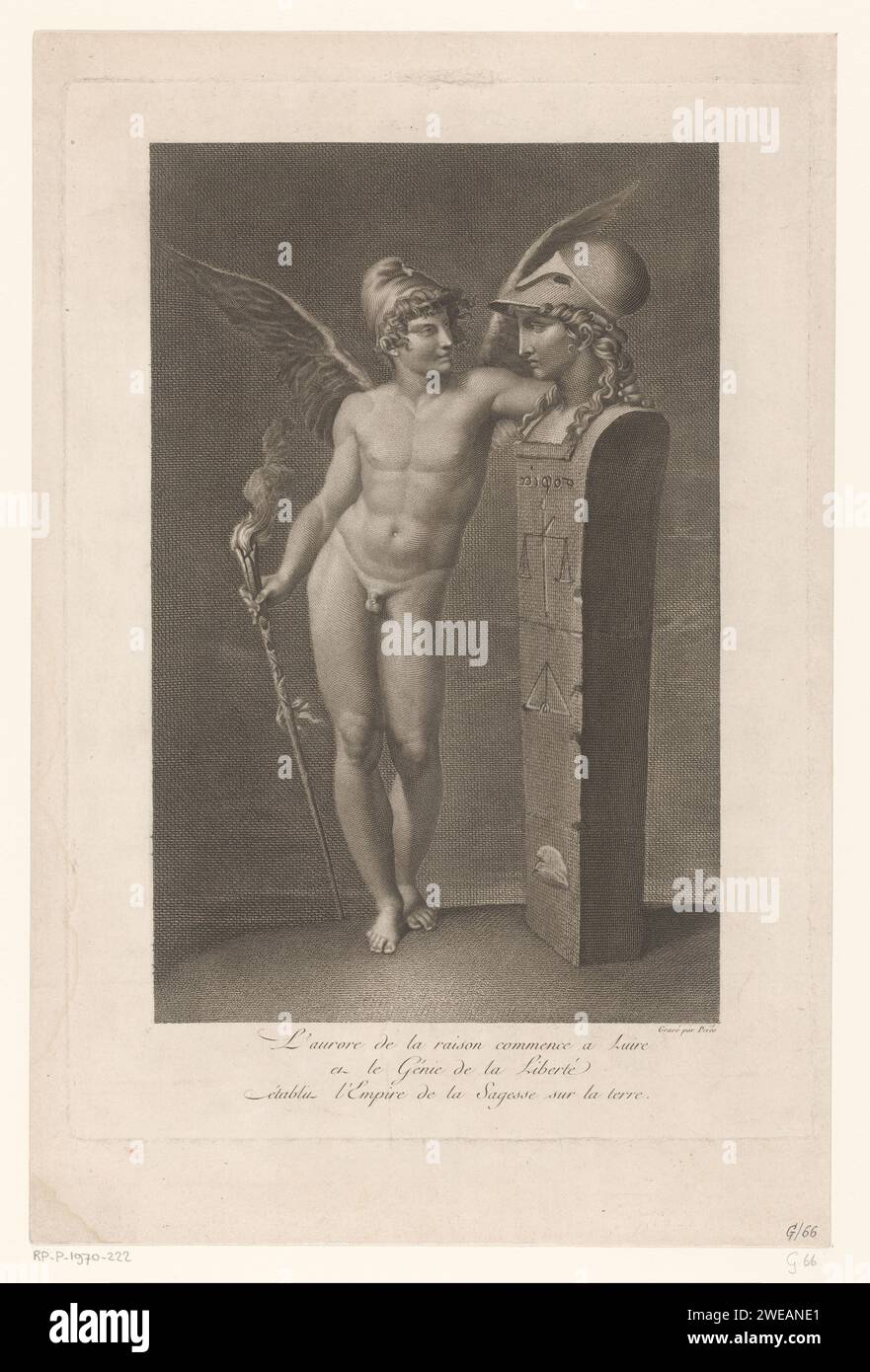 Love and Wisdom, Jacques Louis Pérée, After Pierre Prud'Hon, 1791 - 1879 print paper etching / engraving Torch. (Story of) Cupid, Amor (Eros). (Story of) Minerva (Pallas, Athena). Freedom, Liberty; 'Freedom' (Ripa). Equality, Equity, Faiorss, Righteousness; 'Equality', 'Equity', 'Giuditio Giusto', 'Dritto and just order', 'Equality' (Ripa) Stock Photohttps://www.alamy.com/image-license-details/?v=1https://www.alamy.com/love-and-wisdom-jacques-louis-pre-after-pierre-prudhon-1791-1879-print-paper-etching-engraving-torch-story-of-cupid-amor-eros-story-of-minerva-pallas-athena-freedom-liberty-freedom-ripa-equality-equity-faiorss-righteousness-equality-equity-giuditio-giusto-dritto-and-just-order-equality-ripa-image593994073.html
Love and Wisdom, Jacques Louis Pérée, After Pierre Prud'Hon, 1791 - 1879 print paper etching / engraving Torch. (Story of) Cupid, Amor (Eros). (Story of) Minerva (Pallas, Athena). Freedom, Liberty; 'Freedom' (Ripa). Equality, Equity, Faiorss, Righteousness; 'Equality', 'Equity', 'Giuditio Giusto', 'Dritto and just order', 'Equality' (Ripa) Stock Photohttps://www.alamy.com/image-license-details/?v=1https://www.alamy.com/love-and-wisdom-jacques-louis-pre-after-pierre-prudhon-1791-1879-print-paper-etching-engraving-torch-story-of-cupid-amor-eros-story-of-minerva-pallas-athena-freedom-liberty-freedom-ripa-equality-equity-faiorss-righteousness-equality-equity-giuditio-giusto-dritto-and-just-order-equality-ripa-image593994073.htmlRM2WEANE1–Love and Wisdom, Jacques Louis Pérée, After Pierre Prud'Hon, 1791 - 1879 print paper etching / engraving Torch. (Story of) Cupid, Amor (Eros). (Story of) Minerva (Pallas, Athena). Freedom, Liberty; 'Freedom' (Ripa). Equality, Equity, Faiorss, Righteousness; 'Equality', 'Equity', 'Giuditio Giusto', 'Dritto and just order', 'Equality' (Ripa)
 Bacchus and Ariadne. Date/Period: Ca. 1740-ca. 1742. Painting. Oil on canvas. Height: 650 mm (25.59 in); Width: 755 mm (29.72 in). Author: JACOPO AMIGONI. Stock Photohttps://www.alamy.com/image-license-details/?v=1https://www.alamy.com/bacchus-and-ariadne-dateperiod-ca-1740-ca-1742-painting-oil-on-canvas-height-650-mm-2559-in-width-755-mm-2972-in-author-jacopo-amigoni-image219708430.html
Bacchus and Ariadne. Date/Period: Ca. 1740-ca. 1742. Painting. Oil on canvas. Height: 650 mm (25.59 in); Width: 755 mm (29.72 in). Author: JACOPO AMIGONI. Stock Photohttps://www.alamy.com/image-license-details/?v=1https://www.alamy.com/bacchus-and-ariadne-dateperiod-ca-1740-ca-1742-painting-oil-on-canvas-height-650-mm-2559-in-width-755-mm-2972-in-author-jacopo-amigoni-image219708430.htmlRMPNCG9J–Bacchus and Ariadne. Date/Period: Ca. 1740-ca. 1742. Painting. Oil on canvas. Height: 650 mm (25.59 in); Width: 755 mm (29.72 in). Author: JACOPO AMIGONI.
 Two putti with Toortsen, Jan van Vianen, 1686 print Two putti keep their towers together as a sign of mutual love. Pairs in the background. Love is pure if it is mutual. Second emblem from Emblemata amatoria. Northern Netherlands paper etching (story of) Cupid, Amor (Eros). angel(s) with torch. couple of lovers Stock Photohttps://www.alamy.com/image-license-details/?v=1https://www.alamy.com/two-putti-with-toortsen-jan-van-vianen-1686-print-two-putti-keep-their-towers-together-as-a-sign-of-mutual-love-pairs-in-the-background-love-is-pure-if-it-is-mutual-second-emblem-from-emblemata-amatoria-northern-netherlands-paper-etching-story-of-cupid-amor-eros-angels-with-torch-couple-of-lovers-image593047191.html
Two putti with Toortsen, Jan van Vianen, 1686 print Two putti keep their towers together as a sign of mutual love. Pairs in the background. Love is pure if it is mutual. Second emblem from Emblemata amatoria. Northern Netherlands paper etching (story of) Cupid, Amor (Eros). angel(s) with torch. couple of lovers Stock Photohttps://www.alamy.com/image-license-details/?v=1https://www.alamy.com/two-putti-with-toortsen-jan-van-vianen-1686-print-two-putti-keep-their-towers-together-as-a-sign-of-mutual-love-pairs-in-the-background-love-is-pure-if-it-is-mutual-second-emblem-from-emblemata-amatoria-northern-netherlands-paper-etching-story-of-cupid-amor-eros-angels-with-torch-couple-of-lovers-image593047191.htmlRM2WCRHMR–Two putti with Toortsen, Jan van Vianen, 1686 print Two putti keep their towers together as a sign of mutual love. Pairs in the background. Love is pure if it is mutual. Second emblem from Emblemata amatoria. Northern Netherlands paper etching (story of) Cupid, Amor (Eros). angel(s) with torch. couple of lovers
 Endymion. Date/Period: 1832. Painting. Oil on canvas Oil. Height: 1,270 mm (50 in); Width: 1,015 mm (39.96 in). Author: John Wood. JOHN WOOD (MALER). Stock Photohttps://www.alamy.com/image-license-details/?v=1https://www.alamy.com/endymion-dateperiod-1832-painting-oil-on-canvas-oil-height-1270-mm-50-in-width-1015-mm-3996-in-author-john-wood-john-wood-maler-image219714938.html
Endymion. Date/Period: 1832. Painting. Oil on canvas Oil. Height: 1,270 mm (50 in); Width: 1,015 mm (39.96 in). Author: John Wood. JOHN WOOD (MALER). Stock Photohttps://www.alamy.com/image-license-details/?v=1https://www.alamy.com/endymion-dateperiod-1832-painting-oil-on-canvas-oil-height-1270-mm-50-in-width-1015-mm-3996-in-author-john-wood-john-wood-maler-image219714938.htmlRMPNCTJ2–Endymion. Date/Period: 1832. Painting. Oil on canvas Oil. Height: 1,270 mm (50 in); Width: 1,015 mm (39.96 in). Author: John Wood. JOHN WOOD (MALER).
 Amor with burning torch / salamander surrounded by fire, Michiel le Blon, 1616 print Two performances of one plate. Left: Amor stands with a burning torch in his hands that he holds up. Right: a salamander surrounded by fire. paper engraving (story of) Cupid, Amor (Eros). torch. salamander (fabulous animal); salamander as spirit of fire Stock Photohttps://www.alamy.com/image-license-details/?v=1https://www.alamy.com/amor-with-burning-torch-salamander-surrounded-by-fire-michiel-le-blon-1616-print-two-performances-of-one-plate-left-amor-stands-with-a-burning-torch-in-his-hands-that-he-holds-up-right-a-salamander-surrounded-by-fire-paper-engraving-story-of-cupid-amor-eros-torch-salamander-fabulous-animal-salamander-as-spirit-of-fire-image592894233.html
Amor with burning torch / salamander surrounded by fire, Michiel le Blon, 1616 print Two performances of one plate. Left: Amor stands with a burning torch in his hands that he holds up. Right: a salamander surrounded by fire. paper engraving (story of) Cupid, Amor (Eros). torch. salamander (fabulous animal); salamander as spirit of fire Stock Photohttps://www.alamy.com/image-license-details/?v=1https://www.alamy.com/amor-with-burning-torch-salamander-surrounded-by-fire-michiel-le-blon-1616-print-two-performances-of-one-plate-left-amor-stands-with-a-burning-torch-in-his-hands-that-he-holds-up-right-a-salamander-surrounded-by-fire-paper-engraving-story-of-cupid-amor-eros-torch-salamander-fabulous-animal-salamander-as-spirit-of-fire-image592894233.htmlRM2WCGJJ1–Amor with burning torch / salamander surrounded by fire, Michiel le Blon, 1616 print Two performances of one plate. Left: Amor stands with a burning torch in his hands that he holds up. Right: a salamander surrounded by fire. paper engraving (story of) Cupid, Amor (Eros). torch. salamander (fabulous animal); salamander as spirit of fire
 Roman art. Sarcophagus with a marriage scene. 2nd. century. Relief. Marble. The State Hermitage Museum. Saint Petersburg. Russia. Stock Photohttps://www.alamy.com/image-license-details/?v=1https://www.alamy.com/roman-art-sarcophagus-with-a-marriage-scene-2nd-century-relief-marble-the-state-hermitage-museum-saint-petersburg-russia-image211170099.html
Roman art. Sarcophagus with a marriage scene. 2nd. century. Relief. Marble. The State Hermitage Museum. Saint Petersburg. Russia. Stock Photohttps://www.alamy.com/image-license-details/?v=1https://www.alamy.com/roman-art-sarcophagus-with-a-marriage-scene-2nd-century-relief-marble-the-state-hermitage-museum-saint-petersburg-russia-image211170099.htmlRMP7FHH7–Roman art. Sarcophagus with a marriage scene. 2nd. century. Relief. Marble. The State Hermitage Museum. Saint Petersburg. Russia.
 Selene and Endymion, Gerard de Lairesse, c. 1680 painting Selene and Endymion. Cupido with a burning torch points Selene (or Diana) to the sleeping endymion. Behind the moon goddess the moon shines in the sky between the clouds. canvas. oil paint (paint) Diana (Luna) visiting the sleeping Endymion. (story of) Cupid, Amor (Eros). full moon Soestdijk Palace Stock Photohttps://www.alamy.com/image-license-details/?v=1https://www.alamy.com/selene-and-endymion-gerard-de-lairesse-c-1680-painting-selene-and-endymion-cupido-with-a-burning-torch-points-selene-or-diana-to-the-sleeping-endymion-behind-the-moon-goddess-the-moon-shines-in-the-sky-between-the-clouds-canvas-oil-paint-paint-diana-luna-visiting-the-sleeping-endymion-story-of-cupid-amor-eros-full-moon-soestdijk-palace-image595575135.html
Selene and Endymion, Gerard de Lairesse, c. 1680 painting Selene and Endymion. Cupido with a burning torch points Selene (or Diana) to the sleeping endymion. Behind the moon goddess the moon shines in the sky between the clouds. canvas. oil paint (paint) Diana (Luna) visiting the sleeping Endymion. (story of) Cupid, Amor (Eros). full moon Soestdijk Palace Stock Photohttps://www.alamy.com/image-license-details/?v=1https://www.alamy.com/selene-and-endymion-gerard-de-lairesse-c-1680-painting-selene-and-endymion-cupido-with-a-burning-torch-points-selene-or-diana-to-the-sleeping-endymion-behind-the-moon-goddess-the-moon-shines-in-the-sky-between-the-clouds-canvas-oil-paint-paint-diana-luna-visiting-the-sleeping-endymion-story-of-cupid-amor-eros-full-moon-soestdijk-palace-image595575135.htmlRM2WGXP4F–Selene and Endymion, Gerard de Lairesse, c. 1680 painting Selene and Endymion. Cupido with a burning torch points Selene (or Diana) to the sleeping endymion. Behind the moon goddess the moon shines in the sky between the clouds. canvas. oil paint (paint) Diana (Luna) visiting the sleeping Endymion. (story of) Cupid, Amor (Eros). full moon Soestdijk Palace
 Amphitrite on a hippocampus with Hymenaeus and Tritons. Detail. Mosaic at the Baths of Neptune. 2nd century. Ostia Antica. Italy. Stock Photohttps://www.alamy.com/image-license-details/?v=1https://www.alamy.com/amphitrite-on-a-hippocampus-with-hymenaeus-and-tritons-detail-mosaic-at-the-baths-of-neptune-2nd-century-ostia-antica-italy-image209605280.html
Amphitrite on a hippocampus with Hymenaeus and Tritons. Detail. Mosaic at the Baths of Neptune. 2nd century. Ostia Antica. Italy. Stock Photohttps://www.alamy.com/image-license-details/?v=1https://www.alamy.com/amphitrite-on-a-hippocampus-with-hymenaeus-and-tritons-detail-mosaic-at-the-baths-of-neptune-2nd-century-ostia-antica-italy-image209605280.htmlRMP509JT–Amphitrite on a hippocampus with Hymenaeus and Tritons. Detail. Mosaic at the Baths of Neptune. 2nd century. Ostia Antica. Italy.
 Leaf with three Vignetten, Willem Bilderdijk, 1766 - 1785 print Leaf with three vignettes placed one above the other: Amor with burning torch on which flies come, head of a woman and as a third vignette at the bottom of a jug with bowls. Netherlands paper etching (story of) Cupid, Amor (Eros). torch. dish, plate, saucer. head (human). vignette Stock Photohttps://www.alamy.com/image-license-details/?v=1https://www.alamy.com/leaf-with-three-vignetten-willem-bilderdijk-1766-1785-print-leaf-with-three-vignettes-placed-one-above-the-other-amor-with-burning-torch-on-which-flies-come-head-of-a-woman-and-as-a-third-vignette-at-the-bottom-of-a-jug-with-bowls-netherlands-paper-etching-story-of-cupid-amor-eros-torch-dish-plate-saucer-head-human-vignette-image592815669.html
Leaf with three Vignetten, Willem Bilderdijk, 1766 - 1785 print Leaf with three vignettes placed one above the other: Amor with burning torch on which flies come, head of a woman and as a third vignette at the bottom of a jug with bowls. Netherlands paper etching (story of) Cupid, Amor (Eros). torch. dish, plate, saucer. head (human). vignette Stock Photohttps://www.alamy.com/image-license-details/?v=1https://www.alamy.com/leaf-with-three-vignetten-willem-bilderdijk-1766-1785-print-leaf-with-three-vignettes-placed-one-above-the-other-amor-with-burning-torch-on-which-flies-come-head-of-a-woman-and-as-a-third-vignette-at-the-bottom-of-a-jug-with-bowls-netherlands-paper-etching-story-of-cupid-amor-eros-torch-dish-plate-saucer-head-human-vignette-image592815669.htmlRM2WCD2C5–Leaf with three Vignetten, Willem Bilderdijk, 1766 - 1785 print Leaf with three vignettes placed one above the other: Amor with burning torch on which flies come, head of a woman and as a third vignette at the bottom of a jug with bowls. Netherlands paper etching (story of) Cupid, Amor (Eros). torch. dish, plate, saucer. head (human). vignette
 Amphitrite on a hippocampus with Hymenaeus and Tritons. Detail. Mosaic at the Baths of Neptune. 2nd century. Ostia Antica. Italy. Stock Photohttps://www.alamy.com/image-license-details/?v=1https://www.alamy.com/amphitrite-on-a-hippocampus-with-hymenaeus-and-tritons-detail-mosaic-at-the-baths-of-neptune-2nd-century-ostia-antica-italy-image209567543.html
Amphitrite on a hippocampus with Hymenaeus and Tritons. Detail. Mosaic at the Baths of Neptune. 2nd century. Ostia Antica. Italy. Stock Photohttps://www.alamy.com/image-license-details/?v=1https://www.alamy.com/amphitrite-on-a-hippocampus-with-hymenaeus-and-tritons-detail-mosaic-at-the-baths-of-neptune-2nd-century-ostia-antica-italy-image209567543.htmlRMP4XHF3–Amphitrite on a hippocampus with Hymenaeus and Tritons. Detail. Mosaic at the Baths of Neptune. 2nd century. Ostia Antica. Italy.
 Two love gods (Amor) connected by a ribbon, Boëtius Adamsz. Bolswert, After M. Reen, 1590 - 1633 print Two love gods (Amor) are connected by a ribbon. One holds a burning torch the other blows on a trumpet. Under the show is a Latin verse. paper engraving (story of) Cupid, Amor (Eros). attributes of Cupid (with NAME) Stock Photohttps://www.alamy.com/image-license-details/?v=1https://www.alamy.com/two-love-gods-amor-connected-by-a-ribbon-botius-adamsz-bolswert-after-m-reen-1590-1633-print-two-love-gods-amor-are-connected-by-a-ribbon-one-holds-a-burning-torch-the-other-blows-on-a-trumpet-under-the-show-is-a-latin-verse-paper-engraving-story-of-cupid-amor-eros-attributes-of-cupid-with-name-image592925798.html
Two love gods (Amor) connected by a ribbon, Boëtius Adamsz. Bolswert, After M. Reen, 1590 - 1633 print Two love gods (Amor) are connected by a ribbon. One holds a burning torch the other blows on a trumpet. Under the show is a Latin verse. paper engraving (story of) Cupid, Amor (Eros). attributes of Cupid (with NAME) Stock Photohttps://www.alamy.com/image-license-details/?v=1https://www.alamy.com/two-love-gods-amor-connected-by-a-ribbon-botius-adamsz-bolswert-after-m-reen-1590-1633-print-two-love-gods-amor-are-connected-by-a-ribbon-one-holds-a-burning-torch-the-other-blows-on-a-trumpet-under-the-show-is-a-latin-verse-paper-engraving-story-of-cupid-amor-eros-attributes-of-cupid-with-name-image592925798.htmlRM2WCJ2WA–Two love gods (Amor) connected by a ribbon, Boëtius Adamsz. Bolswert, After M. Reen, 1590 - 1633 print Two love gods (Amor) are connected by a ribbon. One holds a burning torch the other blows on a trumpet. Under the show is a Latin verse. paper engraving (story of) Cupid, Amor (Eros). attributes of Cupid (with NAME)
 Roman art. Sarcophagus with a marriage scene. 2nd. century. Front. Relief. Marble. The State Hermitage Museum. Saint Petersburg. Russia. Stock Photohttps://www.alamy.com/image-license-details/?v=1https://www.alamy.com/roman-art-sarcophagus-with-a-marriage-scene-2nd-century-front-relief-marble-the-state-hermitage-museum-saint-petersburg-russia-image211170101.html
Roman art. Sarcophagus with a marriage scene. 2nd. century. Front. Relief. Marble. The State Hermitage Museum. Saint Petersburg. Russia. Stock Photohttps://www.alamy.com/image-license-details/?v=1https://www.alamy.com/roman-art-sarcophagus-with-a-marriage-scene-2nd-century-front-relief-marble-the-state-hermitage-museum-saint-petersburg-russia-image211170101.htmlRMP7FHH9–Roman art. Sarcophagus with a marriage scene. 2nd. century. Front. Relief. Marble. The State Hermitage Museum. Saint Petersburg. Russia.
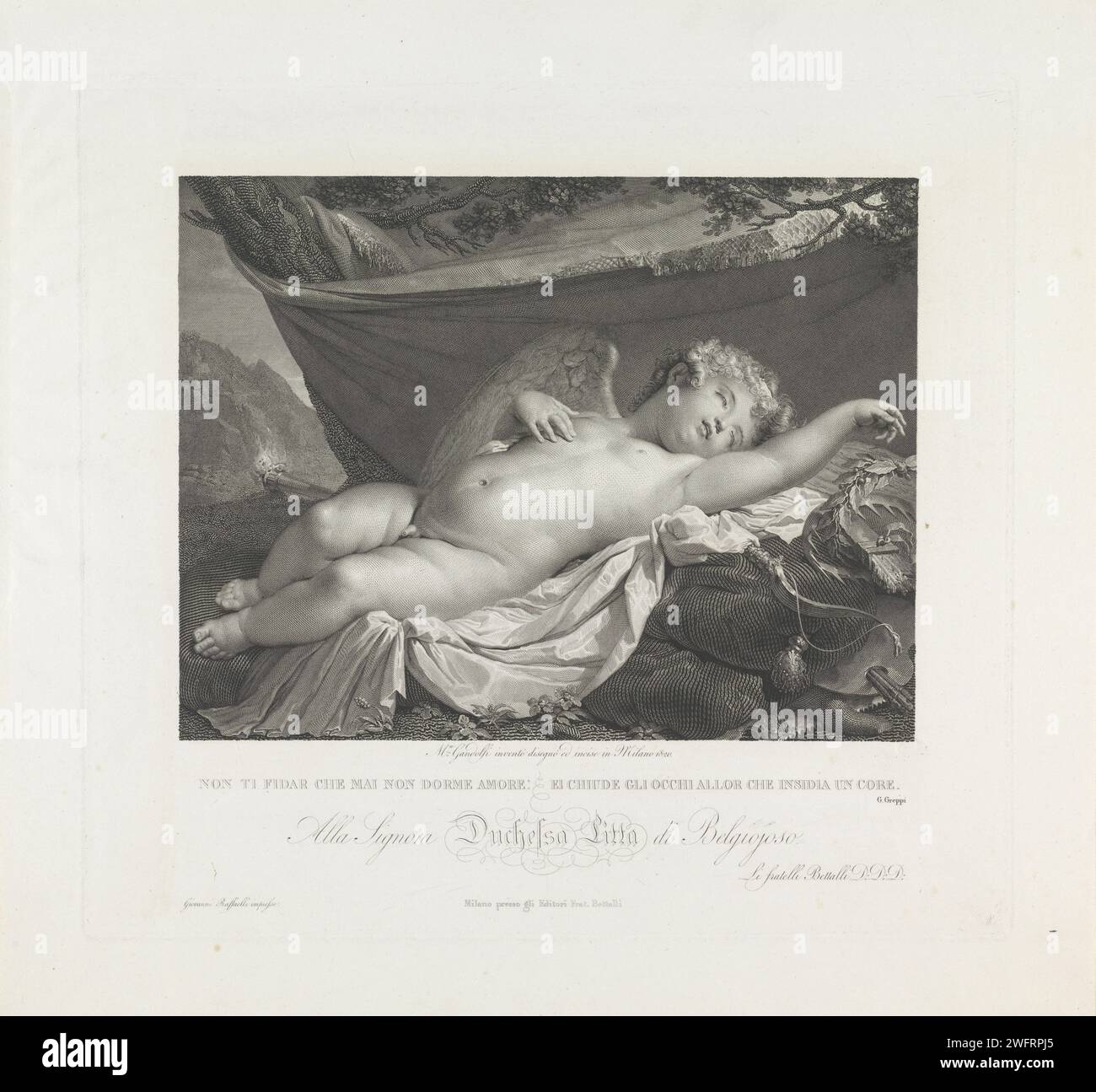 Slatande Amor, Mauro Gandolfi, 1820 print The sleeping amor in a landscape. Behind him is a burning torch. There are arrows and arch, a painting palette with brushes and a laurel wreath. print maker: Italyafter own design by: Italyprinter: Italypublisher: MilaanMilaanItaly paper engraving sleeping; unconsciousness. (story of) Cupid, Amor (Eros). sleeping Cupid; possibly signifying a slackening of Love's influence Stock Photohttps://www.alamy.com/image-license-details/?v=1https://www.alamy.com/slatande-amor-mauro-gandolfi-1820-print-the-sleeping-amor-in-a-landscape-behind-him-is-a-burning-torch-there-are-arrows-and-arch-a-painting-palette-with-brushes-and-a-laurel-wreath-print-maker-italyafter-own-design-by-italyprinter-italypublisher-milaanmilaanitaly-paper-engraving-sleeping-unconsciousness-story-of-cupid-amor-eros-sleeping-cupid-possibly-signifying-a-slackening-of-loves-influence-image594895005.html
Slatande Amor, Mauro Gandolfi, 1820 print The sleeping amor in a landscape. Behind him is a burning torch. There are arrows and arch, a painting palette with brushes and a laurel wreath. print maker: Italyafter own design by: Italyprinter: Italypublisher: MilaanMilaanItaly paper engraving sleeping; unconsciousness. (story of) Cupid, Amor (Eros). sleeping Cupid; possibly signifying a slackening of Love's influence Stock Photohttps://www.alamy.com/image-license-details/?v=1https://www.alamy.com/slatande-amor-mauro-gandolfi-1820-print-the-sleeping-amor-in-a-landscape-behind-him-is-a-burning-torch-there-are-arrows-and-arch-a-painting-palette-with-brushes-and-a-laurel-wreath-print-maker-italyafter-own-design-by-italyprinter-italypublisher-milaanmilaanitaly-paper-engraving-sleeping-unconsciousness-story-of-cupid-amor-eros-sleeping-cupid-possibly-signifying-a-slackening-of-loves-influence-image594895005.htmlRM2WFRPJ5–Slatande Amor, Mauro Gandolfi, 1820 print The sleeping amor in a landscape. Behind him is a burning torch. There are arrows and arch, a painting palette with brushes and a laurel wreath. print maker: Italyafter own design by: Italyprinter: Italypublisher: MilaanMilaanItaly paper engraving sleeping; unconsciousness. (story of) Cupid, Amor (Eros). sleeping Cupid; possibly signifying a slackening of Love's influence
 Bading women and men, Justus Sadeler (attributed to), after paolo fiammingo, c. 1589 - c. 1595 print Forest landscape with a river in which a group of men and a group of women are bathing. In the foreground Amor with a burning torch among the bathing women. Italian fresh in the lower margin. Italy paper engraving public baths - AA - in the open air. (story of) Cupid, Amor (Eros) Stock Photohttps://www.alamy.com/image-license-details/?v=1https://www.alamy.com/bading-women-and-men-justus-sadeler-attributed-to-after-paolo-fiammingo-c-1589-c-1595-print-forest-landscape-with-a-river-in-which-a-group-of-men-and-a-group-of-women-are-bathing-in-the-foreground-amor-with-a-burning-torch-among-the-bathing-women-italian-fresh-in-the-lower-margin-italy-paper-engraving-public-baths-aa-in-the-open-air-story-of-cupid-amor-eros-image594097504.html
Bading women and men, Justus Sadeler (attributed to), after paolo fiammingo, c. 1589 - c. 1595 print Forest landscape with a river in which a group of men and a group of women are bathing. In the foreground Amor with a burning torch among the bathing women. Italian fresh in the lower margin. Italy paper engraving public baths - AA - in the open air. (story of) Cupid, Amor (Eros) Stock Photohttps://www.alamy.com/image-license-details/?v=1https://www.alamy.com/bading-women-and-men-justus-sadeler-attributed-to-after-paolo-fiammingo-c-1589-c-1595-print-forest-landscape-with-a-river-in-which-a-group-of-men-and-a-group-of-women-are-bathing-in-the-foreground-amor-with-a-burning-torch-among-the-bathing-women-italian-fresh-in-the-lower-margin-italy-paper-engraving-public-baths-aa-in-the-open-air-story-of-cupid-amor-eros-image594097504.htmlRM2WEFDC0–Bading women and men, Justus Sadeler (attributed to), after paolo fiammingo, c. 1589 - c. 1595 print Forest landscape with a river in which a group of men and a group of women are bathing. In the foreground Amor with a burning torch among the bathing women. Italian fresh in the lower margin. Italy paper engraving public baths - AA - in the open air. (story of) Cupid, Amor (Eros)
 Bading women and men, Justus Sadeler (attributed to), after paolo fiammingo, c. 1589 - c. 1595 print Forest landscape with a river in which a group of men and a group of women are bathing. In the foreground Amor with a burning torch among the bathing women. Italian fresh in the lower margin. Italy paper engraving public baths - AA - in the open air. (story of) Cupid, Amor (Eros) Stock Photohttps://www.alamy.com/image-license-details/?v=1https://www.alamy.com/bading-women-and-men-justus-sadeler-attributed-to-after-paolo-fiammingo-c-1589-c-1595-print-forest-landscape-with-a-river-in-which-a-group-of-men-and-a-group-of-women-are-bathing-in-the-foreground-amor-with-a-burning-torch-among-the-bathing-women-italian-fresh-in-the-lower-margin-italy-paper-engraving-public-baths-aa-in-the-open-air-story-of-cupid-amor-eros-image594914761.html
Bading women and men, Justus Sadeler (attributed to), after paolo fiammingo, c. 1589 - c. 1595 print Forest landscape with a river in which a group of men and a group of women are bathing. In the foreground Amor with a burning torch among the bathing women. Italian fresh in the lower margin. Italy paper engraving public baths - AA - in the open air. (story of) Cupid, Amor (Eros) Stock Photohttps://www.alamy.com/image-license-details/?v=1https://www.alamy.com/bading-women-and-men-justus-sadeler-attributed-to-after-paolo-fiammingo-c-1589-c-1595-print-forest-landscape-with-a-river-in-which-a-group-of-men-and-a-group-of-women-are-bathing-in-the-foreground-amor-with-a-burning-torch-among-the-bathing-women-italian-fresh-in-the-lower-margin-italy-paper-engraving-public-baths-aa-in-the-open-air-story-of-cupid-amor-eros-image594914761.htmlRM2WFTKRN–Bading women and men, Justus Sadeler (attributed to), after paolo fiammingo, c. 1589 - c. 1595 print Forest landscape with a river in which a group of men and a group of women are bathing. In the foreground Amor with a burning torch among the bathing women. Italian fresh in the lower margin. Italy paper engraving public baths - AA - in the open air. (story of) Cupid, Amor (Eros)
 Brave Love, Pieter Serwouters, 1606 - 1611 drawing Amour Vaillant: Cupido keeps a standing guard with a long burning torch, in the background a love couple. Design for a print. paper pen / brush (Personifications and Symbolic Representations of) Love; 'Love (according to Seneca)' (Ripa). Alertness, vigilance; 'Guardia', 'Vigilance', 'Supervision to defend yourself & oppose others' (Ripa). (Story of) Cupid, Amor (Eros) Stock Photohttps://www.alamy.com/image-license-details/?v=1https://www.alamy.com/brave-love-pieter-serwouters-1606-1611-drawing-amour-vaillant-cupido-keeps-a-standing-guard-with-a-long-burning-torch-in-the-background-a-love-couple-design-for-a-print-paper-pen-brush-personifications-and-symbolic-representations-of-love-love-according-to-seneca-ripa-alertness-vigilance-guardia-vigilance-supervision-to-defend-yourself-oppose-others-ripa-story-of-cupid-amor-eros-image595598722.html
Brave Love, Pieter Serwouters, 1606 - 1611 drawing Amour Vaillant: Cupido keeps a standing guard with a long burning torch, in the background a love couple. Design for a print. paper pen / brush (Personifications and Symbolic Representations of) Love; 'Love (according to Seneca)' (Ripa). Alertness, vigilance; 'Guardia', 'Vigilance', 'Supervision to defend yourself & oppose others' (Ripa). (Story of) Cupid, Amor (Eros) Stock Photohttps://www.alamy.com/image-license-details/?v=1https://www.alamy.com/brave-love-pieter-serwouters-1606-1611-drawing-amour-vaillant-cupido-keeps-a-standing-guard-with-a-long-burning-torch-in-the-background-a-love-couple-design-for-a-print-paper-pen-brush-personifications-and-symbolic-representations-of-love-love-according-to-seneca-ripa-alertness-vigilance-guardia-vigilance-supervision-to-defend-yourself-oppose-others-ripa-story-of-cupid-amor-eros-image595598722.htmlRM2WGYT6X–Brave Love, Pieter Serwouters, 1606 - 1611 drawing Amour Vaillant: Cupido keeps a standing guard with a long burning torch, in the background a love couple. Design for a print. paper pen / brush (Personifications and Symbolic Representations of) Love; 'Love (according to Seneca)' (Ripa). Alertness, vigilance; 'Guardia', 'Vigilance', 'Supervision to defend yourself & oppose others' (Ripa). (Story of) Cupid, Amor (Eros)
 Three performances of events from the newer history, Daniel Nikolaus Chodowiecki, 1792 print The prints are numbered at the top right. With caption in German and French. Berlin paper etching History. betrothal and marriage. (story of) Cupid, Amor (Eros). torch. garland, wreath. Freedom, Liberty; 'Libertà' (Ripa). ruler, sovereign. symbolic representations, allegories and emblems art; 'Arte' (Ripa). trade, commerce and finance. war. Asiatic races and peoples: Turks. Aesculapian sign. peace Stock Photohttps://www.alamy.com/image-license-details/?v=1https://www.alamy.com/three-performances-of-events-from-the-newer-history-daniel-nikolaus-chodowiecki-1792-print-the-prints-are-numbered-at-the-top-right-with-caption-in-german-and-french-berlin-paper-etching-history-betrothal-and-marriage-story-of-cupid-amor-eros-torch-garland-wreath-freedom-liberty-libert-ripa-ruler-sovereign-symbolic-representations-allegories-and-emblems-art-arte-ripa-trade-commerce-and-finance-war-asiatic-races-and-peoples-turks-aesculapian-sign-peace-image594762167.html
Three performances of events from the newer history, Daniel Nikolaus Chodowiecki, 1792 print The prints are numbered at the top right. With caption in German and French. Berlin paper etching History. betrothal and marriage. (story of) Cupid, Amor (Eros). torch. garland, wreath. Freedom, Liberty; 'Libertà' (Ripa). ruler, sovereign. symbolic representations, allegories and emblems art; 'Arte' (Ripa). trade, commerce and finance. war. Asiatic races and peoples: Turks. Aesculapian sign. peace Stock Photohttps://www.alamy.com/image-license-details/?v=1https://www.alamy.com/three-performances-of-events-from-the-newer-history-daniel-nikolaus-chodowiecki-1792-print-the-prints-are-numbered-at-the-top-right-with-caption-in-german-and-french-berlin-paper-etching-history-betrothal-and-marriage-story-of-cupid-amor-eros-torch-garland-wreath-freedom-liberty-libert-ripa-ruler-sovereign-symbolic-representations-allegories-and-emblems-art-arte-ripa-trade-commerce-and-finance-war-asiatic-races-and-peoples-turks-aesculapian-sign-peace-image594762167.htmlRM2WFHN5Y–Three performances of events from the newer history, Daniel Nikolaus Chodowiecki, 1792 print The prints are numbered at the top right. With caption in German and French. Berlin paper etching History. betrothal and marriage. (story of) Cupid, Amor (Eros). torch. garland, wreath. Freedom, Liberty; 'Libertà' (Ripa). ruler, sovereign. symbolic representations, allegories and emblems art; 'Arte' (Ripa). trade, commerce and finance. war. Asiatic races and peoples: Turks. Aesculapian sign. peace
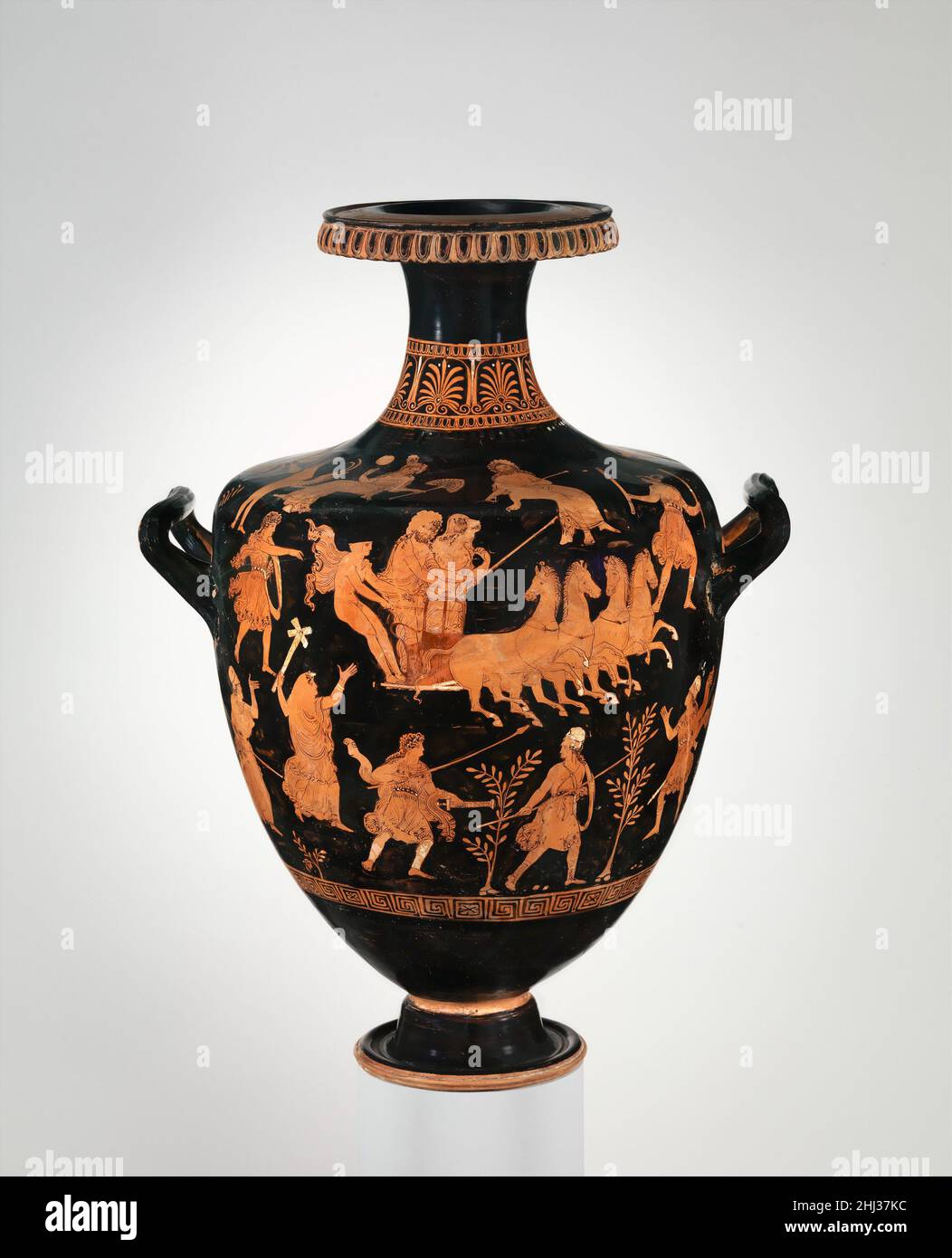 Terracotta hydria (water jar) ca. 340–330 B.C. Attributed to the Group of B.M. F 308 The abduction of Persephone by Hades surrounded by godsThe myth of the abduction of Persephone was situated in Sicily. Hades’ chariot occupies the most prominent area of the vase. All around appear deities connected with the event—Zeus, Hades’ brother, whose sanction was needed; Aphrodite and Eros, abettors of Hades’ desire; Demeter, Persephone’s mother; torch-bearing Hecate; and Athena. The vegetation in the scene and the choice of a water jar as the shape emphasize the aspect of fertility in the story. Mytho Stock Photohttps://www.alamy.com/image-license-details/?v=1https://www.alamy.com/terracotta-hydria-water-jar-ca-340330-bc-attributed-to-the-group-of-bm-f-308-the-abduction-of-persephone-by-hades-surrounded-by-godsthe-myth-of-the-abduction-of-persephone-was-situated-in-sicily-hades-chariot-occupies-the-most-prominent-area-of-the-vase-all-around-appear-deities-connected-with-the-eventzeus-hades-brother-whose-sanction-was-needed-aphrodite-and-eros-abettors-of-hades-desire-demeter-persephones-mother-torch-bearing-hecate-and-athena-the-vegetation-in-the-scene-and-the-choice-of-a-water-jar-as-the-shape-emphasize-the-aspect-of-fertility-in-the-story-mytho-image458605264.html
Terracotta hydria (water jar) ca. 340–330 B.C. Attributed to the Group of B.M. F 308 The abduction of Persephone by Hades surrounded by godsThe myth of the abduction of Persephone was situated in Sicily. Hades’ chariot occupies the most prominent area of the vase. All around appear deities connected with the event—Zeus, Hades’ brother, whose sanction was needed; Aphrodite and Eros, abettors of Hades’ desire; Demeter, Persephone’s mother; torch-bearing Hecate; and Athena. The vegetation in the scene and the choice of a water jar as the shape emphasize the aspect of fertility in the story. Mytho Stock Photohttps://www.alamy.com/image-license-details/?v=1https://www.alamy.com/terracotta-hydria-water-jar-ca-340330-bc-attributed-to-the-group-of-bm-f-308-the-abduction-of-persephone-by-hades-surrounded-by-godsthe-myth-of-the-abduction-of-persephone-was-situated-in-sicily-hades-chariot-occupies-the-most-prominent-area-of-the-vase-all-around-appear-deities-connected-with-the-eventzeus-hades-brother-whose-sanction-was-needed-aphrodite-and-eros-abettors-of-hades-desire-demeter-persephones-mother-torch-bearing-hecate-and-athena-the-vegetation-in-the-scene-and-the-choice-of-a-water-jar-as-the-shape-emphasize-the-aspect-of-fertility-in-the-story-mytho-image458605264.htmlRM2HJ37KC–Terracotta hydria (water jar) ca. 340–330 B.C. Attributed to the Group of B.M. F 308 The abduction of Persephone by Hades surrounded by godsThe myth of the abduction of Persephone was situated in Sicily. Hades’ chariot occupies the most prominent area of the vase. All around appear deities connected with the event—Zeus, Hades’ brother, whose sanction was needed; Aphrodite and Eros, abettors of Hades’ desire; Demeter, Persephone’s mother; torch-bearing Hecate; and Athena. The vegetation in the scene and the choice of a water jar as the shape emphasize the aspect of fertility in the story. Mytho
 Allegorical representation of the marriage, Joan Berwinckel, After David Vinckboons, 1590 - 1610 print Man and wife reach each other a heart pierced with an arrow and amor, let these hearts merge with a burning torch as a token of love. Above both marriage candidates, a small angel floats with a wreath, with the woman with the sun as an attribute and a lion with the man. On a band is the motto on myating ailleurs. Low Countries paper engraving marriage, married couple, 'matrimonium'. heart symbolism. (story of) Cupid, Amor (Eros). armorial bearing, heraldry Stock Photohttps://www.alamy.com/image-license-details/?v=1https://www.alamy.com/allegorical-representation-of-the-marriage-joan-berwinckel-after-david-vinckboons-1590-1610-print-man-and-wife-reach-each-other-a-heart-pierced-with-an-arrow-and-amor-let-these-hearts-merge-with-a-burning-torch-as-a-token-of-love-above-both-marriage-candidates-a-small-angel-floats-with-a-wreath-with-the-woman-with-the-sun-as-an-attribute-and-a-lion-with-the-man-on-a-band-is-the-motto-on-myating-ailleurs-low-countries-paper-engraving-marriage-married-couple-matrimonium-heart-symbolism-story-of-cupid-amor-eros-armorial-bearing-heraldry-image593154162.html
Allegorical representation of the marriage, Joan Berwinckel, After David Vinckboons, 1590 - 1610 print Man and wife reach each other a heart pierced with an arrow and amor, let these hearts merge with a burning torch as a token of love. Above both marriage candidates, a small angel floats with a wreath, with the woman with the sun as an attribute and a lion with the man. On a band is the motto on myating ailleurs. Low Countries paper engraving marriage, married couple, 'matrimonium'. heart symbolism. (story of) Cupid, Amor (Eros). armorial bearing, heraldry Stock Photohttps://www.alamy.com/image-license-details/?v=1https://www.alamy.com/allegorical-representation-of-the-marriage-joan-berwinckel-after-david-vinckboons-1590-1610-print-man-and-wife-reach-each-other-a-heart-pierced-with-an-arrow-and-amor-let-these-hearts-merge-with-a-burning-torch-as-a-token-of-love-above-both-marriage-candidates-a-small-angel-floats-with-a-wreath-with-the-woman-with-the-sun-as-an-attribute-and-a-lion-with-the-man-on-a-band-is-the-motto-on-myating-ailleurs-low-countries-paper-engraving-marriage-married-couple-matrimonium-heart-symbolism-story-of-cupid-amor-eros-armorial-bearing-heraldry-image593154162.htmlRM2WD0E56–Allegorical representation of the marriage, Joan Berwinckel, After David Vinckboons, 1590 - 1610 print Man and wife reach each other a heart pierced with an arrow and amor, let these hearts merge with a burning torch as a token of love. Above both marriage candidates, a small angel floats with a wreath, with the woman with the sun as an attribute and a lion with the man. On a band is the motto on myating ailleurs. Low Countries paper engraving marriage, married couple, 'matrimonium'. heart symbolism. (story of) Cupid, Amor (Eros). armorial bearing, heraldry
 Amor controls De Passer, Justus van den Nijpoort, 1635 - 1692 print The hand of God comes from a cloud and holds a passer, with which he draws a circle on a heart. Amor, with a burning torch in one hand,, however, also holds the passer and pulls the passer the other way, which does not make the circle around. Imagination of the struggle between divine and earthly love. unknown paper etching / engraving (story of) Cupid, Amor (Eros). hand, 'Dextera Dei' symbol of God the Father. compasses. heart symbolism. heavenly love versus earthly love Stock Photohttps://www.alamy.com/image-license-details/?v=1https://www.alamy.com/amor-controls-de-passer-justus-van-den-nijpoort-1635-1692-print-the-hand-of-god-comes-from-a-cloud-and-holds-a-passer-with-which-he-draws-a-circle-on-a-heart-amor-with-a-burning-torch-in-one-hand-however-also-holds-the-passer-and-pulls-the-passer-the-other-way-which-does-not-make-the-circle-around-imagination-of-the-struggle-between-divine-and-earthly-love-unknown-paper-etching-engraving-story-of-cupid-amor-eros-hand-dextera-dei-symbol-of-god-the-father-compasses-heart-symbolism-heavenly-love-versus-earthly-love-image594884725.html
Amor controls De Passer, Justus van den Nijpoort, 1635 - 1692 print The hand of God comes from a cloud and holds a passer, with which he draws a circle on a heart. Amor, with a burning torch in one hand,, however, also holds the passer and pulls the passer the other way, which does not make the circle around. Imagination of the struggle between divine and earthly love. unknown paper etching / engraving (story of) Cupid, Amor (Eros). hand, 'Dextera Dei' symbol of God the Father. compasses. heart symbolism. heavenly love versus earthly love Stock Photohttps://www.alamy.com/image-license-details/?v=1https://www.alamy.com/amor-controls-de-passer-justus-van-den-nijpoort-1635-1692-print-the-hand-of-god-comes-from-a-cloud-and-holds-a-passer-with-which-he-draws-a-circle-on-a-heart-amor-with-a-burning-torch-in-one-hand-however-also-holds-the-passer-and-pulls-the-passer-the-other-way-which-does-not-make-the-circle-around-imagination-of-the-struggle-between-divine-and-earthly-love-unknown-paper-etching-engraving-story-of-cupid-amor-eros-hand-dextera-dei-symbol-of-god-the-father-compasses-heart-symbolism-heavenly-love-versus-earthly-love-image594884725.htmlRM2WFR9F1–Amor controls De Passer, Justus van den Nijpoort, 1635 - 1692 print The hand of God comes from a cloud and holds a passer, with which he draws a circle on a heart. Amor, with a burning torch in one hand,, however, also holds the passer and pulls the passer the other way, which does not make the circle around. Imagination of the struggle between divine and earthly love. unknown paper etching / engraving (story of) Cupid, Amor (Eros). hand, 'Dextera Dei' symbol of God the Father. compasses. heart symbolism. heavenly love versus earthly love
 Hercules, 1721 - 1756 print Cupido sits on a globe in a rocaille ornament with flowers. On the left Hercules with lion sheet and club backwards for a woman on the right with a torch with fire and lightning. Left behind the Globe is a blindfolded young woman, on the right is Medusa with a torch. Two columns with a three -line German text in the lower margin. Print number 347. paper. paper etching (story of) Cupid, Amor (Eros). globe. (story of) Hercules (Heracles). Medusa (one of the Gorgons) Stock Photohttps://www.alamy.com/image-license-details/?v=1https://www.alamy.com/hercules-1721-1756-print-cupido-sits-on-a-globe-in-a-rocaille-ornament-with-flowers-on-the-left-hercules-with-lion-sheet-and-club-backwards-for-a-woman-on-the-right-with-a-torch-with-fire-and-lightning-left-behind-the-globe-is-a-blindfolded-young-woman-on-the-right-is-medusa-with-a-torch-two-columns-with-a-three-line-german-text-in-the-lower-margin-print-number-347-paper-paper-etching-story-of-cupid-amor-eros-globe-story-of-hercules-heracles-medusa-one-of-the-gorgons-image594305195.html
Hercules, 1721 - 1756 print Cupido sits on a globe in a rocaille ornament with flowers. On the left Hercules with lion sheet and club backwards for a woman on the right with a torch with fire and lightning. Left behind the Globe is a blindfolded young woman, on the right is Medusa with a torch. Two columns with a three -line German text in the lower margin. Print number 347. paper. paper etching (story of) Cupid, Amor (Eros). globe. (story of) Hercules (Heracles). Medusa (one of the Gorgons) Stock Photohttps://www.alamy.com/image-license-details/?v=1https://www.alamy.com/hercules-1721-1756-print-cupido-sits-on-a-globe-in-a-rocaille-ornament-with-flowers-on-the-left-hercules-with-lion-sheet-and-club-backwards-for-a-woman-on-the-right-with-a-torch-with-fire-and-lightning-left-behind-the-globe-is-a-blindfolded-young-woman-on-the-right-is-medusa-with-a-torch-two-columns-with-a-three-line-german-text-in-the-lower-margin-print-number-347-paper-paper-etching-story-of-cupid-amor-eros-globe-story-of-hercules-heracles-medusa-one-of-the-gorgons-image594305195.htmlRM2WETX9F–Hercules, 1721 - 1756 print Cupido sits on a globe in a rocaille ornament with flowers. On the left Hercules with lion sheet and club backwards for a woman on the right with a torch with fire and lightning. Left behind the Globe is a blindfolded young woman, on the right is Medusa with a torch. Two columns with a three -line German text in the lower margin. Print number 347. paper. paper etching (story of) Cupid, Amor (Eros). globe. (story of) Hercules (Heracles). Medusa (one of the Gorgons)
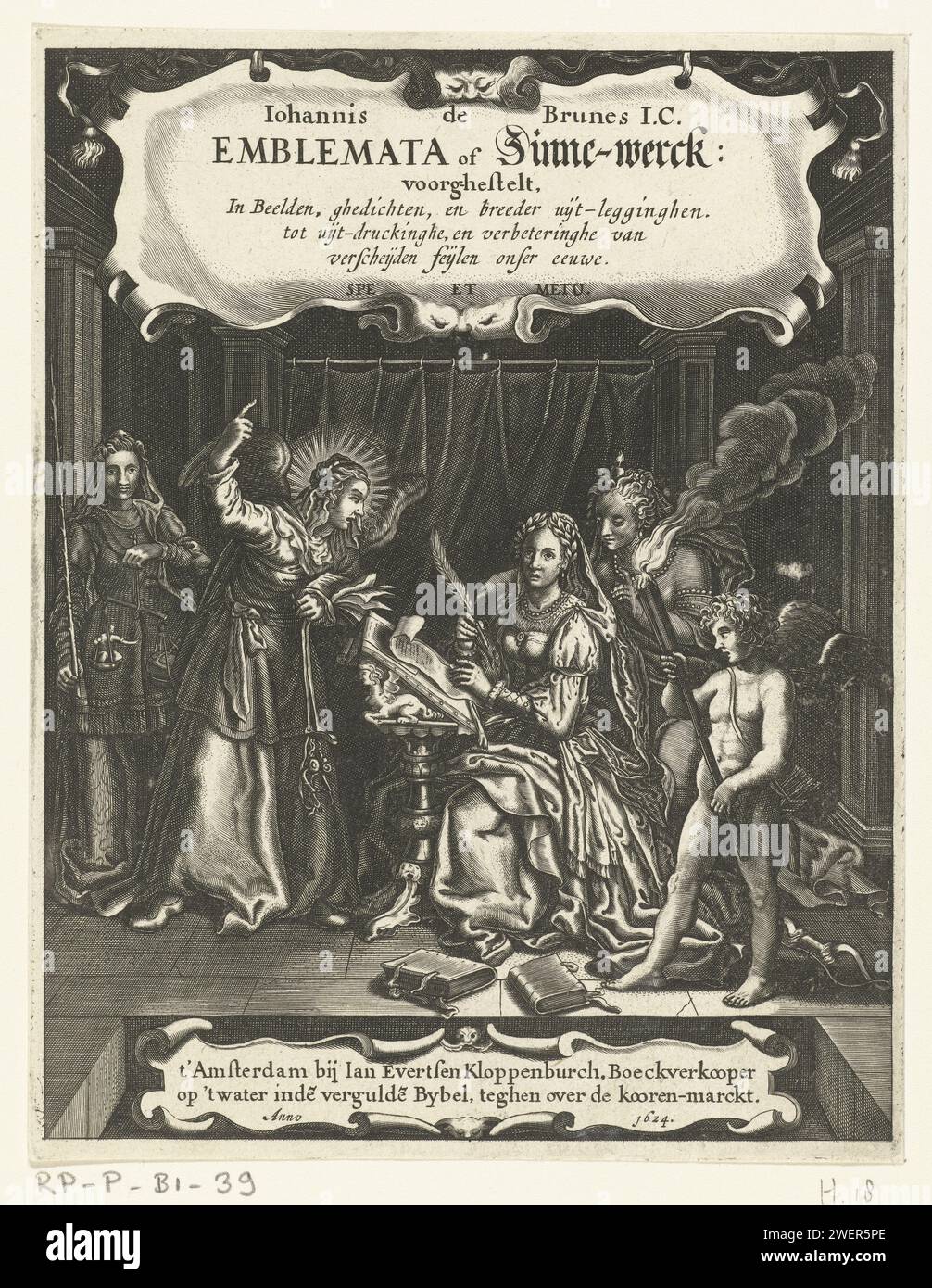 Title page for Emblemata or Zinne-Werck by Johannes de Brune, Willem Outgertsz. Akersloot, 1624 print Four women in a dark room accompanied by Amor who lit the room with a torch. One of the women is writing a desk, another looks over her shoulder. The third woman with a jet wreath around her head and wings, in her hand a book and a horse -tetoma, the sitting woman tells something excited. The fourth woman, with a palm branch and a scale, is waiting for her turn. paper engraving Abstract Ideas and Concepts (+ emblematical representation of concept). (story of) Cupid, Amor (Eros). title-page Stock Photohttps://www.alamy.com/image-license-details/?v=1https://www.alamy.com/title-page-for-emblemata-or-zinne-werck-by-johannes-de-brune-willem-outgertsz-akersloot-1624-print-four-women-in-a-dark-room-accompanied-by-amor-who-lit-the-room-with-a-torch-one-of-the-women-is-writing-a-desk-another-looks-over-her-shoulder-the-third-woman-with-a-jet-wreath-around-her-head-and-wings-in-her-hand-a-book-and-a-horse-tetoma-the-sitting-woman-tells-something-excited-the-fourth-woman-with-a-palm-branch-and-a-scale-is-waiting-for-her-turn-paper-engraving-abstract-ideas-and-concepts-emblematical-representation-of-concept-story-of-cupid-amor-eros-title-page-image594267142.html
Title page for Emblemata or Zinne-Werck by Johannes de Brune, Willem Outgertsz. Akersloot, 1624 print Four women in a dark room accompanied by Amor who lit the room with a torch. One of the women is writing a desk, another looks over her shoulder. The third woman with a jet wreath around her head and wings, in her hand a book and a horse -tetoma, the sitting woman tells something excited. The fourth woman, with a palm branch and a scale, is waiting for her turn. paper engraving Abstract Ideas and Concepts (+ emblematical representation of concept). (story of) Cupid, Amor (Eros). title-page Stock Photohttps://www.alamy.com/image-license-details/?v=1https://www.alamy.com/title-page-for-emblemata-or-zinne-werck-by-johannes-de-brune-willem-outgertsz-akersloot-1624-print-four-women-in-a-dark-room-accompanied-by-amor-who-lit-the-room-with-a-torch-one-of-the-women-is-writing-a-desk-another-looks-over-her-shoulder-the-third-woman-with-a-jet-wreath-around-her-head-and-wings-in-her-hand-a-book-and-a-horse-tetoma-the-sitting-woman-tells-something-excited-the-fourth-woman-with-a-palm-branch-and-a-scale-is-waiting-for-her-turn-paper-engraving-abstract-ideas-and-concepts-emblematical-representation-of-concept-story-of-cupid-amor-eros-title-page-image594267142.htmlRM2WER5PE–Title page for Emblemata or Zinne-Werck by Johannes de Brune, Willem Outgertsz. Akersloot, 1624 print Four women in a dark room accompanied by Amor who lit the room with a torch. One of the women is writing a desk, another looks over her shoulder. The third woman with a jet wreath around her head and wings, in her hand a book and a horse -tetoma, the sitting woman tells something excited. The fourth woman, with a palm branch and a scale, is waiting for her turn. paper engraving Abstract Ideas and Concepts (+ emblematical representation of concept). (story of) Cupid, Amor (Eros). title-page
 Emblemata with amor, church building and falling star, Anthonie de Winter, 1697 - 1718 print Twice four emblemata with Dutch text and Latin motto on a magazine. Upstairs: Emblemata with amor shooting with arrows, Amor with a heart in his hand, Amor with a torch on a pedestal and Amor with a hammer next to an anvil. Below: a church building, a snake in a tree, a falling star and a sword and a shield on a scale held by a hand. paper etching / engraving Abstract Ideas and Concepts (+ emblematical representation of concept). (story of) Cupid, Amor (Eros). church (exterior). stars Stock Photohttps://www.alamy.com/image-license-details/?v=1https://www.alamy.com/emblemata-with-amor-church-building-and-falling-star-anthonie-de-winter-1697-1718-print-twice-four-emblemata-with-dutch-text-and-latin-motto-on-a-magazine-upstairs-emblemata-with-amor-shooting-with-arrows-amor-with-a-heart-in-his-hand-amor-with-a-torch-on-a-pedestal-and-amor-with-a-hammer-next-to-an-anvil-below-a-church-building-a-snake-in-a-tree-a-falling-star-and-a-sword-and-a-shield-on-a-scale-held-by-a-hand-paper-etching-engraving-abstract-ideas-and-concepts-emblematical-representation-of-concept-story-of-cupid-amor-eros-church-exterior-stars-image594171618.html
Emblemata with amor, church building and falling star, Anthonie de Winter, 1697 - 1718 print Twice four emblemata with Dutch text and Latin motto on a magazine. Upstairs: Emblemata with amor shooting with arrows, Amor with a heart in his hand, Amor with a torch on a pedestal and Amor with a hammer next to an anvil. Below: a church building, a snake in a tree, a falling star and a sword and a shield on a scale held by a hand. paper etching / engraving Abstract Ideas and Concepts (+ emblematical representation of concept). (story of) Cupid, Amor (Eros). church (exterior). stars Stock Photohttps://www.alamy.com/image-license-details/?v=1https://www.alamy.com/emblemata-with-amor-church-building-and-falling-star-anthonie-de-winter-1697-1718-print-twice-four-emblemata-with-dutch-text-and-latin-motto-on-a-magazine-upstairs-emblemata-with-amor-shooting-with-arrows-amor-with-a-heart-in-his-hand-amor-with-a-torch-on-a-pedestal-and-amor-with-a-hammer-next-to-an-anvil-below-a-church-building-a-snake-in-a-tree-a-falling-star-and-a-sword-and-a-shield-on-a-scale-held-by-a-hand-paper-etching-engraving-abstract-ideas-and-concepts-emblematical-representation-of-concept-story-of-cupid-amor-eros-church-exterior-stars-image594171618.htmlRM2WEJRXX–Emblemata with amor, church building and falling star, Anthonie de Winter, 1697 - 1718 print Twice four emblemata with Dutch text and Latin motto on a magazine. Upstairs: Emblemata with amor shooting with arrows, Amor with a heart in his hand, Amor with a torch on a pedestal and Amor with a hammer next to an anvil. Below: a church building, a snake in a tree, a falling star and a sword and a shield on a scale held by a hand. paper etching / engraving Abstract Ideas and Concepts (+ emblematical representation of concept). (story of) Cupid, Amor (Eros). church (exterior). stars